Embassy Perimeter Improvement Concepts and Design Guidelines









First impressions are crucial in determining how the United States is perceived in the countries hosting our embassies, and US diplomatic facilities are often a foreigner’s first point of contact with our country.
Design at every level is an important tool in developing a positive image for our facilities and for delivering a successful embassy project, with a functional, attractive, and welcoming perimeter. However, embassy facilities, in recent years, have become massive, fortress-like buildings surrounded by high walls and/or fences, with forbidding entrance pavilions. Many of these site edges are additionally protected by one-meter-tall painted steel bollards and barriers. The image of such facilities does not meet the Department of State’s expectation that US diplomatic facilities abroad visibly demonstrate the openness and optimism of the American people while providing safe and secure environments for staff and visitors.
The perimeter of the embassy compound is its leading edge — portraying the first glimpse of American design and attitude while establishing and maintaining security. The presentation of our country begins with these first impressions, as visitors approach the embassy. In addition to the compound’s edge, the urban context and the streets and edges surrounding the embassy are therefore critical to public perceptions.
Representational space has typically been understood as the space (or spaces) within an embassy compound:
• Most often seen and used by visiting dignitaries
• Provided for ceremonial occasions
• Provided for annual events such as Fourth of July picnics
• Most often seen and used by the public when they arrive at the embassy compound, in particular the main entry and consular entry areas
A new way of thinking about representational space is that it begins with the first impression visitors have as they approach the embassy. The embassy perimeter and the urban context of the streets and edges surrounding the embassy thus constitute critical parts of the embassy’s setting. In the way in which they affect visitor perception, these spaces can foster respect and admiration for the US or can detract from the impression host country residents and embassy visitors have of our country.
Too often, US Embassies are designed to reflect the cultural attitudes and behavior patterns of the western world. However, many places in the world have significantly different attitudes regarding the use of public facilities by their citizens, while levels of education, literacy, and sophistication vary dramatically from one country to another.
The design of our diplomatic facilities abroad should reflect an understanding of common local customs, local public behavior patterns, and human needs, especially in the areas of the perimeter where public interface occurs. For individuals in some countries, for example, personal privacy is a key consideration when obtaining diplomatic services. Requiring visitors to line up in locations where they are visible from public streets can compromise their sense of personal privacy, and even their sense of personal safety. Whereas, in US culture, lining up for sports events, cinema access or other entertainment is commonplace, this may not be the case in other countries. Also, in some countries, embassy visitors expect to wait for long periods of time before they are admitted for business; thus, even when appointments have been made, visitors often arrive hours in advance out of fear that they will “miss their chance” for an appointment. In such cases, they often wait for hours without shelter from the weather or access to rest facilities. Given such differences among countries, behavior patterns need to be well-understood by designers in order to develop appropriate design strategies at the points of visitor contact with the embassy.
Positive public diplomacy for America begins with first impressions. For many, the introduction to our country is the arrival at our embassies.
This manual, Embassy Perimeter Improvement Concepts (EPIC), provides guidelines for improving the quality and appeal of the built environment surrounding United States diplomatic facilities abroad. In this manual, requirements are referred to as “Department of State (DOS) standards and criteria,” which include existing US Department of State, Bureau of Overseas Buildings Operations (OBO), and Diplomatic Security (DS) standards. These documents pertain to spatial, functional and security requirements, and are intended to accompany other DOS standards listed in Appendix C. The guidelines integrate existing standards with new design approaches that define how to improve the perimeter appearance of new and existing embassy compounds throughout the world.
The expected result of this manual will be the construction of embassy perimeters that project a more positive and welcoming image of the United States abroad, while still maintaining security standards and meeting the functional requirements of these facilities. As such, these guidelines will further the Department of State’s commitment to visibly demonstrate the openness and optimism of the American people through its diplomatic facilities.
In order to prepare a meaningful array of guidelines, the project team began its work with a study of four existing embassies, representing a diverse sample of United States embassies abroad. The details of this study are described in Appendix A. The study team included members of DOS, working in collaboration with a consultant design team. Participants included a multi-disciplinary group of senior professionals, including landscape architects, architects, structural and blast engineers, and diplomatic security specialists. The team surveyed


These guidelines further the Department of State’s commitment to visibly demonstrating the openness and optimism of the American people through its diplomatic facilities.
embassies abroad to gain insight into the physical and functional conditions of diplomatic facilities. In addition, interviews with media representatives, diplomatic representatives, and facilities staff provided a deeper understanding of cultural differences among the countries visited, local patterns of access to each site, customary use and perception of public space, and perceptions of welcome and privacy. The results gave the team a more comprehensive view of site user and design needs. The EPIC approach reflects this understanding.
Following the site visits, the team summarized its observations, carefully defined the problem, and presented to a larger group of Department of State officials. During a two-day workshop, the group evaluated its preliminary analyses and observations, and ‘brainstormed’ ideas for addressing the problems. The ‘brainstorming’ workshop provided an opportunity to focus on new ideas for embassy perimeters and methods for implementing them. The results of the workshop are incorporated into this report as new guidelines for both conducting a more effective design process and for creating a more beautiful and welcoming setting for US diplomatic facilities abroad.

Because OBO projects are located in a range of climates, each site is specific to its regional ecological, historical, and cultural setting.
The specific goals of the guidelines are:
• To implement designs that will represent America to the world as a welcoming and open society while maintaining appropriate security provisions
• To elevate the standard of quality in the design of diplomatic facilities
• To create a process that will dramatically improve the resulting built environments of US diplomatic facilities around the globe
• To allow designers to see varied opportunities for applying OBO criteria in creative and attractive ways
• To provide an opportunity for OBO to investigate and test new perimeter security concepts and constantly evolve its own standards
DOS projects are located in a range of climates — from the arctic to the equator, from high altitudes to sea level, and from desert to high plains to rainforest — and each site is specific to its regional ecological, historical, and cultural setting. Therefore, each site represents a new opportunity for place-making, as well as a new opportunity to demonstrate American ingenuity and sensitivity to local conditions. The diagrammatic illustrations shown in these guidelines are simply examples — there are many more ways to combine and integrate existing DOS criteria to make inviting, comfortable, and attractive places using Embassy Perimeter Improvement Concepts & Design Guidelines.


The new process and guidelines set a standard that will create:
• A welcoming atmosphere for consular and other visitors to US Diplomatic Facilities as well as for employees
• US facilities that are sensitive to local ecology
• Places that are perceived as respectful of local culture, art, and craft
In design terms, methods for accomplishing these objectives include:
• Make High Quality and Functional Spaces. Provide public spaces that are safely shared by pedestrians and vehicles. Incorporate local materials and culturally appropriate design themes into the spaces. Integrate stormwater management elements into the design.
• Reflect the Character of the Host Country. Include planting, lighting, signage and other site design elements to reinforce the sense of welcome and to incorporate familiar and contextual elements.
• Encourage Positive Cultural Exchange and Expand Representational Opportunities. On a site-specific basis, include sculptural or artistic elements that emphasize positive aspects of the local culture as well as the culture of the United States.
These goals and principles are a point of beginning for the design of embassy compound perimeters. Selection of appropriate barriers will ultimately respond to threat ratings and specific site conditions, and shall meet DOS standards.
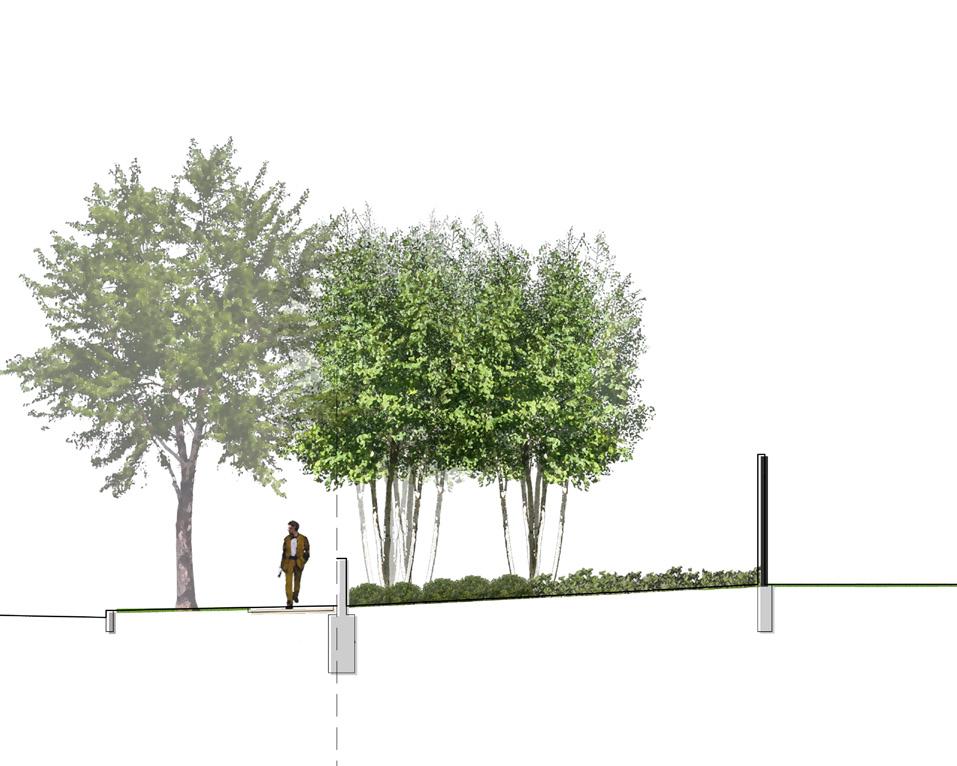

Depending on site characteristics, views into the compound from outside the perimeter may be unobstructed, limited, or blocked.
Barriers are a necessary part of security at diplomatic facilities. Barriers are used at points along or near the site property line, within the site property area, and at the transition between open spaces and buildings along the site perimeter. DOS criteria describe specific requirements for the types, heights, sizes and functions of various types of barriers and a DOS approved barrier design must be used at all embassies. Vehicular barriers, called “anti-ram” structures, deter penetration into the embassy compound by uninvited vehicles. Pedestrian barriers, called “anti-climb” structures, deter pedestrian intruders along the site perimeter. In addition, visual control is generally part of the compound perimeter. Depending on site characteristics, and with approval by DOS, views into the compound from outside the perimeter may be unobstructed, limited, or completely blocked. Various other barriers, within the property but near the perimeter, are used to create separation between vehicles and pedestrians, between embassy visitors and embassy staff, and between a variety of areas for vehicle parking. Both vehicular and pedestrian barriers may be made of a diversity of materials, and include the Entrance Pavilion buildings that are situated in various locations along the perimeter: at the main entrance to the compound, at the entrance serving consular visitors, and at the service entrance.

Although barriers cannot be entirely hidden from view, they do not need to be the dominant visible features around the site perimeter; rather, they must be coherently integrated into the overall landscape and architectural design of a site. Methods for integrating vehicular barriers and pedestrian barriers into the overall design of a site are a main component of EPIC and are explained in Chapter 3.
A rigorous analysis of threat and protection is conducted for each site by DOS. Much of this decision making occurs during the site development utilization /master planning phase of project. This manual calls for additional disciplines to be part of the process and describes a new approach to understanding the effects and consequences of design decisions and design results on public perceptions of our embassies.

Given the variation in ecological and cultural settings, each site needs to be carefully analyzed in order to develop an appropriate design approach.
The Perimeter Zone Context is the area where visitors make their first visual contact with our embassies. While the setting and context of each site varies, the Perimeter Zone Context is generally the area located immediately across the streets that abut the embassy perimeter. Specific to each setting, this context can be simply the opposite edge of the street, but is more often the fabric of the adjacent city neighborhood for a few blocks surrounding the embassy on all sides. While some sites are located within bustling urban areas, others may be located in residential areas, in more suburban areas, or even in undeveloped or newly developing exurban locations. In some cases, the context of an embassy perimeter may include undeveloped lands or a developed urban park. The urban context may also include historic sites, diplomatic facilities of other countries, and mass transit, such as overhead rail lines or bus routes.
Given the variation in ecological and cultural settings, each site needs to be analyzed carefully in order to develop an appropriate design approach for edge conditions that adequately protect the various sides of the embassy, while relating well to surrounding neighborhoods.


Main Entrance Pavilion

Service Entrance Pavilion
Consular Entrance Pavilion
The character and quality of the street experience as people walk or drive past influences their perceptions of the embassy in a manner that sets the stage for perception of the other zones.
The process of analyzing each embassy site, determining appropriate barrier types, and detailed guidelines for design of perimeter elements are described here and in Chapter 3. The zones of a typical embassy perimeter are outlined below, with general descriptions of the characteristics and requirements for each zone.
The Streetscape and immediate Site Perimeter are the first physical points of contact with our embassies, and create the connection between the surrounding urban context and the embassy. The character and quality of the street experience for pedestrians and drivers influences their perceptions of the embassy in a manner that sets the stage for perception of the other zones as well. The streetscape is the area between the embassy property line and the curb of an adjacent city or local street. It often includes an area between the property line and the perimeter barrier outside the compound. The Immediate Site Perimeter is the area between any barriers along the street and the interior of the site. The interior of the compound is generally not visible from the street, but on a sitespecific basis, limited visibility into the compound is allowed with DOS approval.
The Main Entrance is the ceremonial and diplomatic entrance to the compound. It consists of the Main Entrance Arrival Court, Official Visitor Parking, the Main Entrance Pavilion, and the New Office Building (NOB) Entrance Plaza. A limited number of official visitors use these areas. The Main Entrance is the only location where vehicle access into the secured area of the compound is provided, other than the Service Entrance. The Main Entrance Pavilion is also an entry point for representational events and is the entrance through which most embassy staff pass upon arrival to, or departure from, the site. Everyone who enters the compound through the Main Entrance Pavilion passes through security at that location. This entrance typically includes a sally-port and man-trap for vehicle and personal screening. Embassy staff, both American and locally employed staff, enter the compound through the Main Entrance Pavilion. This is the case whether staff members arrive by public transportation, have been dropped off at the site, or have left their vehicles in the staff parking lot. Staff impressions of the embassy are shared with friends and family, and become part of the ‘local lore’ of perceptions about the embassy. Therefore, adequate space, sheltered from the elements, is required to allow comfortable waiting for ride-shares, family members, or public transportation, and shall be included near the Main Entrance Pavilion.
The Consular Entrance is a key location within the Embassy perimeter because it affects public perception about the embassy and the US attitudes towards citizens of the host country.
The Main Entrance Pavilion leads to the NOB Entrance Plaza after visitors have passed through security screening. The Plaza is a generous space, befitting the dignity of the NOB. Although limited vehicular access is provided, including a drop-off area at the NOB entrance for diplomatic use, the plaza must be designed as a public space, with high quality paving, extensive plantings, and a place for the United States flag. Works of art and other amenities may also be included with DOS approval. The visual character of the space is intended to be that of an urbane public plaza, emphasizing pedestrian access. Space for vehicle parking is not included in the NOB Plaza.
Two locations for parking are provided as part of the embassy perimeter. A limited number of parking spaces are provided for Official Visitors at the Main Entrance. A dedicated parking area is generally provided for staff members within easy walking distance of the Main Entrance, where they must pass through security screening procedures daily before entering the compound. The availability and quantity of staff parking varies on a case by case basis at each embassy. Where provided, staff parking is typically on-grade, and outdoors. On a site specific basis, canopies or other protection from inclement weather may be provided. Shade trees and other plantings are an important component of design, as well as clear, accessible walkways. On a site specific basis, when space is limited, staff parking may be provided in a garage structure.
The Consular Entrance is not used for diplomatic or daily staff entry to the site, but it is a key location within the Embassy perimeter that affects public perception about the embassy and the US attitudes towards citizens of the host country. The Consular Entrance includes the Consular Arrival Court, the Consular Pavilion, and the Consular Garden. Physical comfort and a pleasant, welcoming appearance are important within this zone. Consular visitors typically wait outside the compound until they are allowed to enter the compound through the Consular Pavilion. Although this is fairly efficient, behavior patterns vary in each country, and visitors sometimes arrive earlier than needed and then wait for hours outdoors. Shelter from the elements shall be provided,
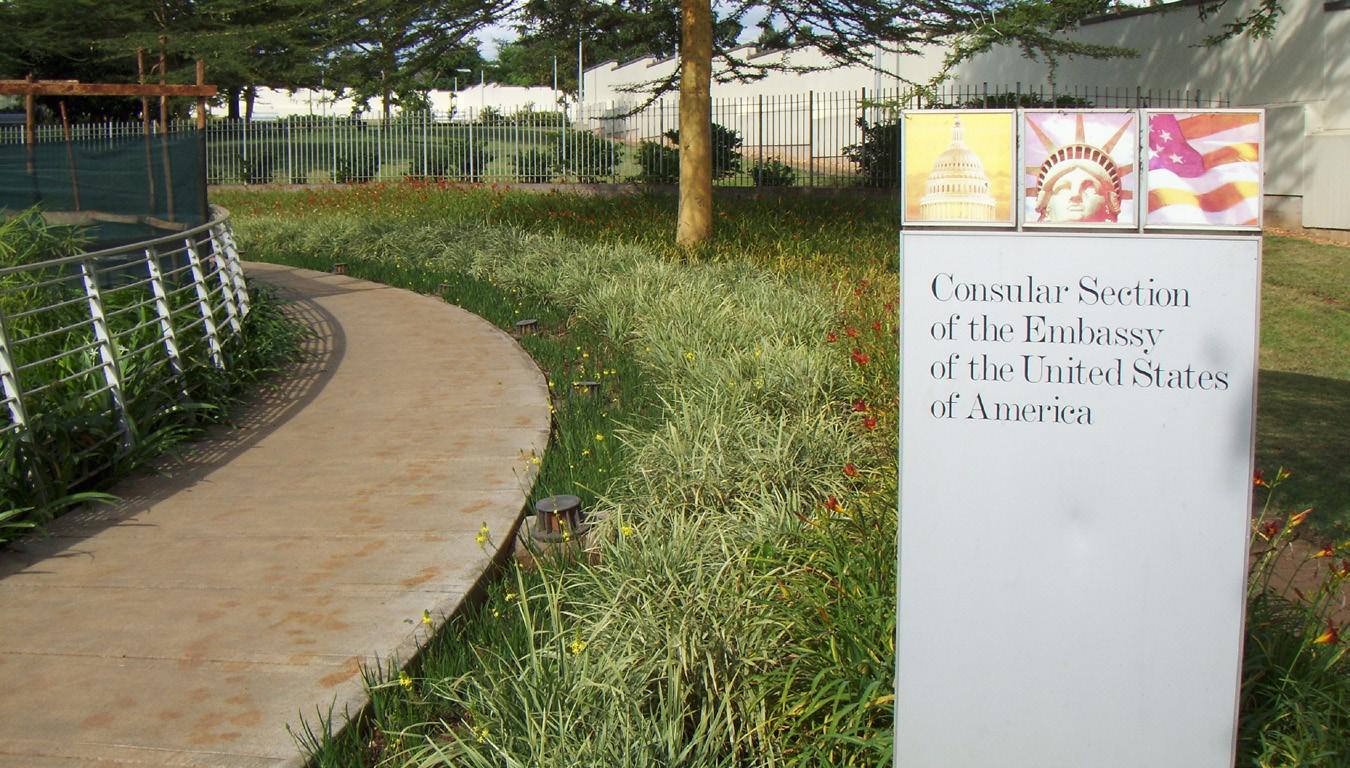
With the need for wide driveway access to handle a selected series of truck types, the service entrance provides the lifeline for the embassy.
as well as opportunities, where appropriate, for privacy from observers. Visitors entering the Consular Pavilion are screened before entering the compound. The visitors pass through the Consular Garden where they wait until they enter the Consular offices for their appointment. Therefore, shelter from the elements shall also be provided within the Consular Garden, near the Consular Section entrance.
The Service Entrance is the perimeter component that handles deliveries, trash storage and pick-up, and other maintenance and operations functions. With the need for wide driveway access to handle a selected series of truck types, this location provides the lifeline for the embassy. Though a vital functional component, it is generally not a positive attribute in the neighborhood and needs to be screened effectively, and its space used as efficiently as possible. Paved areas shall be minimized; visual buffers and plantings shall be provided. Clear pedestrian access shall be delineated from the street into the Service Area Pavilion.
Where the perimeter of the embassy compound is directly adjacent to private property or publicly owned property, other than a roadway or street, the outside face of the perimeter wall shall be set back a minimum of 2.75 meters from the property line. This offset allows the embassy to control access to the perimeter wall from the outside. Typically, if the adjacent property is privately controlled, a second control fence at the property line is required. The space between the perimeter wall and the control fence is typically not visible from the embassy compound, but must be planted or surfaced so that it is easy to maintain and does not present an unattractive image to the immediate neighbors. In some locations, where the embassy is adjacent to a public open space, other than a roadway or street, the secondary control fence is not required and the landscape treatment within the setback area needs to be compatible with the adjacent public use.

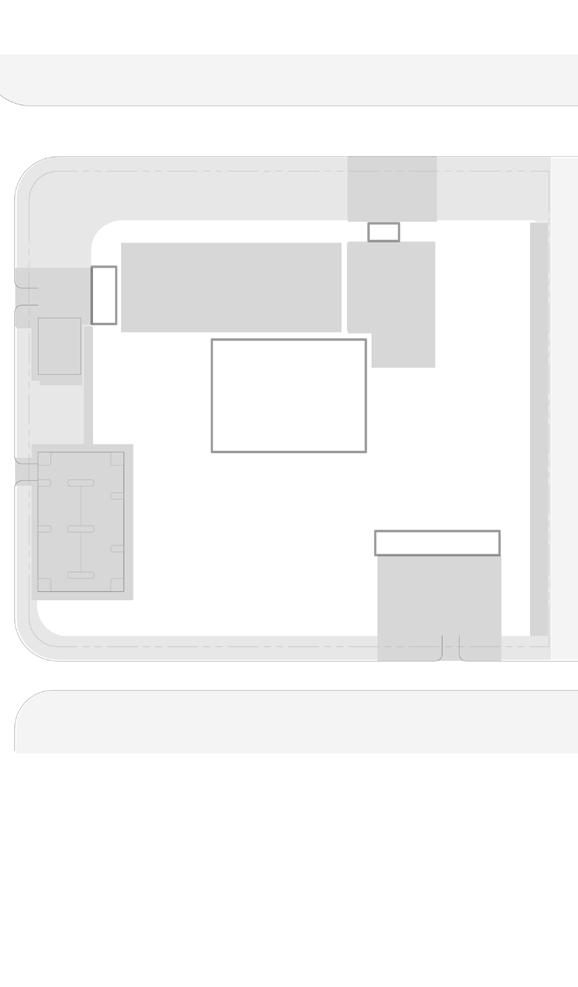
The Streetscape and Immediate site Perimeter provide the transition between the urban context of the host city and the perimeter of the embassy compound. The following requirements determine the character of the streetscape and integrate the function of the street edge with arrival at the Main Entrance. Although the guidelines for the Streetscape are closely related to the guidelines for the Main Entrance, they are highlighted separately here for clarity.
• Minimize Traffic Impacts. Analyze the adjacent street network to understand how embassy traffic will impact the surrounding vehicular routes. Create deceleration lanes or drop-off/pick-up lanes at compound entry points where required to minimize disturbances to traffic flow.
• Work with Public Transportation. Coordinate the locations of compound entry pavilions with public transportation stops to maximize convenience for pedestrians and minimize potential conflicts between public transit vehicles and embassy vehicular traffic.
• Create Pedestrian Connections. Analyze the adjacent pedestrian connections to the site, including shortest routes to public transit stops, and provide pedestrian walkways or sidewalks that link to the compound access pavilions.
• Respect the Pedestrian Zone. Provide unobstructed, public pedestrian access along all street frontages. Provide public amenities that enhance the uses within the pedestrian zone, such as seating, site furnishing, planting, water features, art and special paving areas.
• Expand Representational Space. Provide plaza or court areas adjacent to the pedestrian zone surrounding the embassy compound and at compound entry points that are accessible and/or visible to the public from outside the anti-climb barrier. Enhance the diplomatic value of these public spaces by introducing plantings, furnishings and other site elements that create a sense of welcome, reinforce environmental sustainability and demonstrate respect for local culture.
• Share the Right-of-Way. To maximize the possible setback distance, while at the same time creating public amenities, negotiate with local authorities to allow elements of the perimeter anti-ram barrier to be incorporated into the design of streetscape elements and furnishings within the public right-of-way. These may include hardened light fixtures, benches, planters, decorative bollards, etc. This approach can be implemented on a site-specific basis.
Enhance the diplomatic value of public spaces through plantings, furnishings and other site elements that create a sense of welcome and respect for local environment and culture.
• Set back Perimeter Barriers. Define representational spaces along the perimeter where the anti-ram and anti-climb barriers are designed to create representational spaces accessible and/or visible to the public from outside the anti-climb barrier.
• Separate Anti-Ram from Anti-Climb. Separate the anti-climb barriers from the anti-ram function to provide the maximum room for attractive plantings and other visual amenities; and align anti-climb walls or fences a minimum of 2.75 meters back from the anti-ram elements. Separation distance between anti-ram and anti-climb barriers is determined on a site specific basis, considering available space, local context, and DOS approval.
• Increase Transparency/Translucency. On a site-specific basis, where threat levels do not necessitate a fully opaque perimeter wall, incorporate materials into the design of the anti-climb walls and/or fences that permit views to the representational spaces inside the compound or at least allow light to pass through. Examples include glass, perforated metal or metal mesh, or ornamental metal.
• Address the Street. Locate and orient the embassy compound entry pavilions to best address and complement the adjacent street hierarchy. Design the Main Entry Pavilion and the main entry plaza spaces so that they will be clearly understood as the “main gate” of the embassy. Place the Consular Entry Pavilion in a position where it will not be confused with the Main Entry, but where it can also be seen as an important secondary gateway. The Service Entry Pavilion must be located on a street where it will not detract from the representational character of the Main or Consular entries and where its impact on the neighborhood can be mitigated.
• Create Entry Gateways. Incorporate the design of the entry pavilions into the overall architectural design of the embassy. Emphasize the significance of these relatively small structures as gateways or portals from the public space into the more private space of the embassy compound.

1. Improve the visual approach. Enhance views of the perimeter from the street and sidewalk with generous planting areas, paved pedestrian spaces and high quality architectural finishes. These features must be carefully planned to avoid “blind spots” and hiding places, and to comply with physical security requirements such as eliminating any means for climbing above and over the perimeter.
2. Design for pedestrians. Provide sidewalk spaces around the perimeter that comfortably accommodate pedestrians, street furnishings, lighting, signage, and plantings. Include street trees to shade the sidewalk areas and to help reduce heat build-up of paved areas.
3. Complement the neighborhood character. Provide street trees and street furnishings in the sidewalk area that complement the local design standards and cultural preferences.
4. Soften the edges with planting. Provide plantings between the barrier walls and the street to screen and soften their visual impact and improve the overall appearance from the street. Incorporate stormwater management or other sustainable design elements in these areas where possible.
5. Consider views into the compound. Where site conditions permit a semi-transparent perimeter fence, create opportunities for people to see into the compound from the street. Views into these areas shall be carefully controlled and shall feature significant spaces such as the entrance plaza and flag pole.
6. Define the streetscape edge. Vary the setback and alignment of the perimeter barriers to shape the edge of the streetscape and create landscaped spaces visible from the sidewalk and street.
7. Enhance the points of access. Set back barriers and entry pavilions to visually identify these points of access within the perimeter wall. Enhance these entry spaces with landscaping and amenities detail as described for Zones 2, 4 and 5. All streetscape and planting schemes shall be coordinated with security operational requirements.
Streetscape
Streetscape
ZONE 1: STREETSCAPE DESIGN GUIDELINES
Representational Space
Representational Elements
Representational Elements
Pedestrian circulation
Vehicular circulation
Special planting / sustainable design
Special planting / sustainable design
Streetscape Planting
Streetscape Planting
Special paving / hardscape elements
Special paving / hardscape elements
Special planting / sustainable design
Streetscape Planting
Special paving / hardscape elements Pedestrian
Special planting / sustainable design
Streetscape Planting
Special paving / hardscape elements
Anti-ram barrier
Anti-climb barrier (may be opaque or transparent / site-specific)
Combined anti-ram / anti-climb barrier
Planted screen
*See Zones 2–5 for details at each perimeter building


The Main Entrance to the Embassy consists of the Main Entrance Arrival Court, Official Visitor Parking, the Main Entrance Pavilion, and the NOB Entrance Plaza.
One of the most prominent and earliest images of US presence in another country is the embassy Main Entrance pavilion. Appropriately situating this building within its perimeter enclosure is a critical first step in designing the compound to fit within its surrounding context.
The paved arrival court serves many functions. It must complement the design of the Main Entry Pavilion, which will , together, function as the “main gate” to the embassy. It must be shared safely by cars and pedestrians and shall clearly designate the intended circulation system. The plaza must represent aspects of American and local culture and shall visibly integrate sustainable design elements.
• Make access to parking clear. Provide a clearly designated visitor parking area adjacent to and accessible from the arrival court. Where possible, provide separate driveways to access the visitor parking and staff parking areas.
• Create a comfortable pedestrian path. Locate visitor parking to avoid the need for pedestrians to cross driveways when walking from the visitor parking area to the Main Entry Pavilion. Minimize the distance from the visitor parking lot to the Main Entry Pavilion and provide shade to the extent possible along this route.
• Design parking to complement the Main Entrance design. Parking for official visitors is generally limited in size, typically providing between ten and twelve spaces. The design shall be complementary to the architecture and landscape design of the Main Entrance. In addition, guidelines for Zone 3, Staff Parking, pertain.
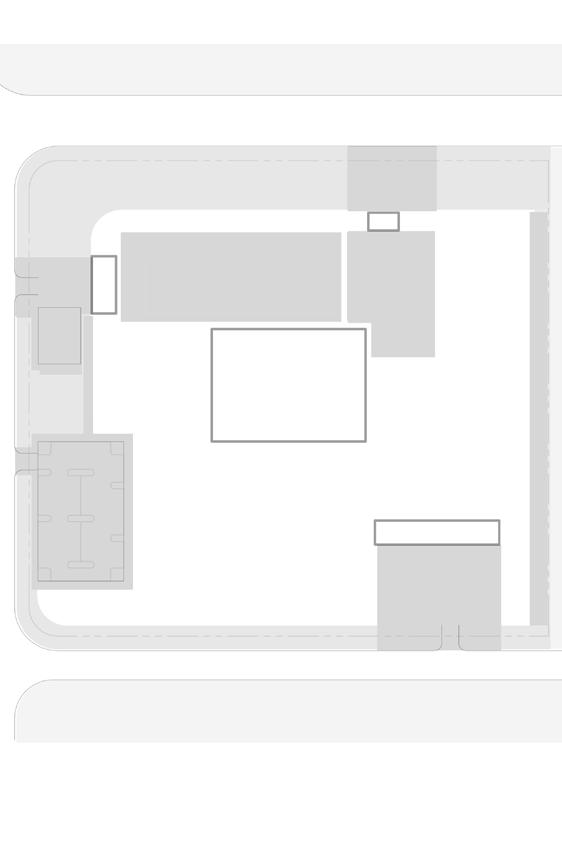
1. Make wayfinding simple. Create a clear entrance that forms a gateway in the space. Design a clear circulation system that is intuitive and easily understood to minimize the need for directional signage or striping.
2. Define the pedestrian space. The arrival court is shared by pedestrians and cars. Incorporate special paving patterns and integrate vehicle control elements to designate the primary pedestrian paths and crossings.
• Accommodate drop-off and pick-up space. Provide an area within the arrival court for drop-off or pick-up of visitors or staff. Include covered pedestrian waiting areas that are protected from weather.
• Provide turnaround area. Provide an area within the arrival court where vehicles not authorized to enter through the Main Entry Pavilion may reverse and turn around to exit.
• Calm traffic. Configure the arrival court to slow traffic, and incorporate plantings, signage and other landscape elements to eliminate high speed approaches to the sally port.
3. Create a portal or gateway to the Embassy. Conceal mantraps and sally ports and minimize the height of the pavilion to relate to the scale of local street character.
4. Make high quality spaces. Provide a paved plaza that is safely shared by pedestrians and vehicles. Incorporate local materials, porous paving, and culturally appropriate design themes.
• Provide welcoming signage in accordance with OBO standards. Provide shade trees or shade structures, to meet OBO Code Supplements requirements and to respond to local climate.
5. Minimize paving. Accommodate only the minimum required number of standard and accessible parking spaces and, where appropriate, maximize the number of compact spaces.
• Make use of double loaded drive aisles wherever possible. Shade the parking with shade trees or shade structures, as required and as appropriate to the local climate. Stagger tree alignments to maximize the apparent density of planting when viewed from the street.
• Manage stormwater runoff. Where site conditions permit, incorporate permeable paving, and/or direct surface runoff from paved surfaces into bioretention or infiltration basins, or collect it in cisterns or constructed wetlands where it can be reused for irrigation.
6. Separate anti-ram from anti-climb barriers where space permits.
7. Where space is limited, combine anti-ram and anti-climb. Provide transparency and views into the compound on a site-specific basis as approved by DOS.
8. Screen cars from view. Provide planting and/or a low wall along the edge of the visitor parking area to screen views of the parked cars from the street. A minimum of 900 mm height of the cars shall be screened.
ZONE 2: MAIN ARRIVAL COURT DESIGN GUIDELINES
Circulation
Intersection
Special planting / sustainable design
Special paving / hardscape elements
Informational signage
Representational Elements
Representational Elements
Representational Elements
Representational Elements
Special planting / sustainable design
Special planting / sustainable design
Special planting / sustainable design
Special paving / hardscape elements
Special paving / hardscape elements
Special paving / hardscape elements
Informational signage
Informational signage
Informational signage
Anti-ram barrier
Anti-climb barrier
Vehicle control
Planted screen
Combined anti-ram / anti-climb barrier
Incorporate representational elements to create an inviting plaza compatible with the architectural design of the NOB.
1. Establish the pedestrian as the primary user. Create a safe, comfortable pedestrian plaza to the NOB Entry.
2. Create a drop-off / pick-up area. Provide space for vehicles to drop-off or pick-up passengers in front of the NOB and circulate back to the Main Entry Pavilion or compound.
3. Locate a flag pole per DOS criteria, including a setting created to maximize its prominence.
4. Create an inviting plaza. Incorporate special paving, planting, lighting and artworks to create an inviting plaza compatible with the architectural design of the NOB.
5. Design anti-climb barrier to reflect the architectural design of the NOB. Make the barrier transparent to allow views into the plaza where possible.
6. Provide vehicular control elements to guide traffic. Minimize the size, number and visual impact of these elements.

ZONE 2: NOB ENTRANCE PLAZA DESIGN GUIDELINES
Limited
Limited
Intersection
Flag pole
Canopy
Special planting / sustainable design
Special paving per OBO criteria; trees, artworks, addtional plantings / hardscape elements
Flag pole
Special planting / sustainable design
Special planting / sustainable design
Special planting / sustainable design
Special
Special paving per OBO criteria; trees, artworks, addtional plantings / hardscape elements
Special paving per OBO criteria; trees, artworks, addtional plantings /
Anti-climb barrier
Vehicle control

• Official Visitor Parking. Official Visitor Parking is described in Zone 2, Main Entrance Design Guidelines. Design guidelines for Staff Parking also pertain to Official Visitor Parking.
• Staff Parking. The staff parking is typically one of the largest concentrations of paving associated with the embassy, and requires integrated design solutions to mitigate its visual and environmental impacts. A carefully designed parking area can have a positive impact on the public streetscape and the overall impression of the embassy.
1. Make the entry clear. Clearly identify the staff parking entrance and provide adequate space for cars to queue up and stop at the access control gate without blocking street traffic or pedestrian traffic.
2. Accommodate pedestrians. Provide a clearly designated walkway between the parking area and the Main Entry Pavilion. Provide a pedestrian gate in the parking enclosure fence conveniently located along this route. Provide shade with trees or, on a site specific basis, protection from the elements with covered walks.
3. Integrate the parking enclosure. Include the required staff parking enclosure in the overall perimeter streetscape design. Fences, gates, and guard shelters designed for the parking enclosure must complement the design of the embassy perimeter barriers and entry pavilions.
4. Accommodate local driving regulations and driving direction.
5. Accommodate bicyclists. Provide bicycle racks that complement the overall site furniture systems within the staff parking enclosure near the pedestrian gate and walkway.
6. Maximize parking efficiency. Minimize impervious surfaces, and incorporate stormwater management and shade structures or trees.
7. Incorporate the staff parking enclosure into the overall perimeter design. Provide planting to screen the parking area from the street. Provide evergreen shrubs or densely branched plantings along edges of the parking areas that face public streets to screen the lower 900mm of the cars from view.
Street 5 6
8. Make anti-climb barrier adjacent to the pedestrian approach transparent where possible. Allow views into the representational areas of the site.
Special planting / permeable paving / sustainable design
Special paving / hardscape elements
Transportation amenity (bicycle racks)
Special planting / permeable paving / sustainable design
Special paving / hardscape elements
Special planting / permeable paving / sustainable design
Special planting / permeable paving sustainable design
Transportation amenity (bicycle racks)
Special paving / hardscape elements
Special paving / hardscape elements
Anti-ram barrier
Transportation amenity (bicycle racks)
Parking area fence (2.1m height)
Vehicle control
Planted screen
Combined anti-ram / anti-climb barrier
Pedestrian gate
1. Avoid crossing driveways where possible. Provide a safe, comfortable pedestrian route from all levels of the parking structure to the Main Entry Pavilion.
2. Provide two-way vehicular entry and circulation in the parking structure.
3. Provide welcoming/informational signage to identify the staff parking entrance and to give other wayfinding information.
4. Provide bicycle racks within the parking structure.
5. Provide a guard booth or shelter appropriate to local climate. Add a drop bar or gate as required to control access to the staff parking structure. Provide additional vehicle inspection areas or access control as required to meet specific site conditions.
6. Provide bollards, curbs or other vehicle barriers to separate vehicular and pedestrian circulation routes.

ZONE 3: STAFF PARKING GARAGE DESIGN
Special
Transportation amenity (bicycle racks)
Streetscape planting
Vehicle control
Planted screen or special architectural treatment
Guard booth / drop bar or gate

The consular arrival sequence is a passage from the public realm to a semi-public arrival and waiting area and from there into the interior realm of the embassy compound. The consular arrival sequence includes the Consular Arrival Court and the Consular Garden.
This semi-public courtyard, separated from the public street by a landscaped buffer or fence, is intended to make consular visitors feel welcome, comfortable and safe while they wait to pass through the Consular Entrance Pavilion and enter the embassy compound. The size of the Consular Arrival Court is dependent on the number of anticipated consular applicants, the amount of time applicants are expected to be kept waiting outside the Consular Entrance Pavilion*, and the amount of space available between the sidewalk and the pavilion. General amenities are described below and detailed locations are shown in the diagrams that follow.
*Consular applicant waiting time is dependent on several factors: hours of operation of the consular facilities; number of applicants; public transit and local travel times; local customs with regard to arriving early or late for appointments.
• Create a Buffer. Create a buffer or screen between the (public) sidewalk and the (semi-public) entry plaza that offers consular applicants some level of visual and physical separation. The degree of separation required shall be determined based on local conditions and culture. Provide plantings or screening elements to create a level of semi-privacy and sense of safety for people waiting outside the consular pavilion that is appropriate to the local culture and customs.
• Integrate Anti-ram Barriers. Integrate barrier elements into the sidewalk buffer design, i.e. planters, furnishing, lighting, art, grade changes, shade structures, etc.
• Provide Enclosure. On a site-specific basis, provide a lockable, gated enclosure around the Consular Arrival Court that can be secured during non-business hours. The design of the enclosure shall be architecturally compatible with other perimeter elements and integrated with the sidewalk buffer. It shall be made so that, when open, it does not negatively interfere with the sense of welcome.
ZONE 4: CONSULAR ARRIVAL COURT DESIGN GUIDELINES
• Provide Signage. Provide clear, friendly, and informational signage near the point of entry to the Arrival Court. Signage shall be designed as part of an overall signage program and shall be either a free-standing pylon or kiosk, or integrated with other design elements such as shade structures or enclosure fencing.
At the Consular Entrance, pedestrian movement, services, security screening, and waiting areas must be attractive, comfortable, and welcoming. This area is often the most active site along the embassy perimeter.
• Establish Web-Based Information Distribution. Provide information on the local embassy website or other appropriate online sites to assist consular applicants in negotiating the application process. Include information about what to expect when arriving at the embassy/consulate such as hours of operation, recommended arrival times, expected wait times, materials to bring, materials not allowed, etc. This information would be provided by the individual post.
• Create Shelter. Provide a canopy structure in the Consular Arrival Court to shelter applicants from sun, rain and other local adverse weather conditions while waiting to enter the Consular Entrance Pavilion. The canopy shall be architecturally complementary to the Consular Entrance Pavilion and shall be sized to accommodate the number of standing applicants anticipated during peak flow periods.
• Integrate Seating. Provide seating under or adjacent to the canopy structure. Seating shall include benches, seat walls and/ or seating integrated with perimeter barrier elements and shall be located where it will be shaded by the canopy and/or trees. The number of seats shall be determined on a case by case basis.
• Set back Barriers. Step, angle or curve the anti-climb wall or fence near the consular entry pavilion to allow views of the building and pedestrian court from the street.
• Allow Visual Connections. Create views into the representational spaces within the compound from the Consular Arrival Plaza through use of transparent/semi-transparent anti-climb fence designs.
• Maintain Physical Separation. Where open picket fencing is used to create transparency, provide landscape elements on both sides of the fence to avoid the possibility of passing materials through the fence, into the Consular Garden.

1. Set the Consular Entrance Pavilion back to create a clearly defined and inviting entry space.
2. Provide a vehicular drop-off / pick-up lane away from street traffic when needed, or if local regulations require it.
3. Create a semi-public waiting area. Include special paving, plantings, shade trees and other amenities.
4. Set anti-ram barriers back where possible. Provide plantings and other public amenities.
5. Provide a canopy for shade and shelter from the elements.
ZONE 4: CONSULAR ARRIVAL COURT DESIGN GUIDELINES
Consular Entrance at
Consular Arrival Court Circulation & Representational Elements
Consular New
Pedestrian circulation
Vehicular circulation
Canopy / shelter
Consular Arrival Court Barriers Consular
Welcoming / informational signage
Special planting / sustainable design
Special paving / hardscape elements
Bike racks
Anti-ram barrier
Anti-climb barrier (fence)
Anti-climb barrier (wall)
Planted screen
Consular Garden Enclosure
Consular Entrance
Consular Garden Enclosure Consular
Special planting / sustainable design
Special planting / sustainable design
Special paving / hardscape elements
Special paving / hardscape elements
Bike racks
Bike racks
Anti-ram barrier
Anti-ram barrier
Anti-climb barrier (fence)
Anti-climb barrier (fence)
Anti-climb barrier (wall)
Anti-climb barrier (wall)
Planted screen
Planted screen
Consular Garden Enclosure

The Consular Garden must be a safe, comfortable space for visa applicants to wait. Visitors shall be discouraged from roaming into other areas of the Embassy compound, while not feeling excessively contained. The Consular Garden shall be designed with the following considerations.
• Maintain Continuity. Continue the paving materials used in the paved pedestrian court outside the Consular Entrance Pavilion into the consular garden to create pedestrian walkways and seating areas.
• Develop a Garden Space. Planting within the consular garden shall be designed to reflect the local cultural traditions and climatic conditions. Include plants that are well adapted to the site and that provide interest in all seasons.
• Make Opportunities for Art. Where opportunities exist, include sculptural or artistic elements within the consular garden that encourage a positive cultural exchange.
• Integrate Signage. Provide clear, friendly, and informational signage near the point of entry to the Consular Garden. Signage shall be designed as part of an overall signage program and shall be either a free-standing pylon or kiosk, or integrated with other design elements such as shade structures or enclosure fencing.
• Keep Circulation Simple. Design the Consular Garden so that there is a clear and intuitive procession from the entry pavilion to the NOB consular entrance to minimize the need for extraneous signage.
• Provide Assistance. Post shall provide trained staff and security personnel to offer information and assistance to consular visitors.
ZONE 4: CONSULAR GARDEN DESIGN GUIDELINES
Visitors need to be discouraged from roaming into other areas of the Embassy compound, while not feeling as if they are excessively contained.
• Make Walkways Comfortable. Locate the Consular Entrance Pavilion in relation to the Consular Entrance to avoid the need for applicants to walk long distances from one to the other. Provide shade trees or, on a site-specific basis, covered walkways between the Consular Entrance Pavilion and the Consular Entrance. Maintain grades on walkways that meet ADA standards and avoid using stairs within the Consular Garden.
• Define the Edge. Provide an enclosure to discourage applicants from walking beyond the edge of the Consular Garden, yet avoiding the appearance of a cage. Maintain views from the garden into other representational spaces, and screen views from the garden into other semi-private or service oriented spaces. Refer to OBO Supplementary Zoning Code for type and height of enclosure.
• Provide Shade, Shelter and Seating. Design a canopy structure within the Consular Garden to provide weather protection and a place for applicants to sit while waiting to enter the consular area of the NOB. The size of the shelter and number of seats required shall be based on the anticipated number of applicants. The location of the shelter must be close to the building entrance and the arrangement of seating shall allow for applicants to see the entry door while they wait.
• Provide a Drinking Fountain. Include an exterior drinking fountain, appropriate to climatic conditions, in a location near the Consular Garden shelter.

1. Provide a pedestrian connection between the NOB main entry and the Consular Entrance Pavilion passback window for embassy staff. The path shall be separate from the Consular Garden.
2. Provide informational and directional signage near the Entry Pavilion along the primary walkway.
3. Provide access to the covered waiting area from the primary pedestrian path.
4. Make pedestrian circulation from the Consular Entrance Pavilion to the NOB Consular Entrance clear and simple. Locate buildings to minimize the walking distance and provide shade. If weather conditions necessitate, provide shelter along the primary path.
5. Continue Arrival Plaza paving into the Consular Garden.
6. Provide a drinking fountain. Provide access to toilets in close proximity to the covered waiting area on a site-specific basis.
7. Provide an overhead shelter appropriate to the compound architecture that creates effective weather protection for the local conditions.
8. Design the Consular Garden to incorporate native plant materials. Reflect local traditions, with consideration for maintenance, comfort and public safety.
9. Separate the garden with a low enclosure in accordance with DOS standards: Supplemental to the International Zoning Code (IZC) Chapter 6).
ZONE 4: CONSULAR GARDEN DESIGN GUIDELINES
Consular
Consular
Special planting / sustainable design
Special paving / hardscape elements
Food / drink vendor service area (site-specific)
Pedestrian
Pedestrian
Anti-climb barrier (fence)
Special
Special
Food
Special
Special
Food
Anti-climb
Anti-climb barrier (wall)
Planted screen
Welcoming / informational signage
design
Vehicular
Vehicular circulation
Canopy
Welcoming / informational signage
Consular Garden enclosure (See 12C, Chapter 6 for requirements)
Pedestrian Gate
Pedestrian Gate

The service area is primarily a utilitarian space. Its large expanse of paving, needed to accommodate service vehicles and heavy service equipment, can have a negative effect on perception of the embassy from the surrounding neighborhood. This can be alleviated by first, locating the service area to reduce visual presence on the street, and, second, by screening views as much as possible from the neighborhood into the court. An effective method for screening and softening the view of the paving and service functions is to provide a combination of fencing or walls, and planting along edges that face the street.
The functional aspects of servicing the post must be carefully balanced with security and with the need to relate to a public, often pedestrian-oriented, environment nearby. The creation of a ‘Service Court’, visually and acoustically separated from the public, is an important consideration during the initial site design and operations planning. Minimizing the view of the paved service apron from the street, and providing a sense of enclosure by using the required program elements, wall, and fence types and planted elements will help mitigate the effect of this large area, often located directly adjacent to a public thoroughfare.
Often there is little choice of location for the compound service court. Many embassy sites are within smaller scale residential neighborhoods, and care shall be taken to design the entrance pavilion in consideration of the scale of its surroundings. The goal for this pavilion is to create a functional service portal, convenient for operations, but also to minimize intrusion into the surrounding neighborhood.
The functional aspects of servicing the post must be carefully balanced with security and with the need to relate to a public, often pedestrian, environment nearby.
Other design requirements include the following:
• Accommodate Pedestrians. Provide a pedestrian connection from the public sidewalk to the Service Entry Pavilion.
• Accommodate Delivery and Service Vehicles. Provide a paved service court within the embassy property in front of the Service Entry Pavilion, large enough to permit anticipated delivery trucks and service vehicles to enter forward, back up to the necessary loading dock, fuel port or other service space and exit in a forward position. Vehicle maneuvers must not require vehicles to back into or out of the service driveway or to use the public street to make necessary turns.
• Minimize Driveway Width. The width of the driveway that opens to the public street shall not exceed seven meters. If additional space is required to make necessary vehicular maneuvers, a second driveway of the same or lesser width, separated by a planted island, may be added.
• Filter Views from the Public Street. Provide a fence and/or dense plantings along the edges of the service court that front the public streets to screen views of the paved service court. The height of the plantings shall be 1200 mm minimum and shall be evergreen or densely branching to make an effective year-round screen.
• Shade the Paving. Provide trees adjacent to the paved service court to shade as much of the paved area as possible. Align trees to avoid possible damage from vehicles. ZONE 5:
1. Create a Service Court screened from street view and internal embassy views.
2. Accommodate the required turning movements within the Service Court.
3. Minimize the width of the driveway but provide for required vehicle turning access.
4. Maintain visibility between drivers and pedestrians at the sidewalk intersection.
5. Incorporate special plantings and / or cultural elements to reduce visual impact on the surrounding neighborhood.
6. Maintain visibility between drivers and pedestrians at the sidewalk intersection.
7. Provide trees to shade pedestrian circulation. Avoid locations where vehicles may damage trees.
8. Provide a fence and/or plantings to visibly buffer the service yard.

ZONE 5: SERVICE ENTRANCE DESIGN GUIDELINES
Special
Representational Elements
Representational Elements
Special
Planted screen with shade trees
Screen fence
Combined anti-ram / anti-climb



Special planting/ sustainable design
Anti-climb / anti-ram (wall)
Property line fence
An offset between adjacent properties and the Embassy compound allows control of access in this zone. Surfaces must be easy to maintain. An area along which guards can easily walk is also required.
1. Create perimeter setback. Locate the perimeter anti-ram/anticlimb wall a minimum of 2.75m from the property line.
2. Control access. Provide a continuous enclosure to control access to the perimeter wall setback area. This may be a combination of new fences and existing walls or fences; the fence type and height must meet criteria established for each location and must include gates to control access to the setback area.
3. Minimize maintenance. The space between the perimeter wall and the control fence is typically not visible from the embassy compound, but must be planted or surfaced so that it is easy to maintain and does not present an unattractive image to the immediate neighbors. Low plantings or gravel surfaces are acceptable treatment options.
4. Incorporate stormwater management. Integrate surface and/or subsurface stormwater management into the setback area.
ZONE 6:
ADJACENT PROPERTIES DESIGN GUIDELINES
Make


Planted area or park
Anti-climb / anti-ram (wall)
5. Make the edge visually compatible. Incorporate planting and surfacing treatments within the perimeter setback area that are complementary to the adjacent public use and that do not impede the embassy’s ability to control access to the perimeter wall.
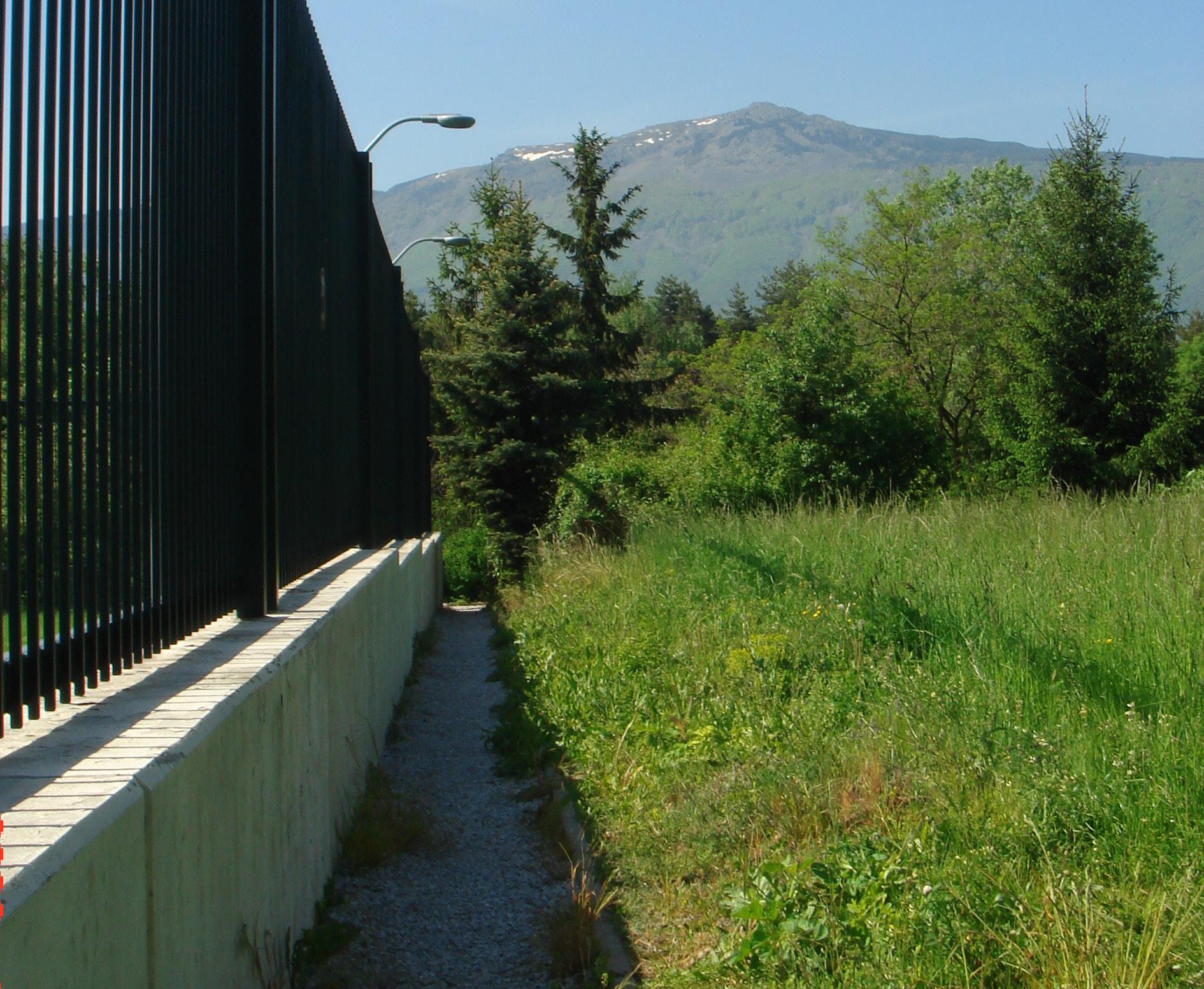

BARRIER
This chapter outlines the process for designing embassy perimeters that project a more positive image of the United States, demonstrating an open attitude toward local customs and culture and to the neighborhoods that surround US embassies. The site analysis process is addressed first, while subsequent sections describe design options for vehicular and pedestrian barriers, and other design considerations (including planting and hard landscape, representational elements, and sustainability). A final section outlines the process of developing and refining designs. Throughout the process and implementation of designing embassy perimeters, DOS standard criteria define security requirements in detail and are the basis for all perimeter design.
• Vegetation / Hydrology / Soils
• Traffic Patterns / Transportation
• Neighborhood Context
• Adjacent Conditions
BARRIER
• Nearby Transit Stops / Shelter
• Site Access
• Perceived Safety
• Perimeter Design Checklist
• Overall Protective Design Strategy
• Vehicular Circulation / Approach Distance / Speed
• Traffic Patterns and Speed Limits
• Pedestrian Circulation and Access Points
• DOS Design Standards
• Vehicular Barriers / Anti-Ram
• Pedestrian Barriers / Anti-Climb
• Transitions Between Barriers
• Barrier Type and Materials
• DOS Design Standards
• Visual Perception / Transparency Opacity / Visual Screening
• Spatial Organization
• Softscape
• Native / Naturalized Plantings
• Shade Trees / Gardens
• Hardscape
• Steps / Paths / Furniture
• Lighting
• Rain and Sun Shelters
• Public Space-Making and Amenities
• Welcoming Wayfinding and Informational Signage
• Local Culture, Craft, Antiquity and Art
• Water-Sensitive Design
• Earthwork / Retaining Walls
• Porous Pavement
• Lighting / Energy Use
• Material Durability / Maintenance LANDSCAPE
DEVELOP AND REFINE
The site design team must be multidisciplinary in composition, including representatives of real estate professionals, engineers, architects and landscape architects.
Typically, a design team is brought to a site after the site has been selected and purchased. The site design team must be multidisciplinary in composition, including representatives of related professions: real estate professionals, engineers, security specialists, architects and landscape architects. In some cases, other specialists familiar with local ecology, stormwater management, urban arboriculture, and weather management practices may be required. Because each discipline considers different design determinants, a team approach will result in more appropriate perimeter design that is informed by both a clearer understanding of design requirements and sensitivity to context and local custom.
Specifics of site analysis are indicated on the Embassy Perimeter Design Checklist (Chapter 4). This analysis references DOS standard criteria and is a tool that is also applicable to the design of many types of public, campus-like facilities. Risk and threat analyses, and determination of appropriate protective security measures, are distinguishing features of embassy design and are therefore explained in greater detail here.
The anti-ram perimeter of an embassy compound is a critical component of the overall protective design strategy. US diplomatic facilities are at risk from Vehicle Borne Improvised Explosive Devices (VBIEDs), as demonstrated by bombings of embassy compounds globally in recent years. Because the explosive force generated by VBIEDs is catastrophic at short setback distances, unsecured vehicles shall be kept as far as possible from regularly occupied buildings. Anti-ram elements establish a minimum setback distance between unsecured vehicles and occupied buildings in order to reduce the explosive force on the buildings to manageable levels for design. The minimum setback distance to regularly occupied buildings for new embassy construction, including office and housing, is currently 30 meters as specified in DOS’ OBOInternational Code Supplement (ICS) documents (OBO-ICS). For DOS, setback is defined as the distance from the protected side of the anti-ram barrier to the closest exterior surface of the building.
The required level of anti-ram resistance should be determined through multidisciplinary assessment of the project site, location of protected buildings on the site, surrounding streets and adjacent properties.
The required level of anti-ram resistance for a given site shall be determined through the multidisciplinary assessment of the project site, the location of protected buildings on the site, the surrounding streets and the adjacent properties. The main components of the assessment should include:
• Identification of all potential vehicle approaches
• Determination of vehicle impact speed and angle of impact for each approach path
• Occupancy of adjacent properties
• Location of vehicle access points
• Availability of natural vehicle barriers
• Determination of potential setback distances
• Expectations for future site development
This information is used by the design team and DOS to establish the required crash rating at each perimeter location, with a goal of minimizing the size and improving the visual appearance of anti-ram elements where possible, while in all cases still complying with the anti-ram and setback requirements.
A technical description of the steps involved in performing this assessment is provided in Appendix B. Once the anti-ram requirements are established, specific DOS approved barriers may be incorporated into the site perimeter design. Approved fixed barriers are provided in the OBO-ICS to the International Zoning Code (IZC), Appendix A, Security Details for Site Construction, and a current list of approved operable barriers is maintained and available upon request from DOS.
Barriers used to protect US embassies must be tested to establish their performance with regards to three parameters: attack vehicle weight, attack vehicle speed and barrier penetration.
The anti-ram resistance of a barrier is generally categorized according to three parameters:
• Attack Vehicle Weight
• Attack Vehicle Speed
• Barrier Penetration
Vehicle weight and speed combine to define the kinetic energy that a barrier must resist. Barrier penetration defines the distance a VBIED can break through or penetrate a barrier. Greater penetration distances reduce the setback distance between the VBIED and the protected buildings. Barriers used to protect US embassies must be tested to establish their performance with regards to these three parameters.
The required level of performance is indicated in the OBO-ICS documents. The attack vehicle speed may be determined by a site-specific study. Test methods and certification standards for anti-ram barriers are specified in documents, listed in Appendix B.
By considering site geometry and/or manipulating site design geometry on a project-specific basis, visual appeal can be improved while maintaining the required level of protection.
Anti-ram barriers capable of resisting high speed attacks with minimal penetration are often the best solution. However, such a high level of resistance requires large, heavy barriers that may be visually intrusive and costly. Certain site conditions and/or site layouts may reduce the maximum potential attack speed or make greater vehicle penetration distances acceptable. By considering site geometry and/or manipulating site design geometry, visual appeal can be improved while maintaining the required level of protection.
Additional design considerations may be beneficial in the development of the anti-ram perimeter, including:
• Slower attack vehicle impact speeds
• Increased penetration distance
• Obstacles and gentle deterrents
Barrier designs not currently in DOS standards require testing and approval by DOS, but may allow for the use of shorter, lighter barriers where appropriate and acceptable.
850 mm tall concrete knee wall recently tested for 50 km/h impact — reduced height for reduced impact speed



• Hardened Street Furniture. Streetlights, benches, shelters, bike racks, newsstands, kiosks and other street furniture may also be incorporated into DOS-rated anti-ram barriers to mitigate their protective appearance and to provide public amenities within the pedestrian zone. This solution may be applied at locations where a grouping of street furniture would complement public uses, such as at a transit stop or in a public plaza. The solution may be integrated with other anti-ram devices and must function as part of a continuous series of elements along an entire site perimeter.
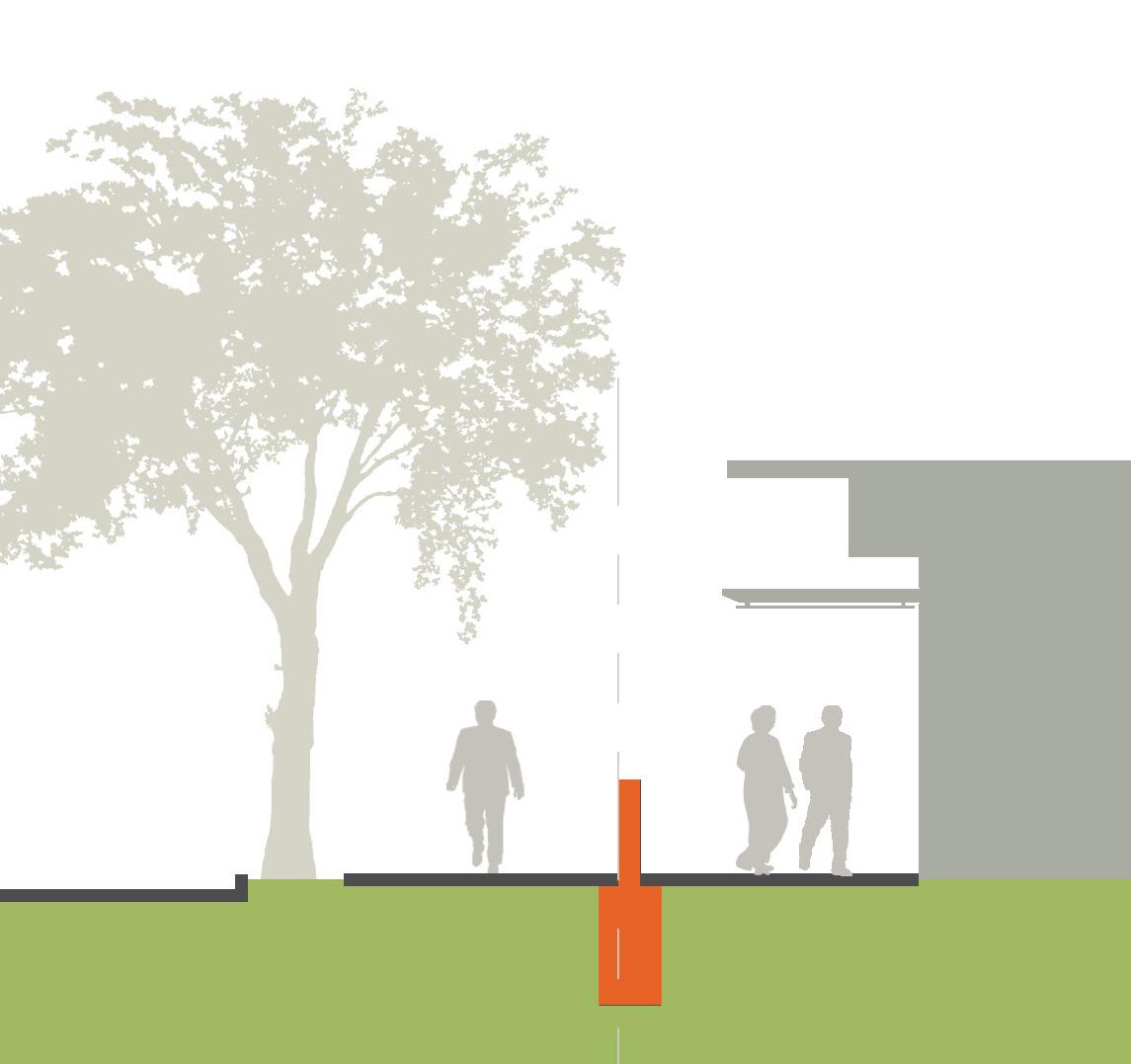

bollards.

Shelter with reinforced posts
Bench with reinforced legs
Kiosk with reinforced base

Where even more setback distance is available, the buffer planting can include shade trees and the canopy structure can be made larger to accommodate more people.
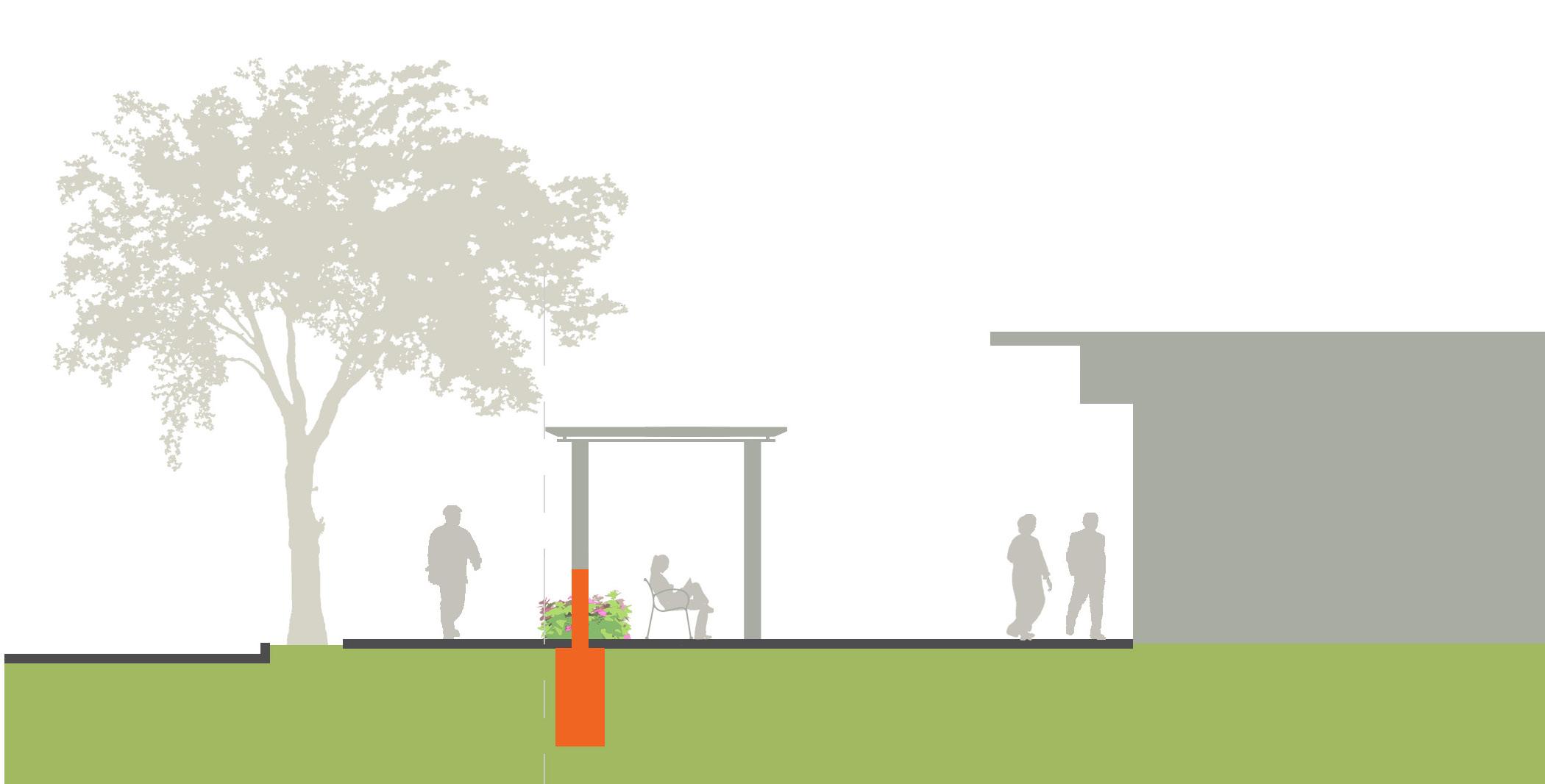
Where more pedestrian space is needed, such as the Consular Arrival Court, the anti-ram barrier can be incorporated into a free-standing canopy with low plantings that provide a buffer to the public sidewalk
Bench with collapsible support bracket
Anti-ram / retaining wall

Berm with planting: Refer to Appendix C for more detail on berm requirements.
• Retaining Walls / Freestanding Walls. There are many ways the DOS anti-ram knee wall can be adapted to fit into the public streetscape. In locations where a natural grade difference exists between the perimeter edge and the pedestrian zone, the knee wall can also serve as a retaining wall and its visual impact can be diminished with required stone cladding and plantings. It may also be possible to create earth berms behind the knee wall to create a similar effect. The wall may be further adapted for public benefit by adding seating elements; however, the seating must be engineered so that it does not enable vehicles to drive over the wall. Similarly, freestanding anti-ram knee walls may be designed to incorporate seating or signage that can serve as useful and attractive amenities in the pedestrian zone. Wall heights shall be in accordance with DOS standards.
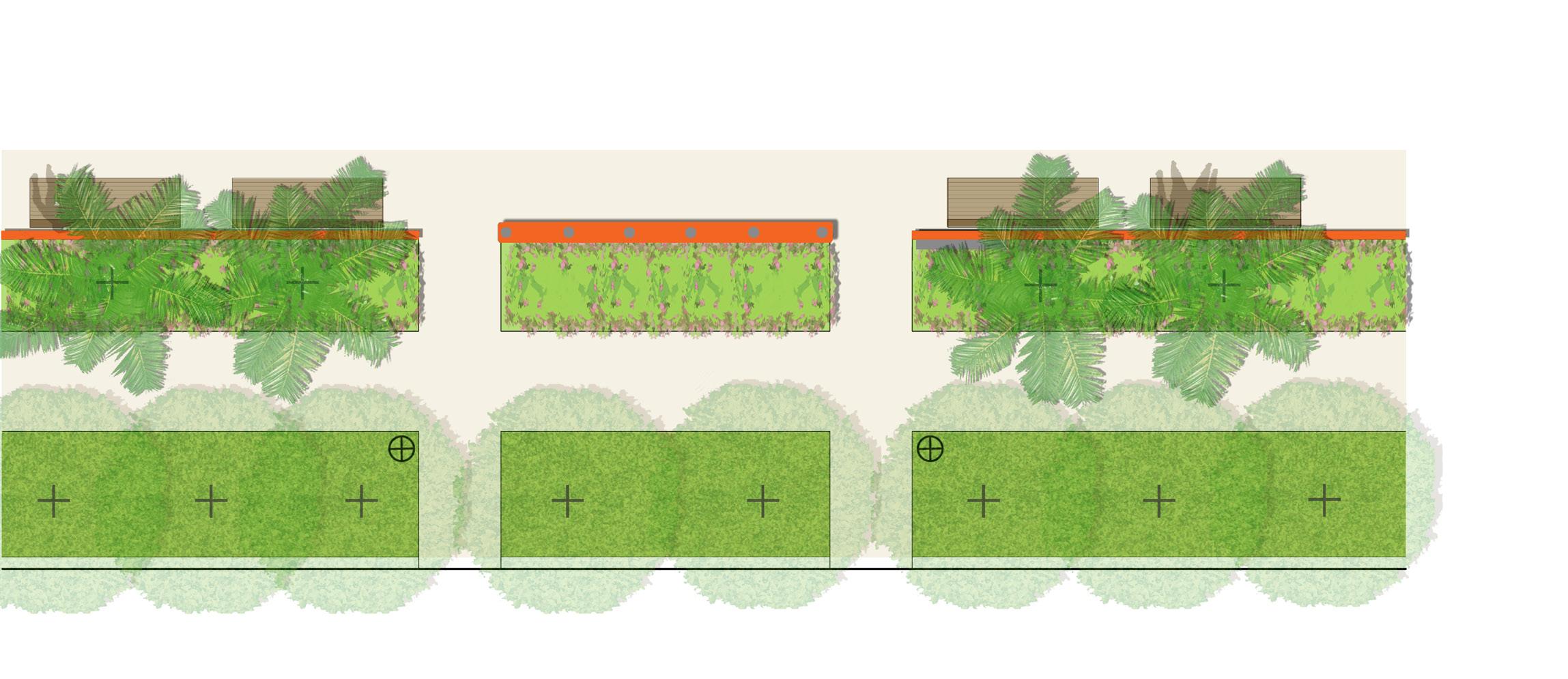
• Wall System with Integrated Seating & Planting. DOS approved anti-ram walls may be placed along or near property edges of the embassy to form a handsome backdrop for plantings and other street amenities. Plantings of native vegetation can be added to the space on the public side of the wall to soften the wall edge, create seasonal interest, and offer opportunities for stormwater management. Trees can add scale, shade and visual interest. Benches or other seating can be provided on the compound side of the wall for compound visitors. This solution can be easily adapted to a variety of environmental settings and is particularly useful at the Consular Arrival Plaza.
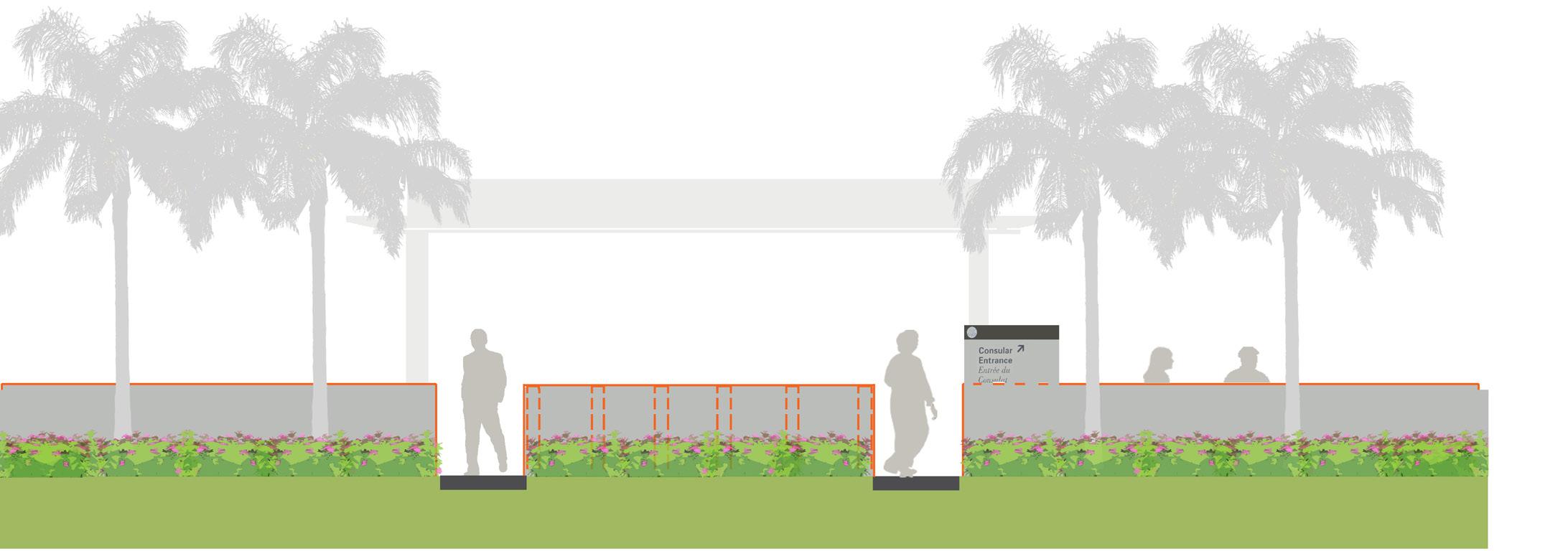

• Decorative Bollards. Free-standing bollards that serve as anti-ram barriers are a good choice, particularly when used in limited quantity. These bollards allow free passage for pedestrians while preventing cars from parking or driving in pedestrian-only zones. When aligned in large numbers, however, they can become repetitive and obtrusive. Bollards therefore shall be used in combination with other anti-ram elements to avoid a monotonous edge condition. When anti-ram bollards are exposed to public view, they require decorative covers. Prefabricated sleeves that fit over the DOS anti-ram bollards are commercially available in a range of styles to complement the local architectural character. Custom fabricated covers may also be developed to meet the unique design requirements of a site.
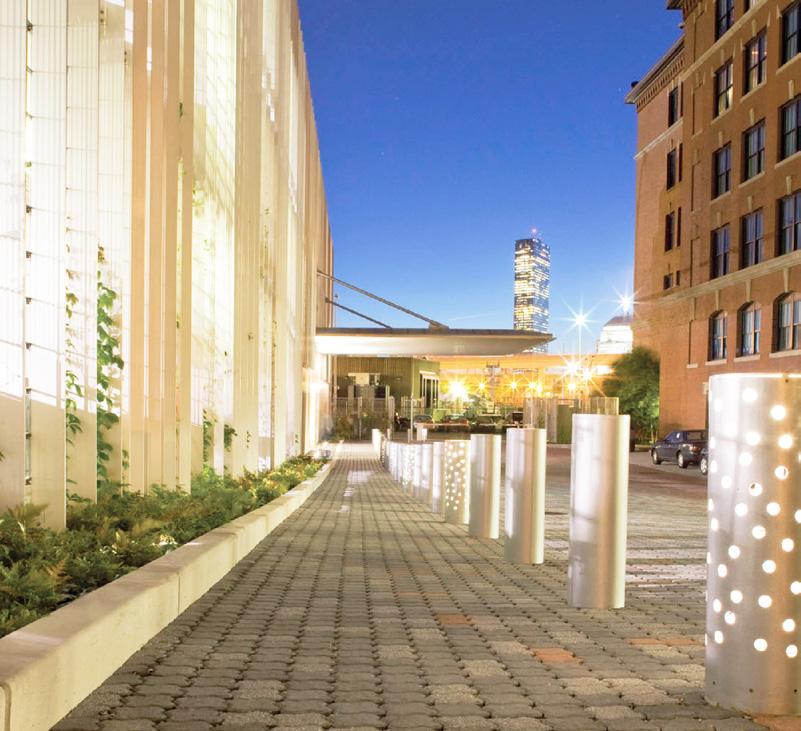
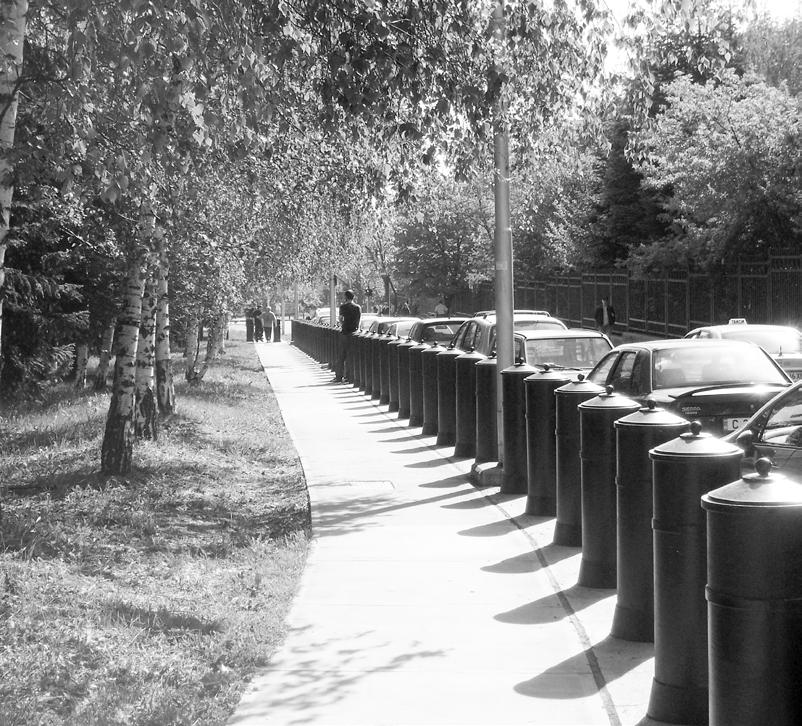


• Bollards Integrated with Planters. Bollards within the pedestrian zone may be concealed within sidewalk planters. The raised planters help to separate vehicular and pedestrian traffic, provide opportunities for seating, and create planting space protected from foot traffic. The planter walls facing toward the street shall be high enough that they do not enable vehicles to drive over the bollards. The walls facing the pedestrian space may also incorporate seating. Openings shall be provided along the length of the planters to permit necessary pedestrian access.

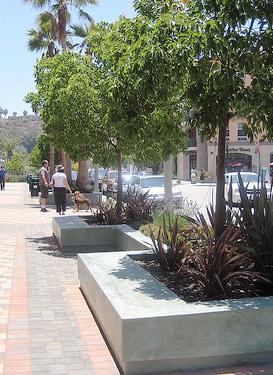





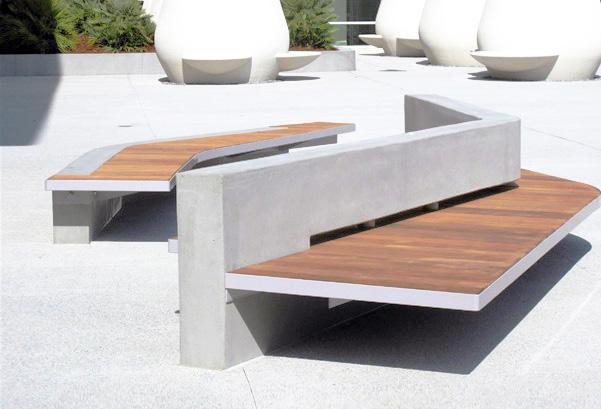

• Sculptural and Other Site Specific Elements. Artist-designed objects, or sculptural forms that reinforce and celebrate the local aesthetic within the public pedestrian zone, may be adapted to perform as anti-ram barriers. At locations where natural rock outcrops occur, or where stone is locally quarried, large boulders or cut stone blocks may be incorporated into the anti-ram barrier design. These elements must meet DOS requirements with full-scale validation testing that will define the minimum material properties, dimensions and shapes, and establish installation guidelines. These elements must also be appropriate to the physical and aesthetic conditions of the site.
• Stabilized Natural Boulders. Where the local visual setting and geology provide the opportunity, natural boulders may be used as vehicle barriers on a site specific basis. At an embassy site with steep slopes, the earth of the slope may also become part of the vehicle barrier system. Boulders typically need to be stabilized, anchored and combined with a foundation as approved by DOS. Boulder properties, embedment, size and shape are critical to providing the required anti-ram protection and meeting minimum DOS testing requirements. This approach can help the perimeter of the embassy become more visually sympathetic to the host country environment and could create a use for materials excavated during construction on steep, rocky sites. The size of boulders and their depth below grade is to be determined by DOS on a case by case basis.
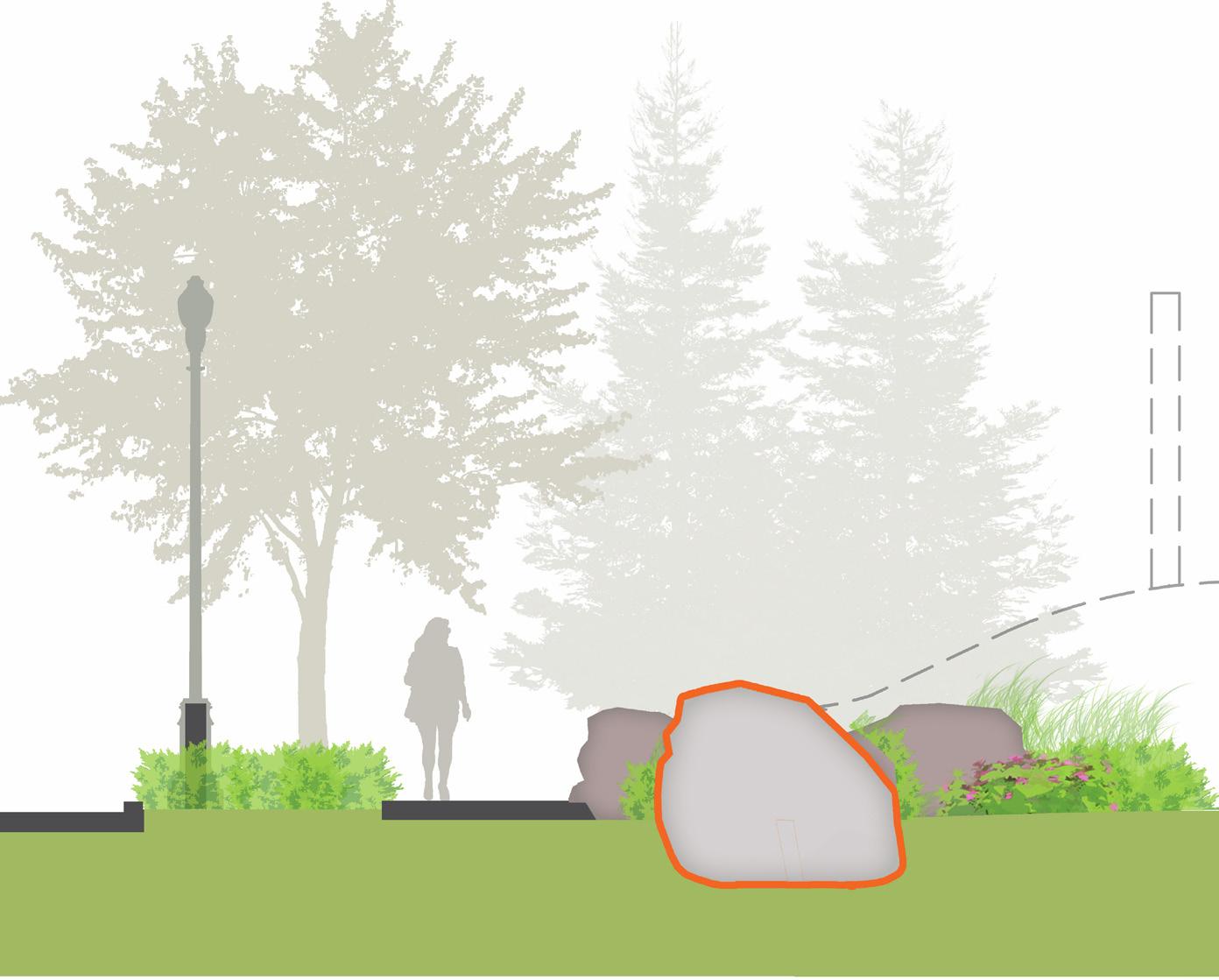




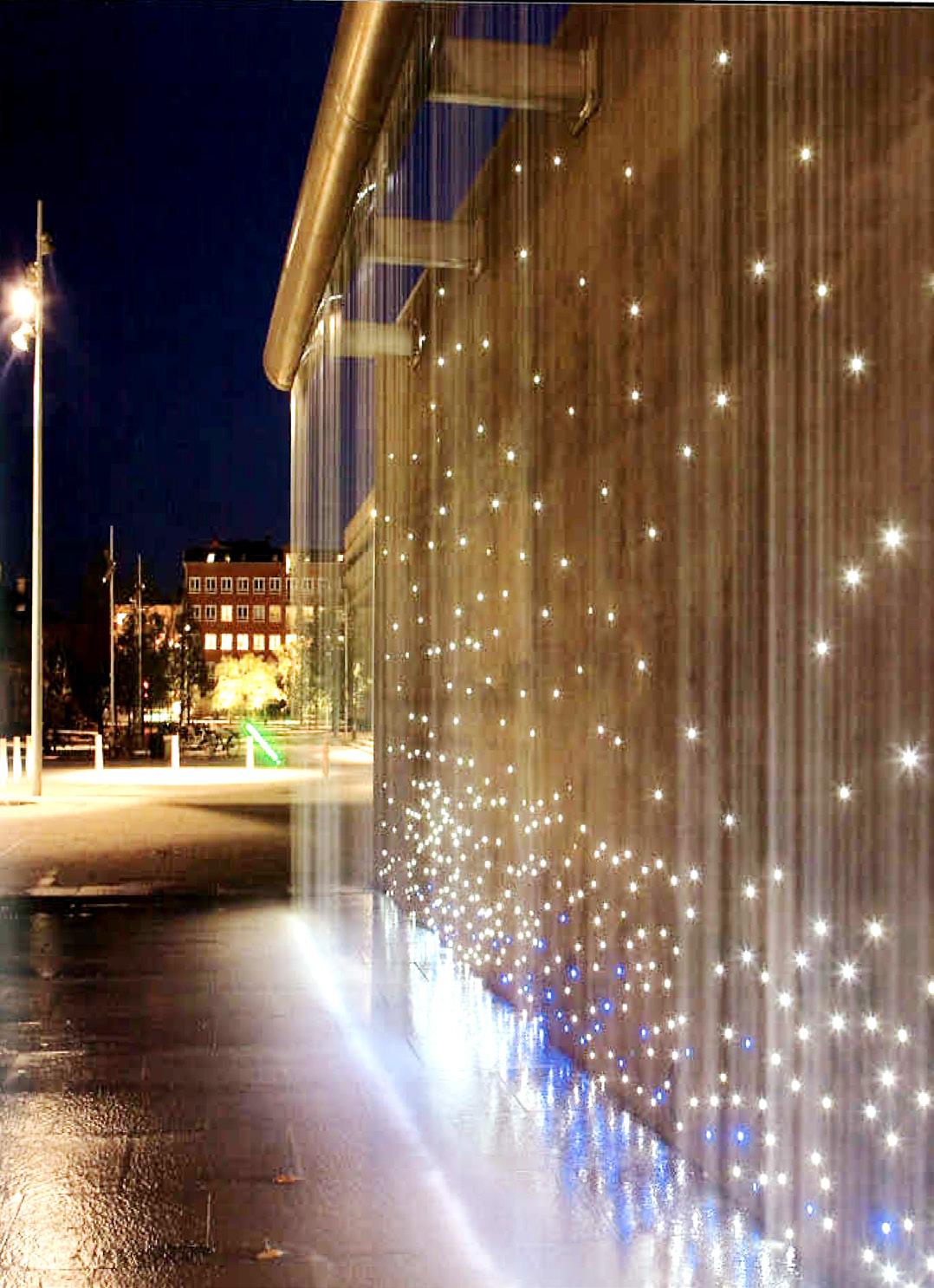
An example of an anti-ram knee wall designed as a ha-ha to diminish its appearance

• Moats / Ha-has. The moat and the ha-ha wall are traditional barrier designs that incorporate grade changes in order to keep out animals or enemies. These designs can be adapted for use as effective anti-ram barriers that also blend into the perimeter landscape. By sinking the anti-ram knee wall along the edge of a dry or water-filled depression, its visible height is reduced. The swale in front of, or behind, the wall may be a bioretention basin as part of an overall stormwater management system, or it may be designed to include an ornamental water feature. In all conditions, the exposed face of the anti-ram wall must meet DOS design standards, and the breadth and angle of the slope in front of the wall must be designed to ensure that vehicles are not able to hurdle the wall. The appropriate distances will vary and must receive DOS approval.
• Water Features The vertical nature of anti-ram and anti-climb barriers makes them versatile structures that can function not only as barriers, but also as surfaces to support dramatic water features. Anti-ram barriers doubling as water features shall be considered in locations where the embassy fronts a major public plaza or significant urban space, where the creation of a dynamic water element suits the climate and culture, and where maintenance of the water feature is practical.
Example of an anti-ram barrier that incorporates water to reduce its apparent height
(Note: Where anti-climb is on top of anti-ram wall, no additional anti-climb wall is required)

Width of planted buffer
Setback from trees or anti-ram bollards to anti-climb barrier
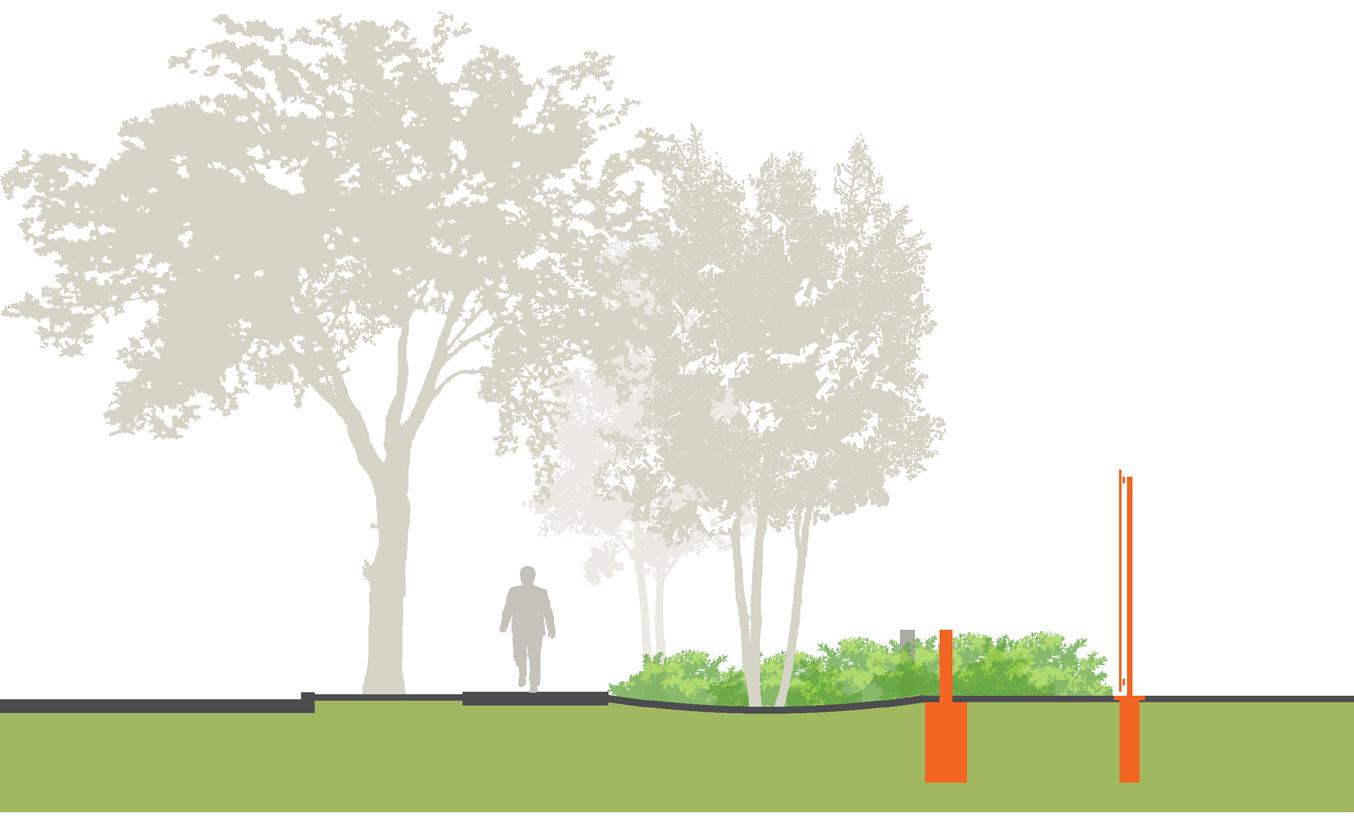
Anti-ram bollard hidden by plants
• Hardened Planting. Planting is a crucial part of any perimeter streetscape and can be incorporated into the design of perimeter barriers. Unless local culture and climate conditions make it prohibitive, street trees along all public streets must be accommodated within the pedestrian zone, and perimeter barriers must be located to avoid potential conflict with tree roots or canopies. Vegetation can also be used to soften or disguise the appearance of anti-ram and anti-climb elements, thus creating a “friendlier” perimeter edge. It is important to maintain appropriate clearance in front of and behind anti-climb barriers, as required by DOS, for views by guards and surveillance cameras.

• Walls. The design of anti-ram and anti-climb walls requires careful consideration. The height and structural design must satisfy DOS security requirements, while the alignment, material, and surface articulation must address the variable conditions of the perimeter streetscape. Even a well constructed wall with stone cladding and cap can appear monotonous and forbidding if there is no variation in its alignment and no planting to soften its appearance. When establishing the alignment of perimeter walls, it is therefore important to vary the setback distances and to allow space for planting or other public amenities outside the wall. The face of the wall may be articulated by varying its materials, or canting or curving its surface to ensure that the articulation does not enable hand-holds or foot-holds. At embassy sites where threat levels do not necessitate a fully opaque perimeter wall, the design of the wall may incorporate transparent or translucent materials that allow views or light through the wall.
• Fences. DOS standard anti-climb fences are designed to minimize horizontal foot and hand holds to preclude climbing and to incorporate vertical pickets that allow views into the embassy compound. This design is somewhat effective in creating a more transparent and friendlier perimeter; however, when implemented, these fences often appear heavy and dense, and lack real transparency when viewed from side angles. To increase transparency, when acceptable to DOS on a project specific basis, consider incorporating materials such as glass, perforated metal panels or fine metal mesh in place of vertical pickets. To create more interesting and dynamic versions of the vertical picket fence, consider curving or stepping the alignment and altering the slope of the fence. In all cases, anti-climb height must remain 2.75 meters above any ledge or foot-hold.


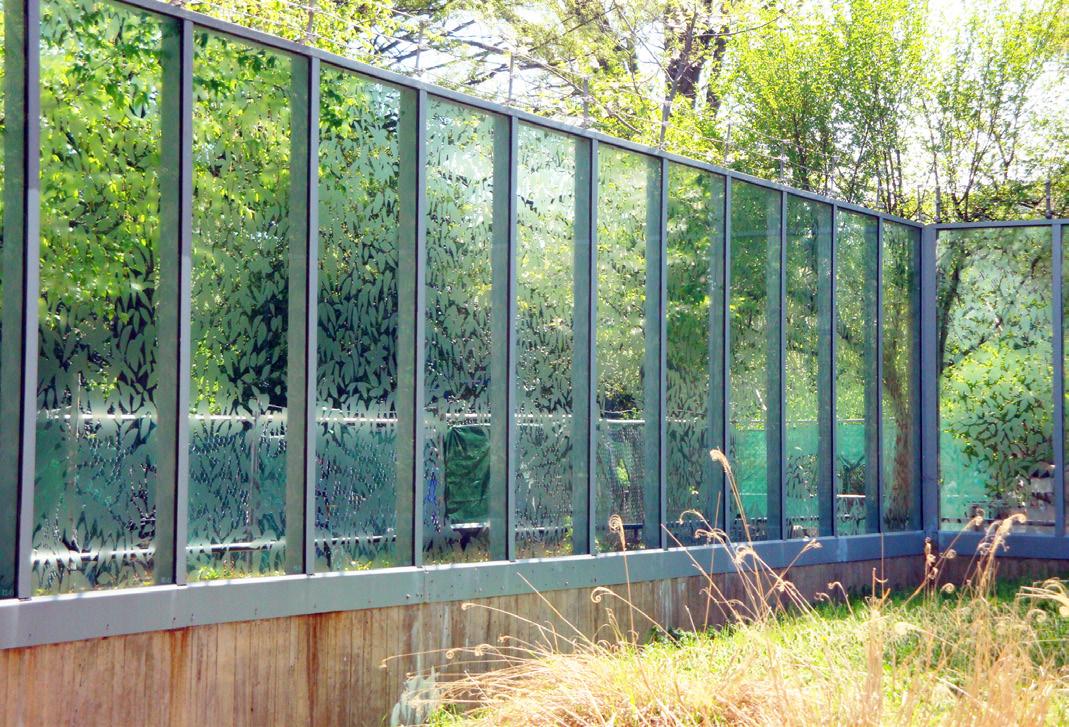




Careful attention must be paid to transitions between barriers. These connections require detailed study so that security is ensured where fences meet walls, near building overhangs, and at breaks between barriers. Regardless of the aesthetic considerations of barrier conditions, standard DOS criteria must be met for separation between elements; heights and dimensions of barriers; distances between barriers; and vertical and horizontal clearances.
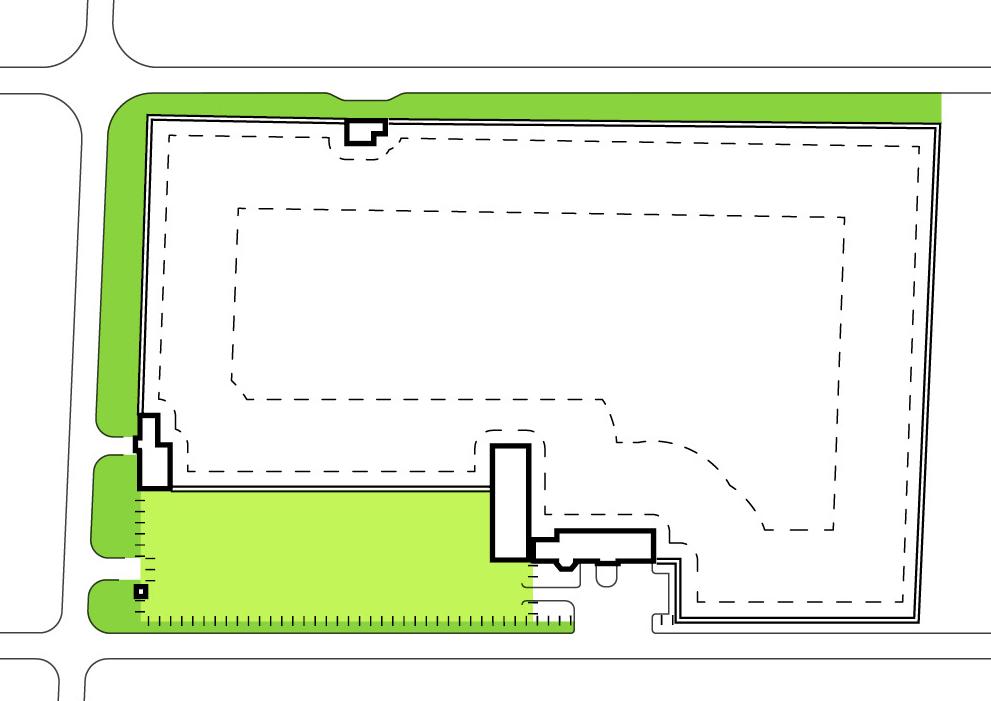
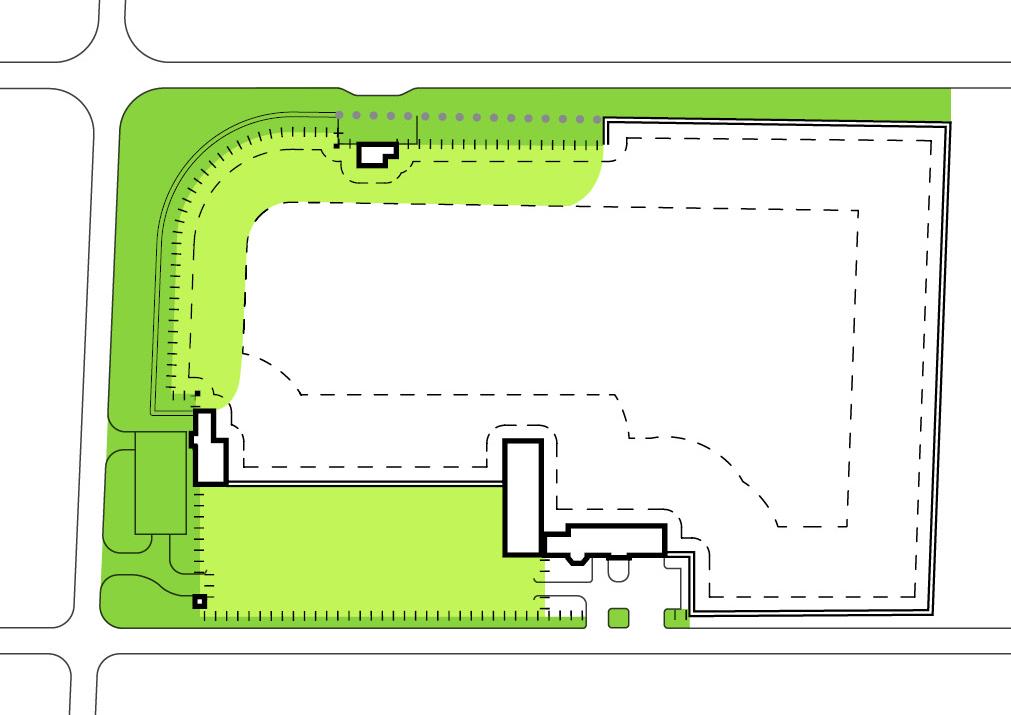

• Planting at Anti-climb Barriers. Planting can be used to create a foreground for anti-climb elements and, as noted earlier, to soften the overall visual experience of the perimeter. Planting areas can also enhance stormwater management through soil infiltration. A distance of 2.75 meters must be maintained between the anti-climb barrier and any tree limbs, so selection of species and location are critical. Where distances from the sidewalks allow, tree planting is an especially useful treatment for softening long expanses of opaque anti-climb elements while creating a green, park-like setting. Where spaces are narrower, lower plantings can be integrated, as long as the plantings will not mature to a height that could conceal a person and are of a soft enough stem to prevent a climbing “boost.” Appropriate plantings along the anti-climb edge are illustrated in anti-ram examples shown earlier in this chapter (see section B1, “Vehicular Barrier Alternatives (Anti-Ram)”).

• The 6-Meter Clear Zone. Along the entire interior perimeter of anti-climb structures, as well as along the interior of the site perimeter, a 6-meter wide, visually and physically unobstructed zone must be maintained. This zone allows guards to walk completely around the inside of the embassy perimeter, with full physical and visual access. Typically, a flat area of 1 meter in width is provided, which is just enough for the guards to walk the circuit of the embassy edge. The surface of this walking area may be gravel. Roads, recreation courts, or other paved areas incorporated into the general site and perimeter design may be considered to be part of the clear zone as long as they are without obstruction; however, parking or the placement of other moveable obstructions is not permitted. In addition to the walking area, plantings may be included in the clear zone, as long as the planting is limited in height to 400 millimeters.
Although the 6-meter clear zone has numerous restrictions, incorporating the available space into the overall site design, or developing unique designs for plantings in this area, can enhance the appearance of the embassy interior. Flat pieces of artwork can also be part of the treatment of walls, pilasters, and fencing, to provide attractive visual accents. The clear zone is typically illuminated for after-dark security, as described in OBO standards.

For anti-climb fences and walls, long sections may be stepped or sloped to follow grade in a graceful manner, in harmony with architectural design.
• Changes in Grade. Terrain may vary significantly around a perimeter. As a result, the designs of perimeter anti-ram or anti-climb elements shall account for these variations. For anti-climb fences and walls, long sections may be stepped or sloped to follow grade in a graceful manner, in harmony with architectural design along adjacent streets and within the compound. When a stepping solution appears to be the most appropriate, the design must provide for the minimum 2.75 meter height from adjacent finished grade in order to meet the anti-climb requirements. Such cases require careful study of architectural proportions to avoid segments of fence that are so high as to be intrusive on the adjacent neighborhood.
For anti-ram protection, where terrain slopes steeply downward in the direction of potential attack, the existing slope may be used as part of the overall strategy for anti-ram protection. This concept would be similar to the diagrams shown earlier in this chapter, in which anti-ram knee walls are backed up by earth berms (see section B1, “Vehicular Barrier Alternatives (Anti-Ram)”).

Local materials and references to the indigenous patterns and forms of the host country can be used to create an elegant and welcoming appearance.
• Additional Considerations for Hardscape. Hard site elements such as paving, walls, railings, fences, and site furnishings must be thoughtfully designed. DOS criteria outline the quality standards for paving and other hard elements within perimeter entry areas and require the use of high quality materials such as stone or brick that are complementary to the new office building and entry pavilion design as well as to neighborhood character. Materials for these locations are often imported, but local materials and references to the indigenous patterns and forms of the host country can be used to create an elegant and welcoming appearance. Perimeter areas, requiring special hardscape treatment, are described in detail in Chapter 2, “Perimeter Components.”

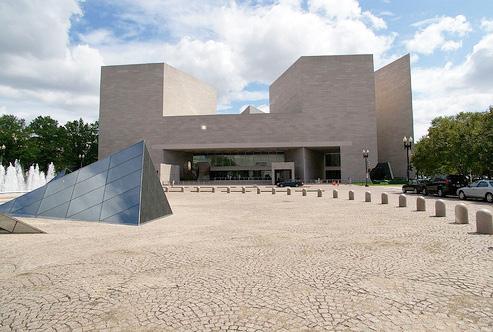
Varying the shape of the perimeter responds to the terrain and site conditions of the urban edge, adds interest and variety to the visual experience, and creates comfortable pedestrian flow to the entry points.
• Variation in the Perimeter Line. A long, simple and clean perimeter line may be appropriate in some circumstances. However, for some perimeter situations, breaking up long expanses of the secure wall or fence line is desirable. There are many methods for accomplishing this, and some are shown in the accompanying diagrams. These methods include varying fence/wall types, relating to the surrounding urban environment, and coordinating vistas with existing tree locations, smaller plantings, and hard landscape features. In addition, refined variations in planes, changes in material or texture, and the addition of columns (as is already frequently done in perimeter barrier design) can all help to create variety in an elegant manner and will result in more attractive views for neighbors. On a site specific basis, as approved by DOS, transparent segments can allow views into the garden areas of the embassy grounds. Variations in the perimeter line must not introduce “blind spots” or hiding spots, or create problems with cameras and lighting.

View through Solid anti-climb Transparent anti-climb LEGEND
These diagrammatic plans illustrate options for incorporating transparent or translucent panels into the anti-climb fence or wall that will help to reduce the apparent mass of the barrier and introduce variation in its facade. The configuration and connection of the various materials must not create a climbing hazard.

Alignment and design of perimeter elements combine to create the finished protective strategy, character, and appearance at each site.
The perimeter treatment can also depart from the site property line. Gently curved fence deflections away from the property line can create representational space with minimal site intrusion and pleasant, vegetated spaces at a variety of scales, particularly along the adjacent neighborhood streetscape edge. Varying the perimeter shape in response to the terrain and site conditions adds interest and variety to the visual experience, and creates comfortable pedestrian flow to the entry points. However, variations in the shape of the perimeter must be carefully considered. Proportion and scale must be simple and elegant enough to result in an attractive, rather than chaotic, edge. Curves can create additional public space, but must be coordinated with the remainder of the site perimeter and only be considered where there is adequate setback. In addition, the perimeter must be designed with comfortable and appropriate proportional relationships between the interior protective side and the exterior public side. Depending on site conditions, walls can be curved or straight, opaque, translucent, or transparent.
Alignment and design of perimeter elements thus combine to create the finished protection strategy, character, and appearance at each site.
1. Variations in wall alignment should be large-scale gestures, in scale with the streetscape, and may include changes in material and transparency.
2. These diagrammatic plans illustrate options for creating representational space outside the barrier wall by varying the shape of the wall or fence

All surfaces of the perimeter wall must be addressed, including the public and private facing surfaces, the cap and the base

• Surface Treatment of Walls and Fences. Perimeter site enclosure elements present two faces, public and private, which may have different requirements for surface treatment and programmatic function. On the public side, the perimeter provides a first impression of the embassy identity and expresses its relationship with the local community. This side presents opportunities to project a positive diplomatic attitude through materials, finishes, art, information, transparency and form. While the interior, or private, side may have similar requirements, it often can be treated differently than the public side, especially in areas that are out of the public’s view. At the base of the wall, the design treatment needs to consider use of a transitional material between the general wall surface and the ground line, to avoid staining from splash during rain storms, irrigation and ground seepage. Durability of materials is also an important consideration and is discussed later in this chapter. Non-climb green screen is another solution that can enhance the interior wall surface.

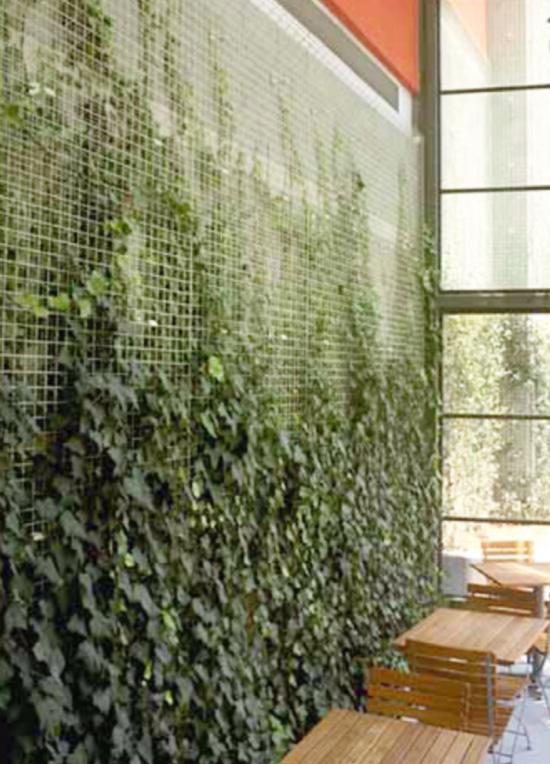




• Corner Transition and Public Space. The corner of a site shall be considered an important part of embassy perimeter design and represents an opportunity to create usable public space. Corner design, when informed by an understanding of vehicular and pedestrian traffic flow and visibility from various nearby points, can offer opportunities for neighborhood public spaces. These spaces may be surrounded by an anti-ram treatment that allows pedestrians to flow through while providing protection from vehicles. In addition, corners present opportunities to visually engage with the surrounding community and demonstrate respect for local culture, craft and art. The inclusion of public art, by either local or American artists, also communicates our country’s respect for local customs and aesthetic. Moreover, on a site specific basis, these public spaces can incorporate information about embassy events and invite public participation, when DOS and the post approve.


Incorporation of
Incorporation of Graphics / Local Art Transparency
Incorporation of Graphics / Local Art
Incorporation of Entrance Pavilion
Incorporation of Entry Pavilion
Incorporation of Entry Pavilion
a. Transparency. Site facades can vary along the perimeter in response to variations in context and function. For example, the design of the perimeter enclosure near the main entry might be treated differently from that near the service entry to the compound. In this way, intelligent design can be used to enhance the surrounding public environment, with different wall or fence types developed for varied situations. On a site specific basis as approved by DOS, a more transparent barrier may be used where visibility into the site is acceptable and reveals a pleasant view, while a more opaque barrier may be used where security or privacy are required.
b. Wall Art. In keeping with the desire to respect and reflect local culture and aesthetics, artistic elements can be incorporated into the perimeter wall. As noted above, the artwork can represent local or US artisans and artists.
c. Incorporation of Entry Pavilion(s).An architectural connection between the perimeter barrier and entry pavilions can also enhance the edge by integrating horizontal and vertical elements. Transitions between these elements must be carefully studied to ensure that security requirements are met.
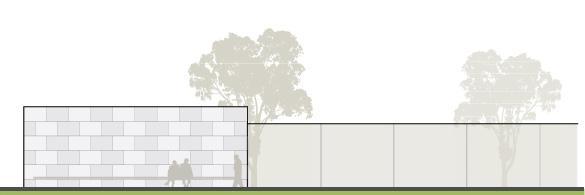
• Site “Facades”. Site topography, public access, and views from the surrounding neighborhood vary significantly from one embassy post to another. At consular entry areas where people line up to await screening, a perimeter design that is interactive with the local public is desirable, and could even include a cultural exchange facility much like the American Resource Centers, the information exchange facilities currently located within the NOB. At perimeter areas used for service functions, more opacity may be required to minimize views of the post’s “back of house” functions. On the other hand, the perimeter along a well-travelled and highly visible side of the compound may be designed differently than the embassy edge along a quiet street. Each sides of the site, or “site facade,”may be programmed and understood differently, and present the opportunity for a different design response. However, all facades shall work coherently within the same family of elements. The lengths or types of barriers do not need to receive equal treatment throughout; rather, the treatment must respond to the specific needs of the site, the building architecture, perimeter connections to the local environment, and the program of uses.
• Public Space-Making and Amenities. Created as part of the site-wide hardscape and planting design, is the very important sidewalk experience immediately adjacent to the embassy. This experience includes the spaces in front of consular arrival and main entrance arrival, as well as the presentation of service and utility areas to surrounding neighborhoods. Arrival and waiting areas shall provide shade and shelter from inclement weather and shall be characterized by the use of high-quality materials, such as stone or brick, per DOS criteria. In addition, these spaces shall include well-kept green space, and simple, clear, and welcoming signage that tells visitors what to expect from their embassy visit. These spaces shall also incorporate best practices in green and sustainable design, demonstrating that the United States cares about environmental stewardship.
The accompanying diagrams and photos illustrate how representational space shall be conceived to include the areas outside the embassy perimeter, so that the initial physical and visual contact with US diplomatic facilities is welcoming, fits into the neighborhood and reflects US respect for the local population.
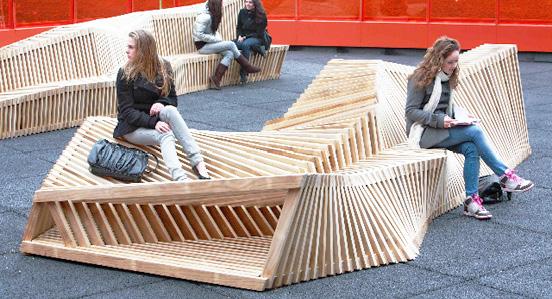
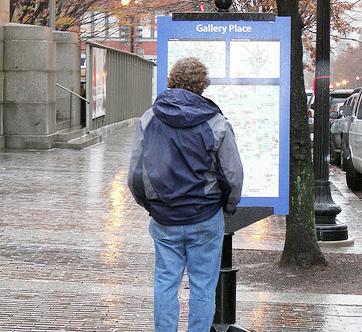
• Welcoming Signage and Visitor Amenities. While wayfinding signage at US Embassies is often clear and attractive within the compound, signage outside the compound is often limited, and visitors are neither welcomed nor informed of visiting procedures upon arrival. Although guards at some facilities are friendly, they are more typically somber and intimidating in attitude. Lack of weather protection, absence of seating, water and other human amenities at many facilities all convey an attitude of disrespect and mistrust toward US embassy visitors. The result is that, in some countries, visitors feel intimidated and confused.
In addition to new perimeter designs to make US diplomatic facilities more inviting, signage and amenities shall be designed to communicate safety, respect, and information availability to visitors. Embassy personnel can reinforce these feelings through greetings and interaction with visitors.
These concepts are particularly important at the consular entry. At these locations, the following shall be accomplished:
a. Minimize confusion:
• New signage in accordance with DOS signage design requirements
• Signs that include a welcoming message, embassy operating hours, and a brief explanation of visiting procedures and expectations for visitor behavior
• Seating and shade that does not encourage loitering or long-term use by the public
b. Provide visitor amenities outside the compound edge, including:
• Shelter from inclement weather
• Access to short-term seating
• Access to water

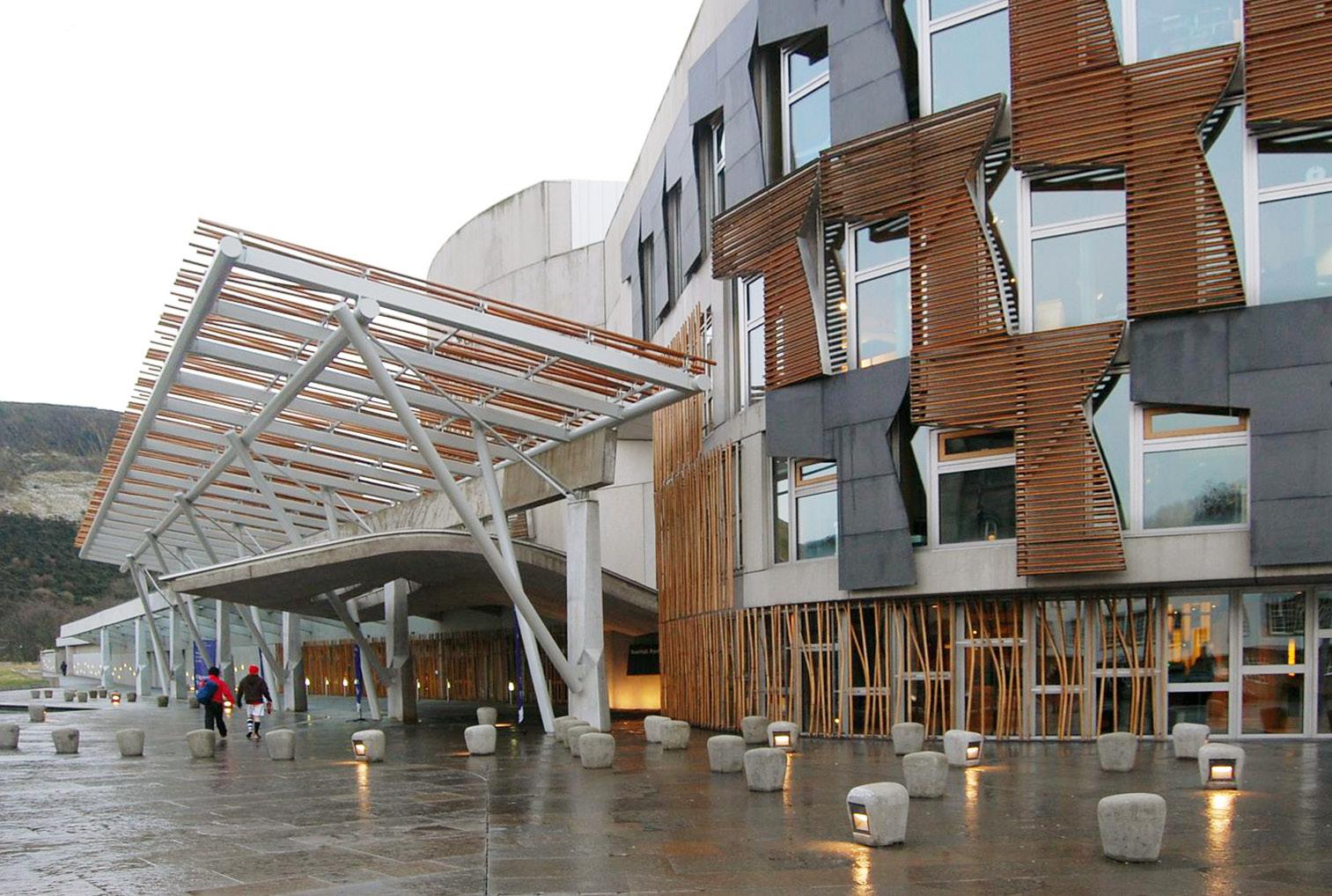
• Local Culture, Craft, Antiquity, and Art. The inclusion of art and craft, by both American artists and artists of the host country, can serve the dual purpose of enhancing the image of the embassy, and demonstrating respect for the host country, while also serving a security function. The accompanying images demonstrate various examples of art and craft worldwide which can easily be incorporated into embassy design while providing perimeter protection. These images show a diversity of design opportunities and are provided as an inspiration to designers in the process of creating new US diplomatic facilities.





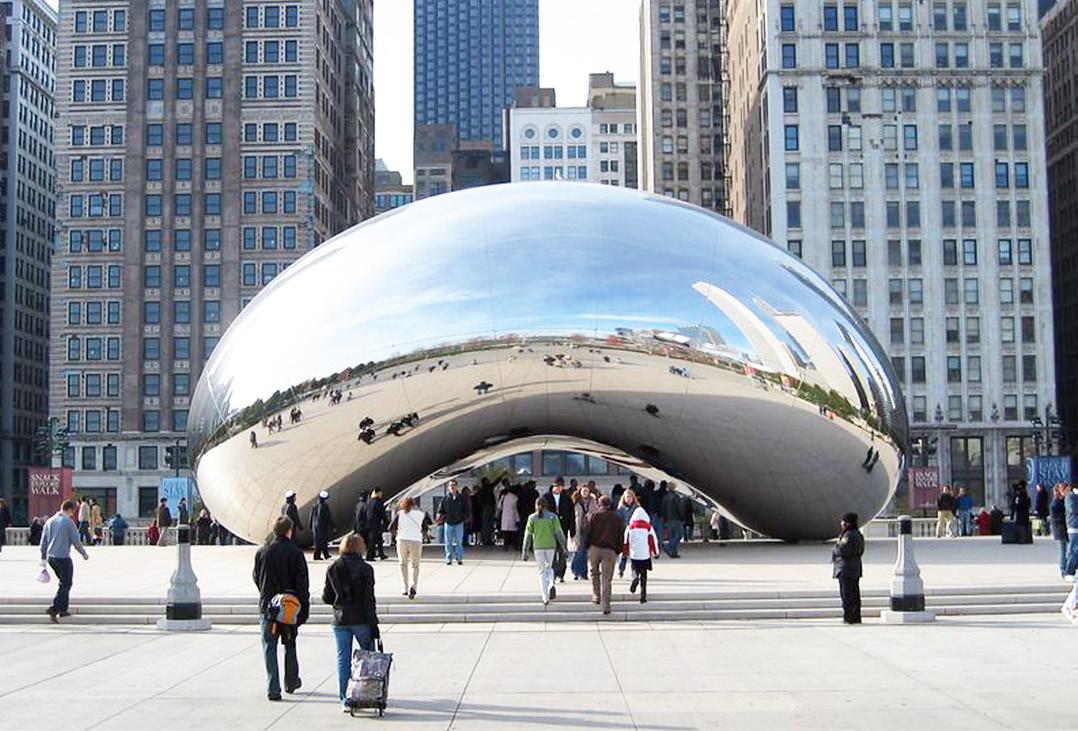
A variety of examples of site specific art and art integrated with site elements
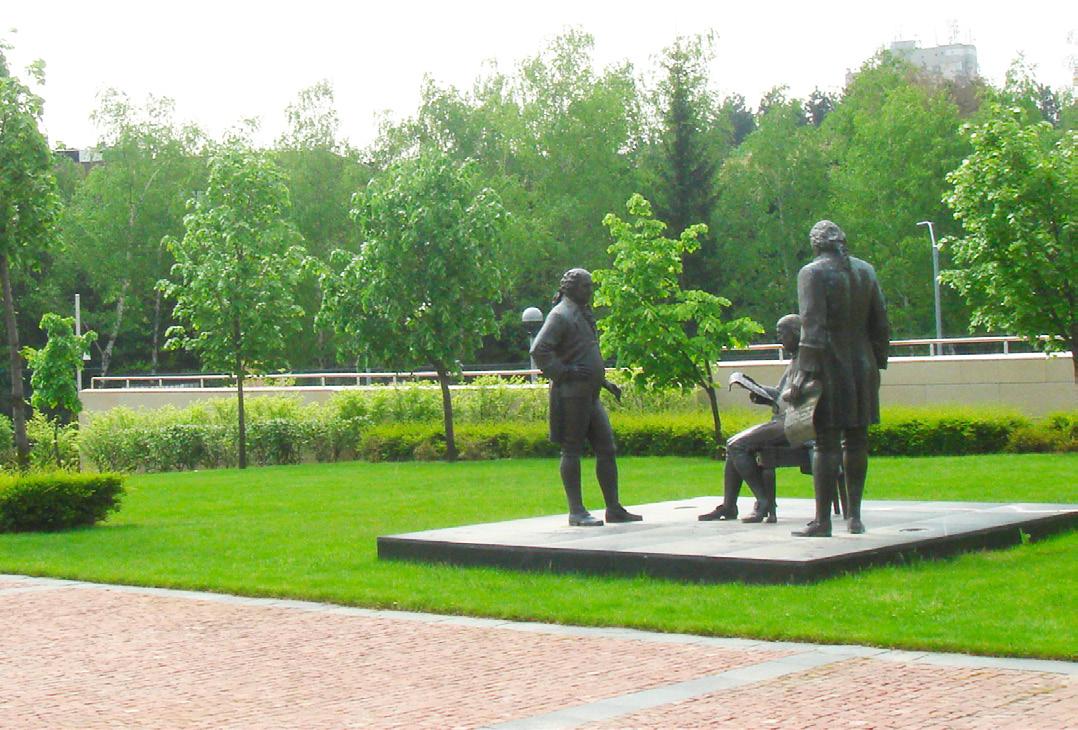

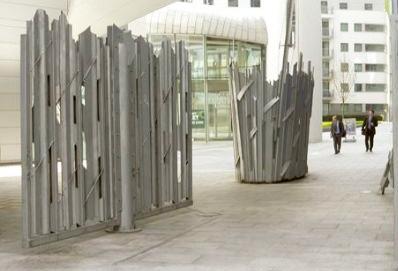




Provide bike racks at or near visitor entrances

Provide recycling facilities within service courtyard
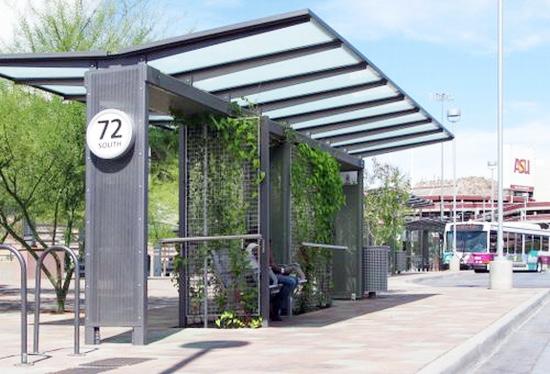
Encourage use of public transportation by providing sheltered transit stops

Vegetation can be incorporated into barriers

Barriers can provide stormwater management via vegetated swales and berms

Permeable pavers in Sofia, Bulgaria
Embassy compounds can realize increased benefits by seamlessly integrating principles of sustainable design into embassy perimeter design.
• Local Ecology. Embassy compounds can realize increased benefits by seamlessly integrating principles of ecological (or sustainable) design into embassy perimeter design. This approach requires an understanding of local ecology in real terms, which is critical to successful design. The site analysis checklist in Appendix D provides a list of characteristics for physical site conditions and microclimate, among others. This information is often gathered during initial site investigations, and can be used effectively as a design tool. When ecological knowledge is properly applied, the resulting design can achieve environmental benefits such as preserving specimen trees, reducing irrigation, managing stormwater, using local materials as part of the design and, eventually, reducing maintenance and management to create a more sustainable site.

Understanding the site from the ground up allows perimeter and site design to reflect the uniqueness of each place.
The US Embassy in Sofia, Bulgaria is DOS’ first installation to achieve certification by the US Green Building Council Leadership in Energy and Environmental Design (LEED) program. Other systems of applying ecological principles have recently been developed, such as the Sustainable SITES initiative (see bibliography), giving engineers, architects, and landscape architects a broad range of ecological tools that can be used to develop sites and landscapes.
• Preservation, Conservation, and Sustainable Design. Many techniques of ecological (or sustainable) design are available to designers during all phases of project design. Workable solutions will vary at each site, and not every technique can, or should, be used at every site. However, understanding the site from the ground up allows perimeter design, as well as remaining site design, to reflect the uniqueness of each place—not only in ecological terms, but also aesthetically. The following techniques can easily be applied to perimeter design and design throughout a compound:
Planting
• Preservation of existing trees and forest stands
• Preservation of intact examples of local ecosystems such as steppes, prairie or desert
• Use of native and naturalized plants
• Use of green roof systems
• Use of green screens
• Removal of invasive plants
• Reforestation and revegetation for habitat creation
• Addition of biofiltration plantings that can serve as part of perimeter barrier systems
Soils
• Use of structural soils to allow for support of paving while accommodating plantings
• Application of suspended paving slabs on uncompacted soils to allow tree root paths for root aeration and irrigation
• Minimization of impervious areas
• Control of erosion and runoff through sensitive site grading

Materials used in design of embassy perimeters, as throughout the compound, must be carefully selected to be harmonious with architecture and local aesthetics.
Stormwater Management and Water Conservation (in coordination with local laws and regulations):
• Use of stormwater infiltration
• Harvesting of stormwater or gray water for use in landscape irrigation
• Use of pervious paving materials in hardscape areas
• Creation of drainage areas than can serve as protective barriers
• Construction of rain gardens and vegetated swales
• Restoration of stream banks
• Use of porous or permeable paving where subsurface percolation conditions permit
Cultural Resources
• Preservation of archaeological remains and historic structures
• Materials, Maintenance and Durability (Materials: use of locally acquired materials; use of local craft methods; use of site-gathered materials such as stone; use of recycled materials.) Materials used in design of embassy perimeters, as throughout the compound, must be carefully selected to be harmonious with architecture and local aesthetics. In addition, the quality of materials at perimeter entries must comply with DOS standard criteria. Specialized use of materials is typically required, such as stone at the base of walls in order to prevent staining from adjacent soils, as well as high quality paving material in representational areas in accordance with DOS standards. Use of recycled materials is also encouraged, as long as they meet DOS criteria.
Use of local craftsmen during construction, and locally fabricated or locally obtained materials, is also encouraged, as long as these materials meet DOS standards for durability. For example, tropical hardwoods removed as part of site construction may be harvested for resale to local craftspeople, or for creation of site furnishings to be used within the compound. Also, locally excavated stone may be used for natural boulders in the landscape or as part of perimeter barrier design, as long as DOS standards are met.
Because US embassies are designed in varied locations throughout the world, local soil and hydrology conditions, and local climate, must be considered so that the selected materials will be durable in a given locale. For example, in sites with very acid soils, or heavy salt spray, it would be advisable to select materials that are resistant to corrosion when exposed to such conditions.
The design of the perimeter is an iterative process that is closely related to overall site design.
The design of the perimeter is an iterative process that is closely related to overall site design. The design process requires incremental review by DOS at each stage in the design process. Each key stage of design, as well as the role of DOS at critical junctures, is described below.
• Site Survey and Analysis. At the earliest stages of design, data collected during the site survey must be documented, analyzed and submitted for review by DOS. Products of the Site Survey and Analysis phase typically include:
• Code analysis to identify international and local requirements that may affect wall heights and setbacks
• Geotechnical investigation that will provide the basis for all structural design of perimeter barriers, buildings and site components
• Identification of locally available hardscape and softscape materials and design practices that may be incorporated into the perimeter and site design
• Risk/threat analysis (as described earlier in this chapter) to establish the physical design criteria for the anti-ram, anti-climb, and visual barriers
• Alternatives and Recommended Solutions. Following the site survey and analysis, the design process typically includes a detailed planning phase, a schematic design phase, design development, and the preparation of construction documents. While these phases of planning and design may be performed by multiple teams under separate contracts, the process typically builds upon previous design efforts, such that the design of the site and the perimeter become refined with each subsequent phase. Each phase includes the development of alternative options and refinement of the preferred solution, to be reviewed by DOS.

Models and visualization drawings show how the perimeter engages with the overall landscape setting, the various entry structures, and the rest of the buildings and circulation on the compound.
• Design Products. Products required to be developed and to be submitted to DOS during each phase of planning and design are explained in detail with each DOS project contract. The documents generally include the embassy perimeter drawings as part of the overall deliverable package for the compound. Models and rendered visualization drawings are often required to show how the perimeter engages with the overall landscape setting, the various entry structures, and the rest of the buildings and circulation on the compound. Typically, the products include, at a minimum, the following:
• Site Utilization Diagram to establish the functional relationships and general layout of the site
• Site Perimeter Diagram to delineate the perimeter zones and all components of the perimeter barrier and access control system
• Master Site Development Plan to illustrate the proposed treatment of the perimeter zones and the perimeter barrier system in context with the preliminary site and landscape design
• Design Narrative to describe overall philosophy and special design considerations of the site and perimeter
• Schematic Site Improvement Plan / Landscape Plan to delineate all buildings, structures and functional and representational spaces of the site and perimeter, as well as the initial concepts for hardscape and planting treatments
• Site Perimeter Plan to indicate all the types and figurations of the perimeter barriers proposed for the site
• Typical Perimeter Elevations to show heights and initial surface finishes of the perimeter barrier and access control elements


• Design Development Site Improvement Plan for presentation to DOS, Post, Tenants and local government authorities to address such issues as regional context, relationship of the site and perimeter to the neighborhood and street, and inclusion of indigenous cultural art or craft features and design elements. This plan also shows the specific location and types of perimeter barrier solutions proposed
• Representational Area Plan Enlargements to illustrate the layout and selection of materials for key public spaces, arrival courts, entry plazas, and key garden areas of the perimeter and site
• Extended Elevations of all perimeter barriers to show the appearance of all walls, fences, bollards or other perimeter barrier elements and how they relate to the adjacent grades and features;
• Cross Sections through site and perimeter barriers to show the relationship of the proposed perimeter and site elements to grade and to adjacent properties
• Site Grading and Utility Plans to indicate the earthwork, all utilities and water conservation features
• Site Planting Plans to indicate the full scope of plantings throughout the planted areas of the perimeter and site. Tree preservation and site soil preparation are also included in these documents
• Site Lighting Photometric Calculations to demonstrate conformance with OBO-ICS IZC Design Guidelines for Site Lighting
• Structural Calculations for walls and foundations that are part of the perimeter control barrier system
• Blast Report to demonstrate the effectiveness of the building design against blast loading at the actual setback provided by the anti-ram perimeter
• Refinements of all documentation provided at Design Development to incorporate DOS comments and additional detail required for construction
• Site Signage Plans and Details to detail the complete signage system, including the perimeter zone wayfinding and informational signage
• All additional Documentation, drawings, and specifications required by the DOS contract for a specific embassy to construct a complete and functional perimeter project as part of the overall project design
Typically, during the embassy design process, site selection will generally have been completed by the time the perimeter design process begins. A multi-disciplinary team provides collaborative design to develop not only the perimeter, but the interior of the embassy compound. The team must consider how the site works from outside to inside. Specifically for the improved design of the embassy perimeter, the list of questions below is a checklist to serve as a guide to the process of barrier selection and perimeter design.
• Is the setting densely urban, suburban or generally undeveloped?
• What is the neighborhood like around the embassy? Are all sides the same? What would make a difference in design approach along each edge of the property?
• What are the adjacent conditions on each side of the property? Is there residential, industrial, or commercial development nearby? Is there parkland? Is there undeveloped open space?? Are there other diplomatic facilities, military or police facilities of the host country, local government buildings, or mass transit?
• What are local traffic patterns? What are local traffic customs? How do they influence arrival at the site perimeter – where do people come from? Are they coming on foot? Are they dropped off by family/friends/taxi? Do they arrive by personal vehicle?
• What transportation systems typically serve the site – how do people arrive? Foreign staff? American staff? Visiting dignitaries? Business people? Consular visitors?
• Is there access to public transit nearby? Are transit stops sheltered? Is there vehicular access by car, motorbike, bicycle? is there easy pedestrian access? How do people arriving for consular visits park or get dropped off?
• What is the local perception regarding safety of the neighborhood? How will this influence design choices?
• Can people read? What is the local sense of timing and lifestyle?
• What is the socioeconomic status of people visiting the embassy?
• Do people in the host country have access to Internet and other electronic media?
• How does vehicular circulation work currently? Will vehicular circulation be changed during compound design? If so, how? Has the approach distance and speed of potential attack been calculated for all sides of the site?
• Do all sides of the site have identical threat and risk?
• Is there an opportunity to work with local officials to adjust nearby speed limits and local traffic patterns to reduce the requirements for the highest level of threat protection in site-specific cases?
• How do pedestrians approach the site? Are there opportunities to approve the appearance and comfort of pedestrian access? Are pedestrian access points clearly visible and well-marked?
• Have all the DOS criteria for determining threat and risk been thoroughly reviewed and evaluated, and calculations made, so that the site-specific requirements are clear?
• Have local police guard booth requirements been incorporated into the perimeter design in a manner compatible with the design of the entire perimeter?
• Are there variations in the threat level calculated during the Risk/ Threat Analysis (above) that suggest the broadest diversity in choices of types of barriers and protective devices?
• What is the meaning of walls and fences to local users? Are they perceived as protective and a normal part of the local landscape, or threatening and hostile? Note that the wall versus fence decision may be determined by physical security requirements for compliance with the designated threat level, which overrides local perceptions.
• Where cameras are required, are locations coordinated with lighting and landscape elements?
• What are the site-specific visual protection requirements? Is transparency desirable on the part of local users or on the part of embassy officials? Is complete opacity required or desirable? Can visual screening be partial on a site-specific basis?
• Where transparency of the perimeter is desirable, does the design prevent passing contraband through any perimeter enclosure?
• What types of materials are locally available for barriers? Is there a local design vocabulary of materials and details that can or should be interpreted for selection and design of barriers?
• Have all the DOS criteria for barrier design been thoroughly reviewed and evaluated so that logical choices can be made for site-specific requirement and incorporated into the perimeter design? Does the barrier selection and design meet all DOS criteria?
• Has a Site Vehicular Barrier Analysis diagram been prepared?
• Has the design incorporated clear definition of responsibility for maintaining any improvements suggested for the area of the public domain adjacent to the embassy compound? Has the spatial organization of the landscape been considered so that there is a clear sequence of spaces for arrival, waiting, and passage into and through the site? Has a diversity of experience been created?
• Are the landscape design, architectural design and security design fully integrated into a coherent and beautiful series of spaces for the public and embassy staff?
• Have shade trees and gardens for specific functions been included as part of the perimeter design?
• Has the use of native and easily naturalized plant species been considered? Has the availability of nursery-grown plants been confirmed with knowledgeable locals?
• Are steps, paths, and furniture selections appropriate to the type of the architecture at the site perimeter and within the compound? Is an adequate quantity of furniture provided?
• Have rain and sun shelters been provided as required and, on a site-specific basis, have they been provided in addition to standard criteria?
• Is lighting adequate to meet DOS criteria and DOS Lighting Design Guidelines?
• DOS criteria describe landscape requirements very specifically. Have all DOS criteria been met or exceeded?
• Is there an accessible loading zone in close vicinity to each entry pavilion serving staff and visitors?
• Is accessible parking provided, including the minimum number of spaces, access aisles and signage?
• Is there an accessible route linking accessible loading zones, visitor and each entrance pavilion? Is there adequate clear floor space at each entrance door for wheelchairs? Do accessible routes meet minimum slope requirements? Do they contain turnaround spaces were needed?
• Are the accessible routes coordinated with physical security barriers?
• Are all the elements of each accessible route designed to harmonize with the landscape design requirements? Are walking surfaces stable, firm and slip resistant?
• Are stairs, ramps, handrails and curb ramps designed to meet accessibility requirements?
• Do seating areas in gardens allow for wheelchair spaces next to companion seating?
• Is accessible way finding signage coordinated with the landscape design?
• Are other elements, if any, such as protruding objects and drinking fountains designed to be accessible?
• Does the design include clear, accessible public spaces and amenities for embassy visitors as they arrive and enter the site? Is access to public transportation clear at each entry to the site? Are special amenities such as bus shelters, provided by the local jurisdiction?
• Are there zones near controlled access points established for tents or other spaces suitable for special events (including access to audio/ video and electrical support)?
• Is welcoming and friendly wayfinding signage clearly placed at site entry points? Is informational signage provided? Are the graphics clear, legible and in accordance with OBO signage design criteria?
• Have local history and human needs been thoroughly researched?
• Are there opportunities to recognize local culture, such as poetry, crafts and visual arts at or near the site perimeter? Are antiquities available from the local jurisdiction? On a site-specific basis, can they, or should they, be incorporated into the perimeter design?
• Is there a way that the embassy can “give back” to the community open space or a welcoming sense of place?
• Is local hydrology clearly understood by the design team? Has a water budget been determined? Has a water-sensitive, or net-zero design approach, been developed for the perimeter as well as the interior of the site?
• What are the hydrological features that influence site design? What are the soils characteristics? What is the character and type of vegetation at the site? Are there specimen trees that need to be preserved?
• Are earthworks and/or retaining walls required? Are they beneficial in developing a site design for the perimeter? Are there natural landforms, terrain, or materials such as boulders incorporated as part of the perimeter design to emphasis the local setting?
• Can local materials be used effectively to reduce the need for transport of materials from off-site or to the site? Or, should materials be imported?
• Has porous paving, green roof, green wall and other sustainable design technology been utilized to the maximum in designing the compound perimeter?
• Has energy use been studied and calculated? Is lighting designed to support “dark sky” concepts? Does the design meet or exceed all OBO requirements?
• Are the selected materials durable in the site-specific climatic, soil, and urban conditions?

In spring 2010, the multidisciplinary OBO team visited four embassies. The embassies were selected based on their differing ecological, cultural and economic settings, as well as for their diversity of threat levels and their urban/suburban locations. The sites visited were:
• Belmopan, Belize
• Kingston, Jamaica
• Sofia, Bulgaria
• Athens, Greece
The team’s assignment was to study the perimeter of each embassy: the space defined as the area between the edge of a public street or way and the face of the Chancery or Consulate, including the areas in which motorists and pedestrians see and come into contact with the outside edge of the site, and pass through its secured walls, fences, guard posts, and screening facilities to enter the compound and the buildings. The following photographic analysis describes existing conditions at each embassy visited and highlights problems and opportunities observed at each site.

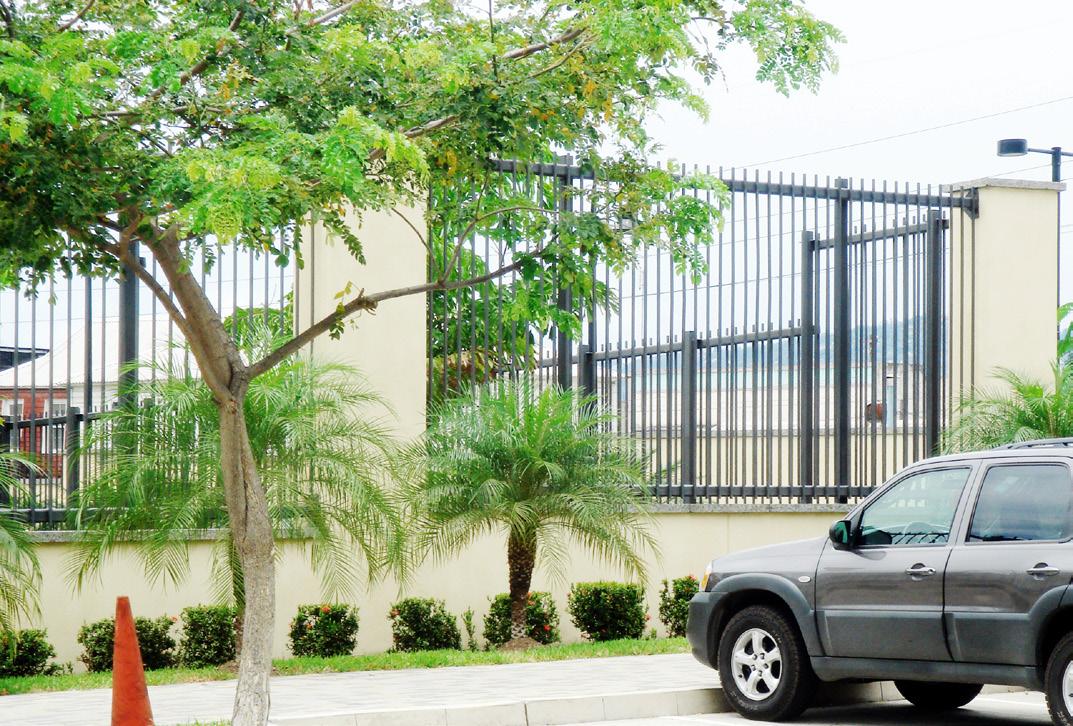
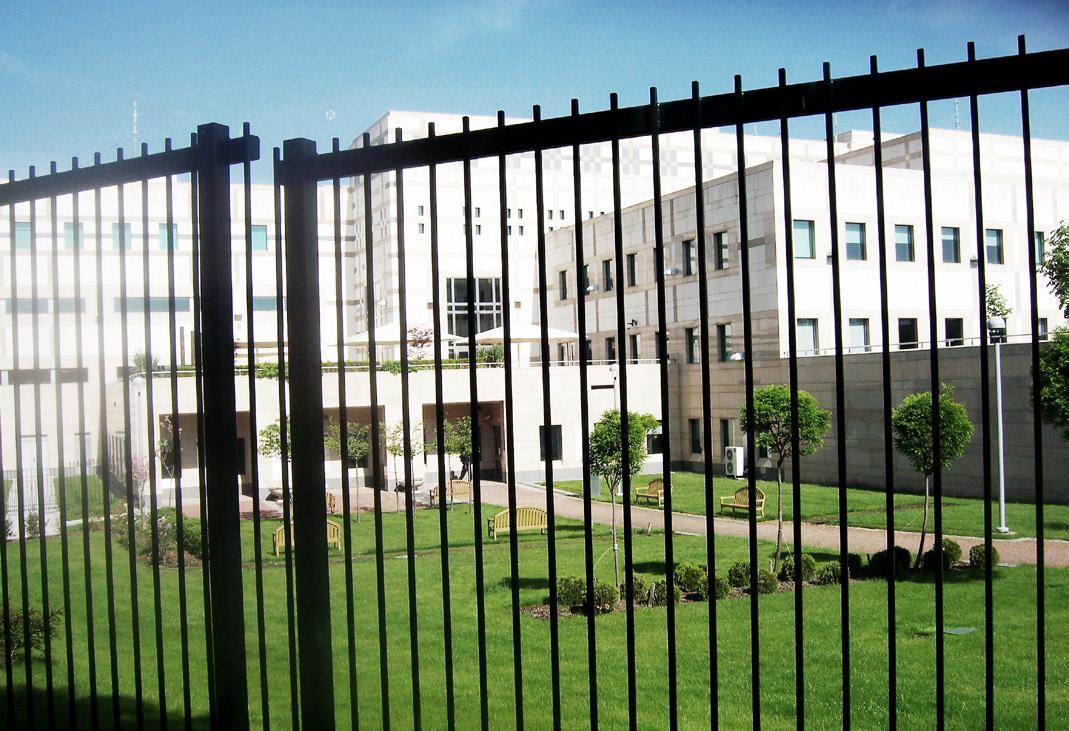

The comments of Consular visitors, often frustrated, sometimes complimentary, always poignant, gave the team a clear understanding of how critical the first impression of the US Embassy is in forming local judgment about America.
Overall findings regarding each embassy reflect not only the team’s observations but the concerns and hopes of the various individuals interviewed during the course of the site visits: media representatives, who have visited their local embassy as journalists or writers; visa applicants; diplomatic representatives, who have worked in many countries on 2-3 year assignments throughout their careers; and facilities staff, some of whom have worked in their jobs at a single embassy for over 30 years. While the team noted numerous issues related to perimeter design, a particular concern for embassy officials was the experience of consular applicants — as they line up outside the compound and wait their turn to be screened, interviewed, and processed. For the applicants, this experience creates perhaps the most profound impression of the United States. The comments of consular visitors underscored the need for significant and prompt improvements to facilities, both through the construction of new facilities and, when there are opportunities, by upgrading existing ones.
In addition, little information about America and Americans is available until visitors are well within the compound. Many embassies have an Information Resource Center (IRC), but these are usually within a New Office Building (NOB ), well within the compound, difficult to access, especially for consular visitors, since they require a separate appointment; these IRC’s are therefore typically underutilized. Other embassies have an “American Corner,” but these are typically not part of the embassy compound and are often too far from the compound to be visually or perceptually linked with the embassy. Examples are the popular American Corner in Sofia, Bulgaria, which is centrally located in the downtown, while the embassy is in a more suburban location, far from pedestrian access to the American Corner. On a site specific basis, as approved by the US Department of State (DOS), perimeter design could incorporate a place, within or near the consular access pavilion but not outside the perimeter, where visitors can obtain information about America. Such a facility would enable visitors seeking a visa to obtain information, to use computers and library materials, and to be out of the weather while they await their visa appointments.
Belmopan, Belize is a small and relatively new city, located approximately 50 miles southwest of the former capital of Belize City. Due to Belmopan’s remote location, many diplomats and business people, as well as most consular visitors, come to the embassy by bus from Belize City, where the former US Embassy had been located. The present embassy in Belmopan, which is situated in a residential neighborhood with a suburban character, is disproportionately large in scale when compared to the rest of Belmopan’s small and more suburban character. The embassy compound is noteworthy for its attractive main Consular Pavilion entrance and beautifully maintained grounds. At the same time, however, certain facilities and operations do not function well. While there is a bus stop near the post, no shelter is provided. Moreover, access to the embassy is constrained. There is no drop-off area in the front of the consular area, and a large, deep stormwater trench adjacent to the curb makes it challenging to cross the street. The perimeter offers good views into the embassy compound, due to the open picket-style fencing and limited plantings along the street edge; however, the open design of the perimeter fence also enables people to pass objects through the fence from outside, which represents a security risk.

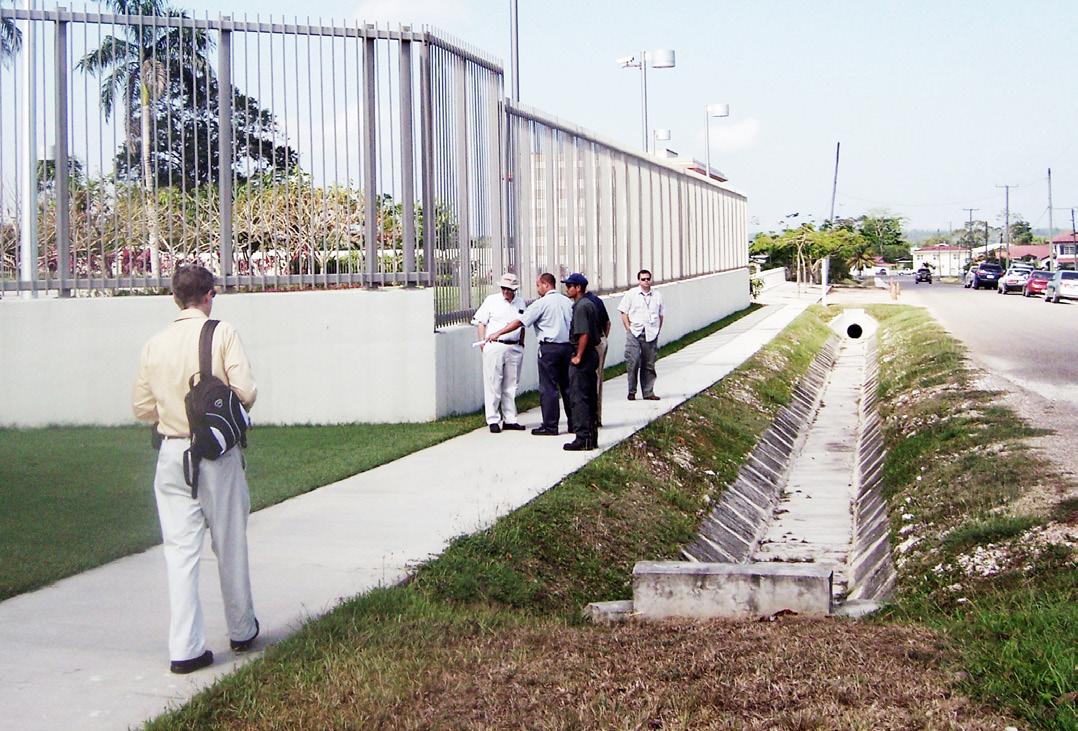
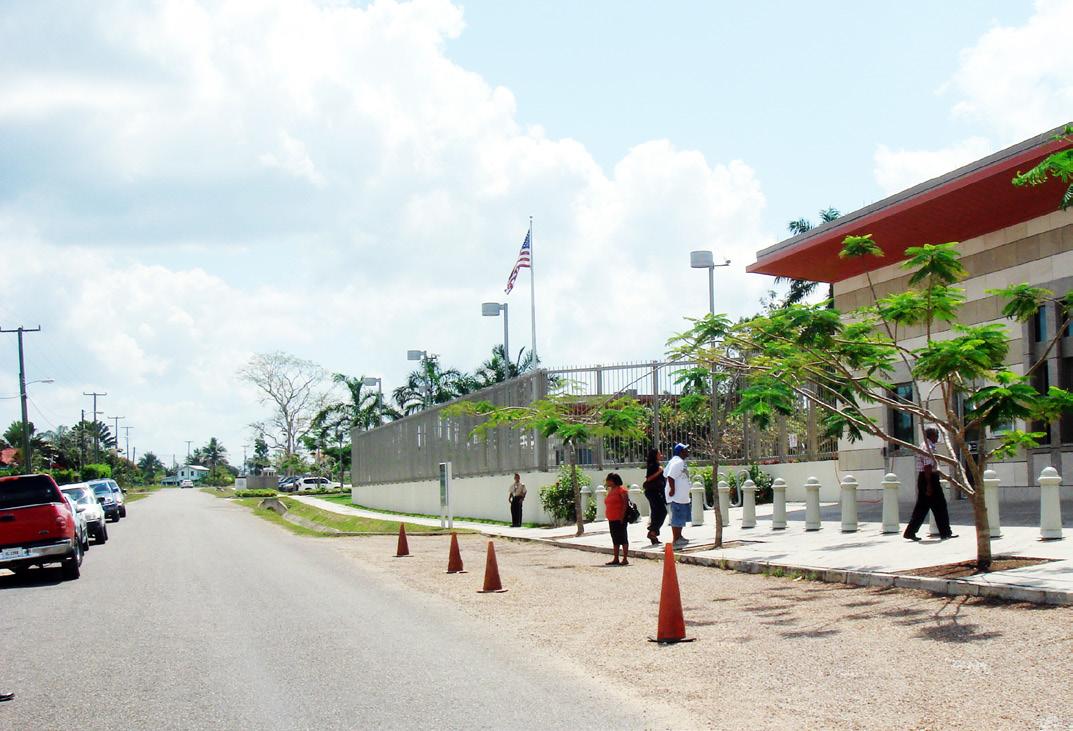



Representational

are needed
• Sidewalk is very close to wall making pedestrian space uncomfortable

Main Visitor Sequence
• Drainage ditch at road edge is dangerous and unattractive
• Entry plaza paving is well-crafted and functional for helipad and vehicles, but is an overly grand scale for pedestrians
• Main entrance plaza is well-maintained and pleasant
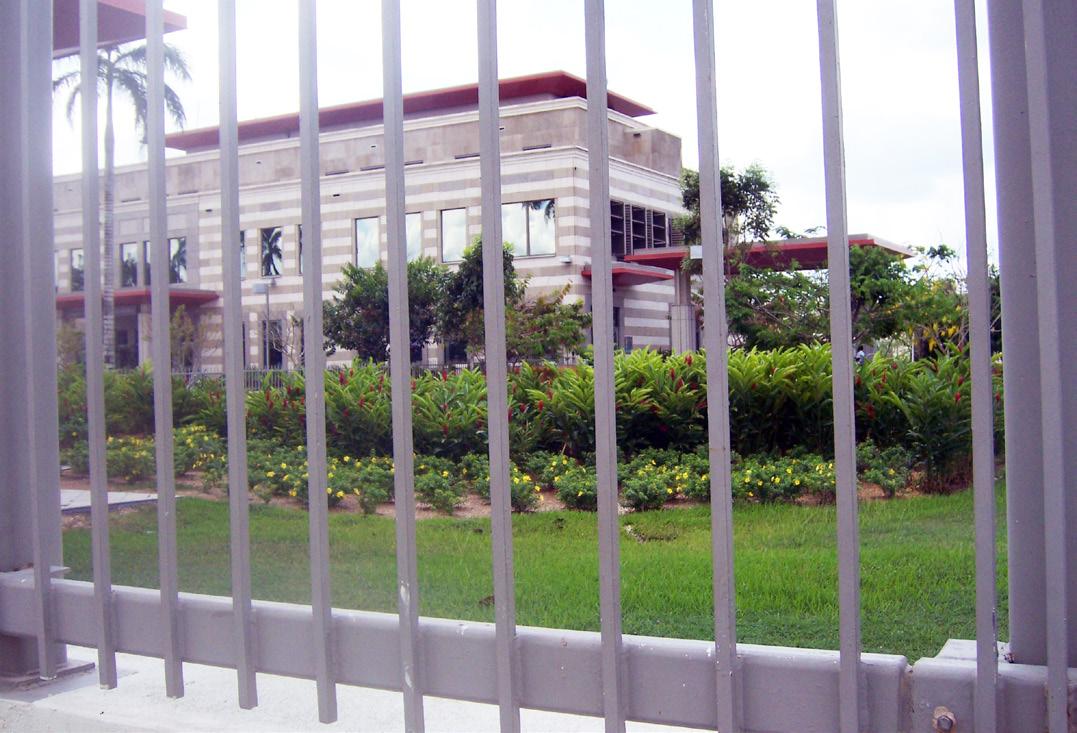


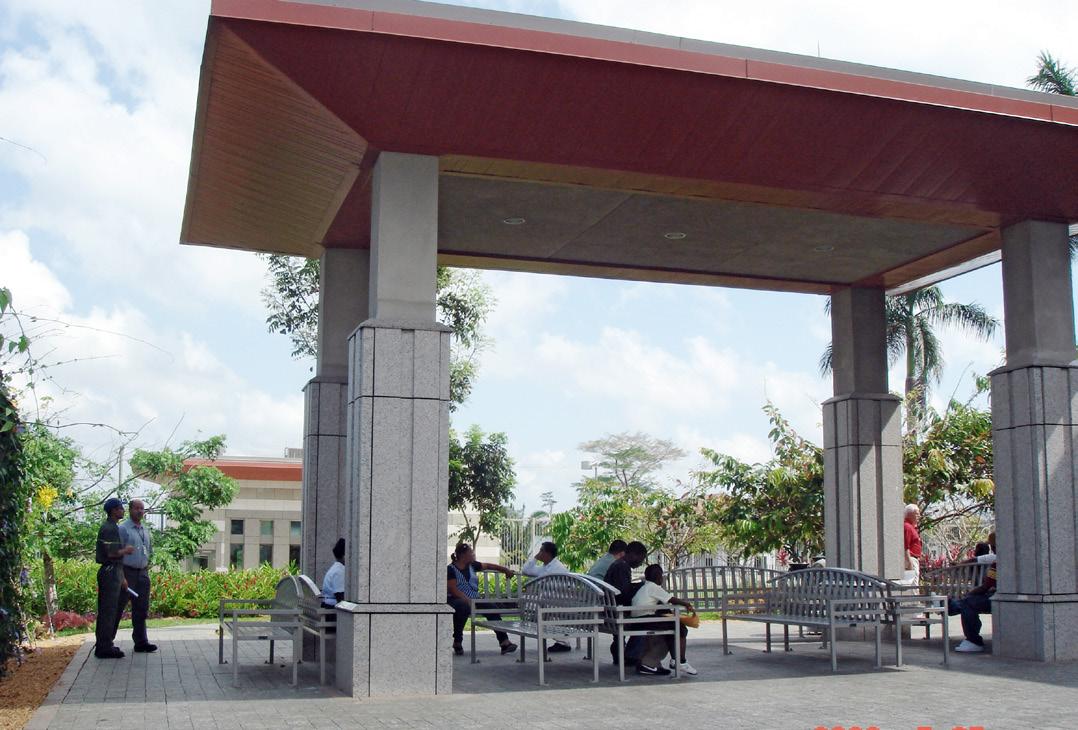



• Inadequate shelter from rain / heat. – the shelter is so tall that rain blows in under the canopy, and sun streams in as well
• Colorful consular garden is attractive, in contrast to landscape outside of the compound
• People line up, with no place to go, and no instructions are provided by the embassy. Guards are not friendly in their attitude; signage is limited, hard to read and not instructive
• It is easy to pass objects through fence

• No bus shelter for embassy staff from the host country, who often await rides at the end of the work day. Consular visitors also arrive and depart by bus or ride, and often must wait for long periods for their ride to arrive
• Parking area and car bumpers are visible from street.
• Attractive planting and signage, in accordance with OBO design guidelines

• Blank wall with no planting creates an unwelcoming streetscape
• Exposed service area presents an unattractive face to the neighborhood
• Trash and debris on public street sends a message of disrespect
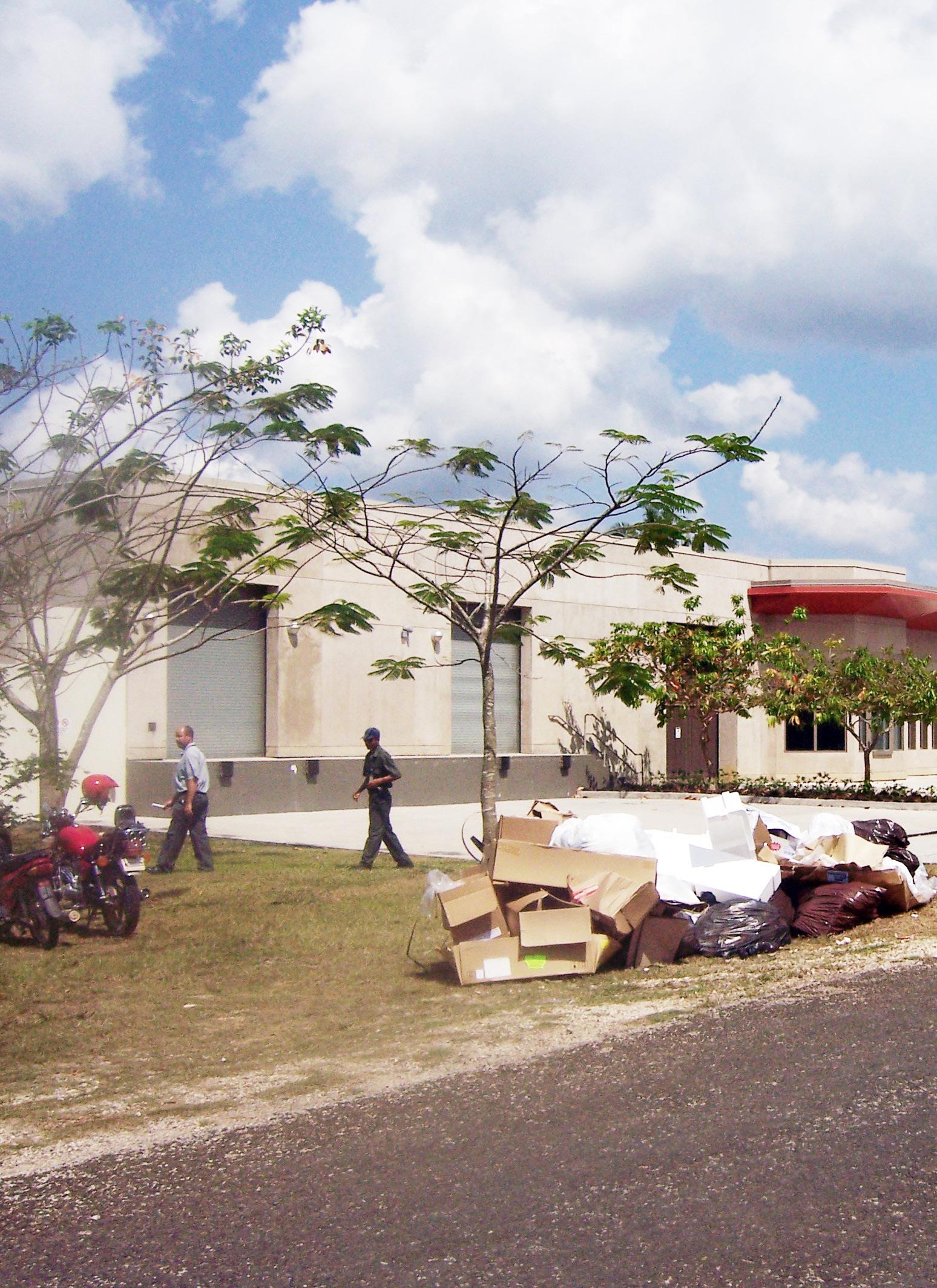
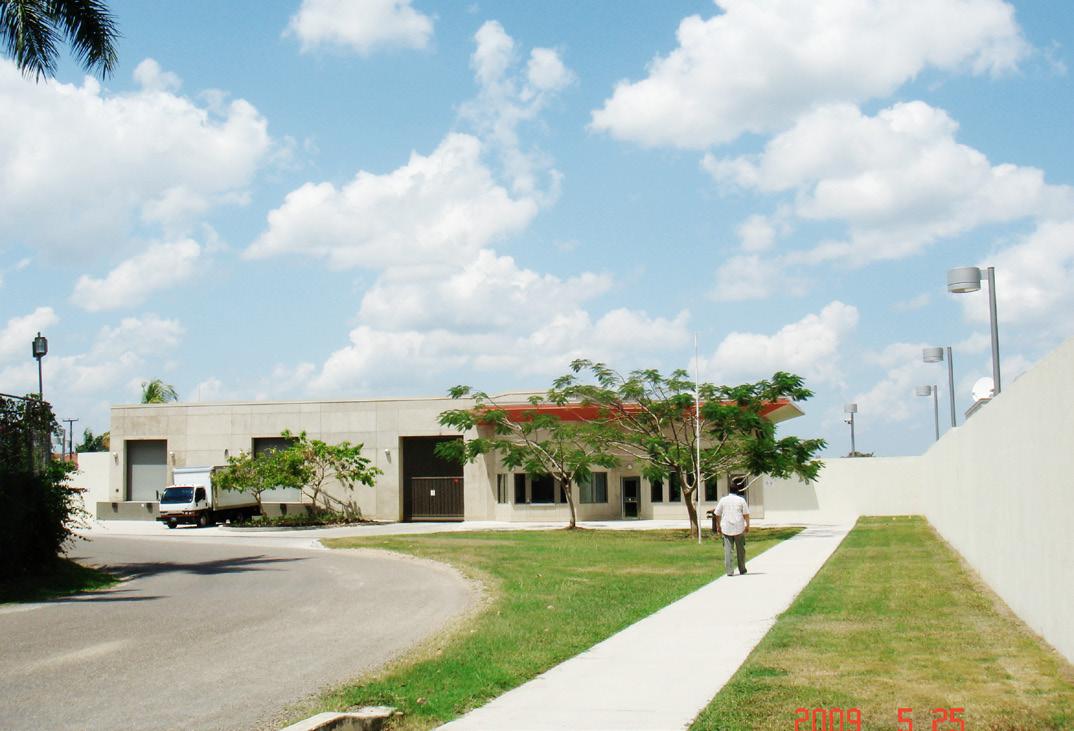
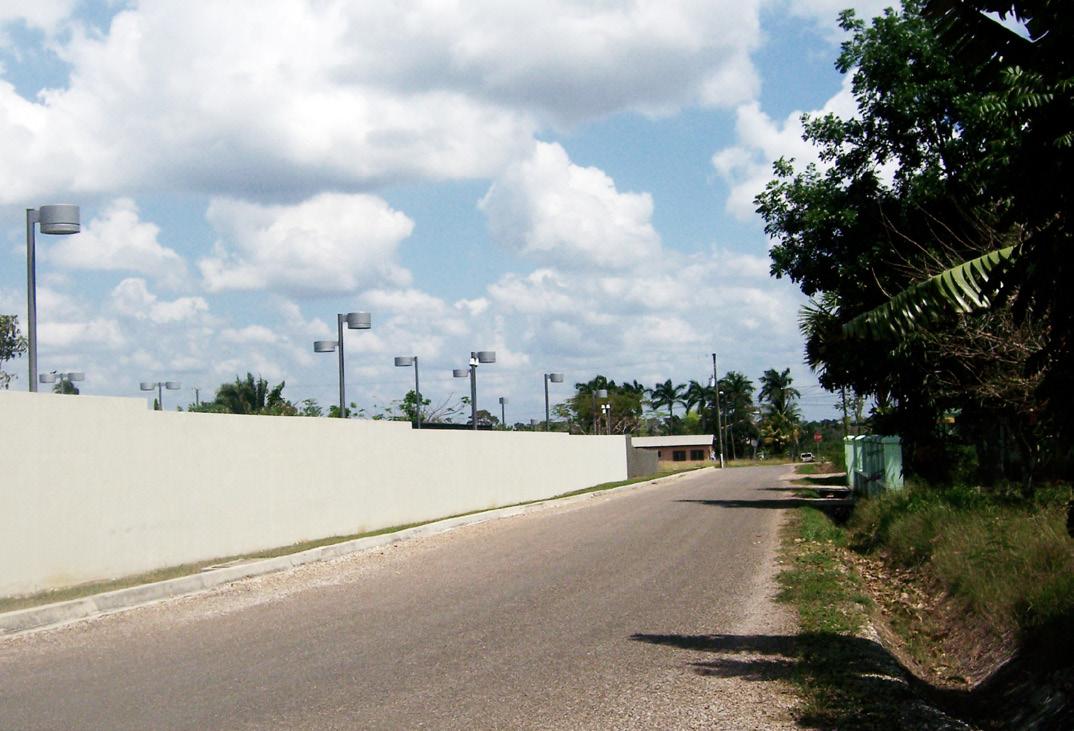
The US Embassy in Kingston, Jamaica is located on a busy thoroughfare in a dense and bustling urban area, around the corner from a residential neighborhood which abuts the compound’s service area. The site is accessed via a multi-lane road system that also serves as a bus route; the embassy compound is surrounded by an opaque wall. Problematic aspects of the embassy perimeter include tight sidewalk space, little available waiting room for consular visitors, the lack of water or bathrooms nearby, and guards that tend to be unfriendly. Embassy employees report feeling insecure as a result of crime in the neighborhood: there have been drive-by shootings in the area, and violent demonstrations occurred recently.






• Sparse plantings create an uninviting streetscape
• Sidewalks are too narrow for busy urban edges
• The embassy appears forbidding and fortress-like from the outside

• Main Entrance Pavilion lacks identity at street frontage
• Visitors and staff approach the Main Entrance Pavilion along a screened walkway with little shade
• NOB entry plaza and landscape is generally well-maintained and functional

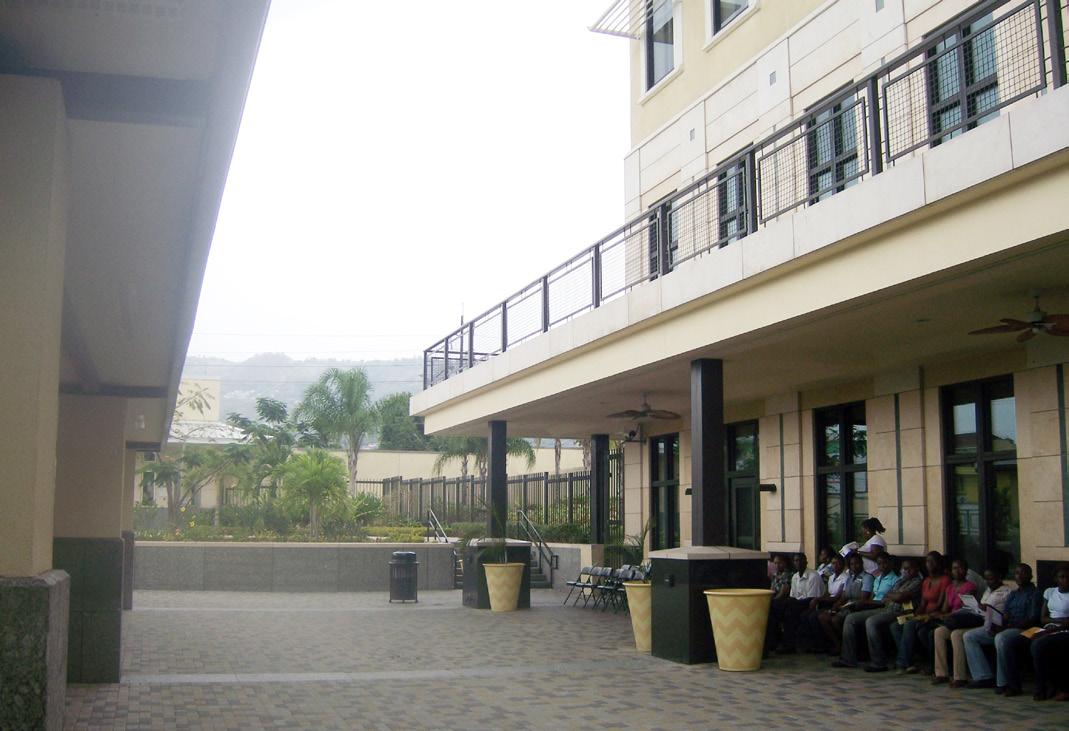
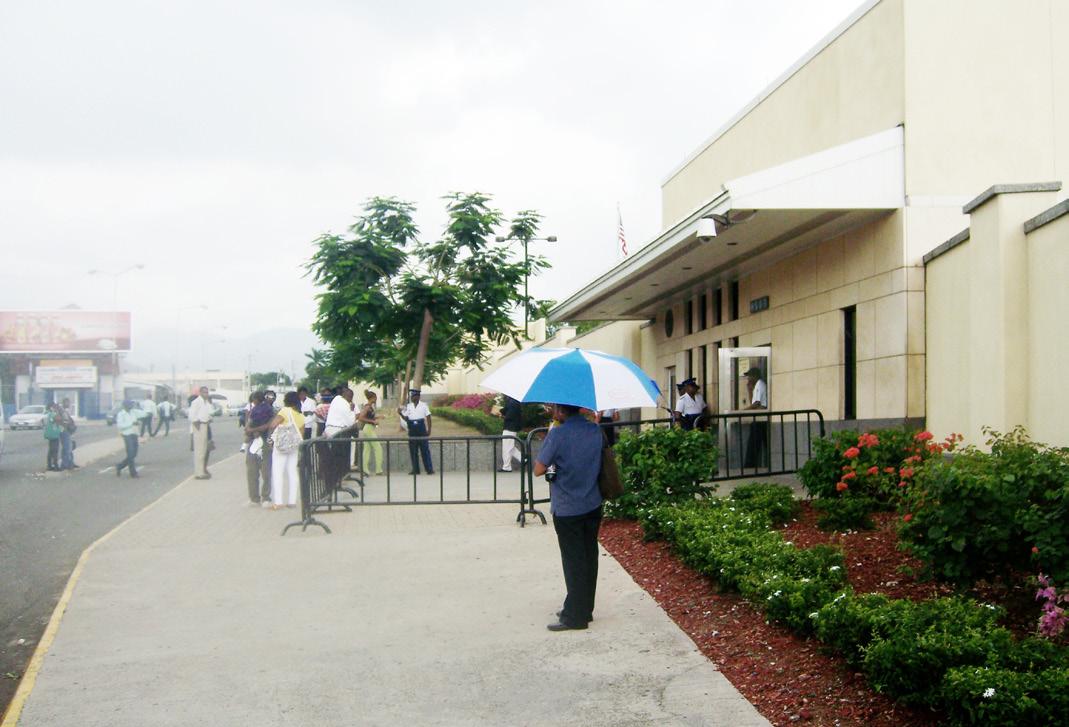




• Visitors approach consular pavilion along a narrow sidewalk with few plantings
• Consular visitors line up for “hours.”
• There is a lack of privacy
• There is inadequate shelter from rain / heat
• Guards are intimidating, not welcoming
• No information for visitors is available
• Consular garden has amenities, but does not have enough permanent seating

• Staff and visitor parking entrance appears “fortress like” on residential street
• Solid wall around staff parking screens parked cars and provides security, but imposes on the neighborhood character.
• Some neighbors appreciate the privacy provided by the walls

• Service Entrance Pavilion and service area presents a harsh utilitarian environment
• Service entrance pavilion and service area have a negative visual impact on the surrounding residential neighborhood.

The US Embassy in Sofia, Bulgaria is located in a pleasant, attractive and safe suburban setting. Thoroughfares with modest automobile traffic surround the site on two sides, while a park abuts the compound on a third side. Noteworthy features include the open fencing that surrounds the embassy, allowing for inviting views into the compound, and the comfortable, tree-lined sidewalks that permit safe and comfortable pedestrian passage. In addition, works of art by Bulgarian artists are visible to consular visitors as they enter the facility. The compound also includes a pleasant cafeteria that opens up to a rooftop terrace. Less successful aspects include the walk to the consular section which, while reasonably attractive, is very long and lacks sufficient planting and shade. Moreover, while the outdoor consular waiting area is safe and attractive, visitors do not use the benches provided since they are too far from the consular entrance door. In addition, covered space near the door is limited.


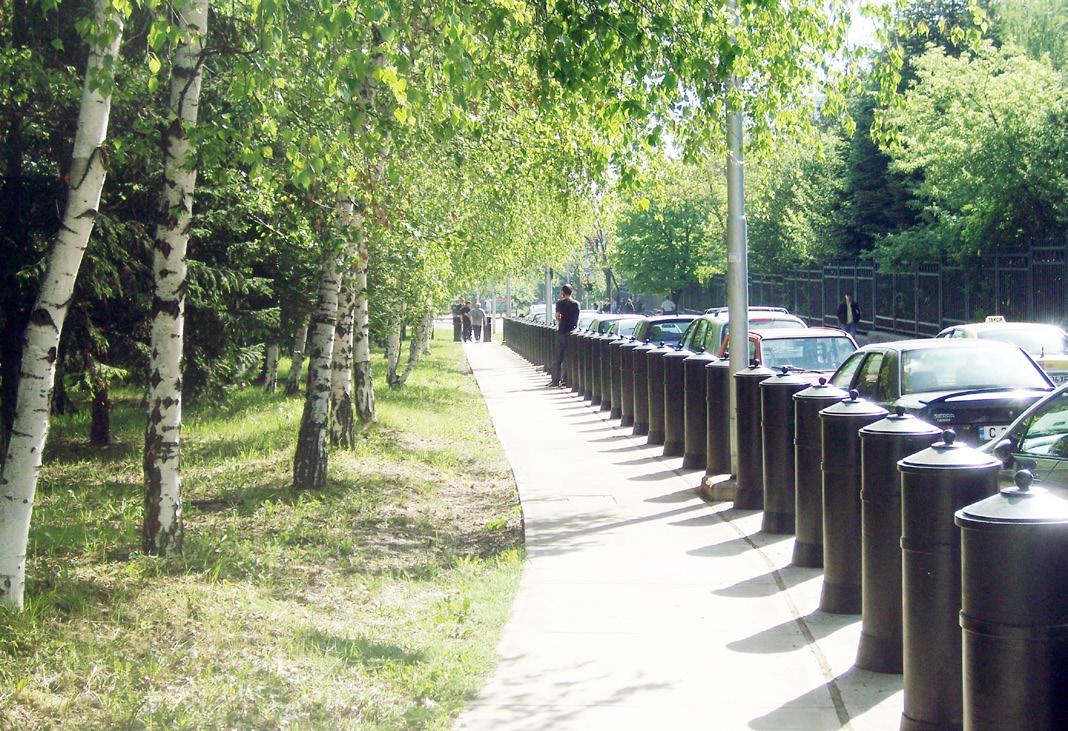
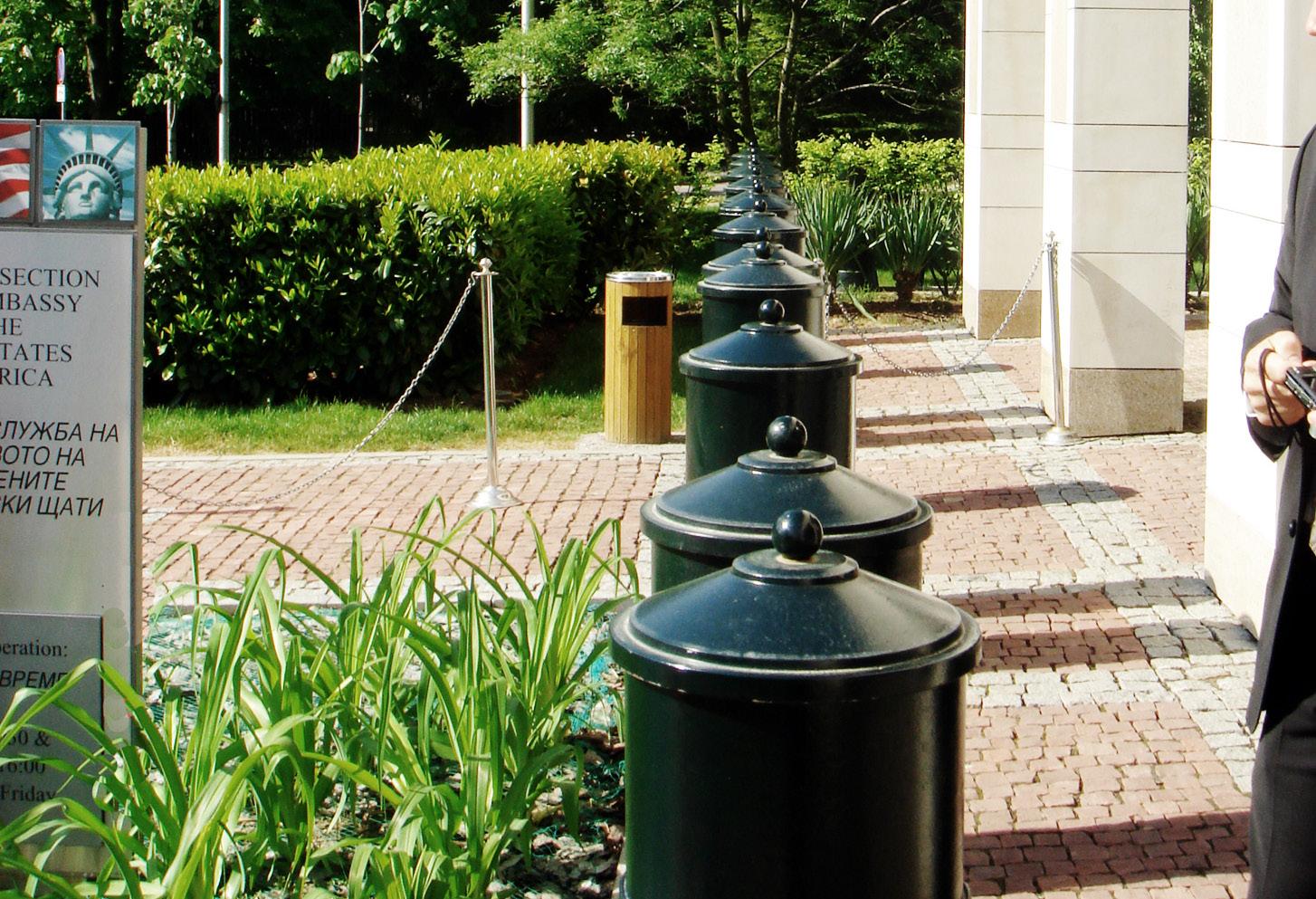

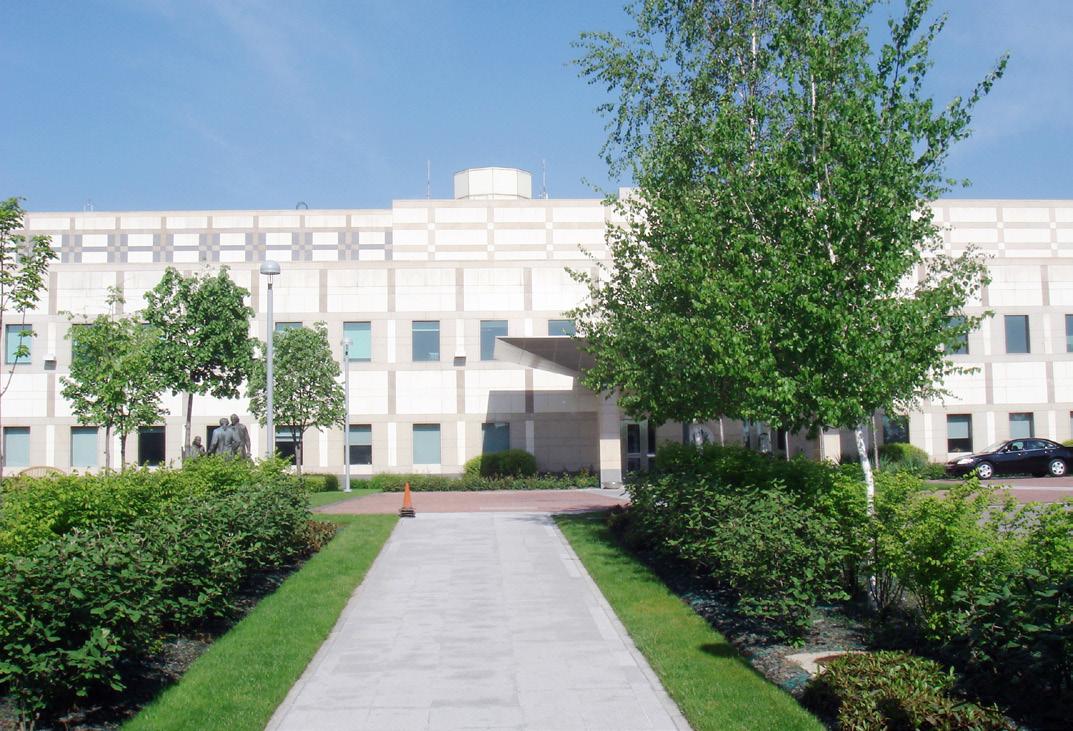
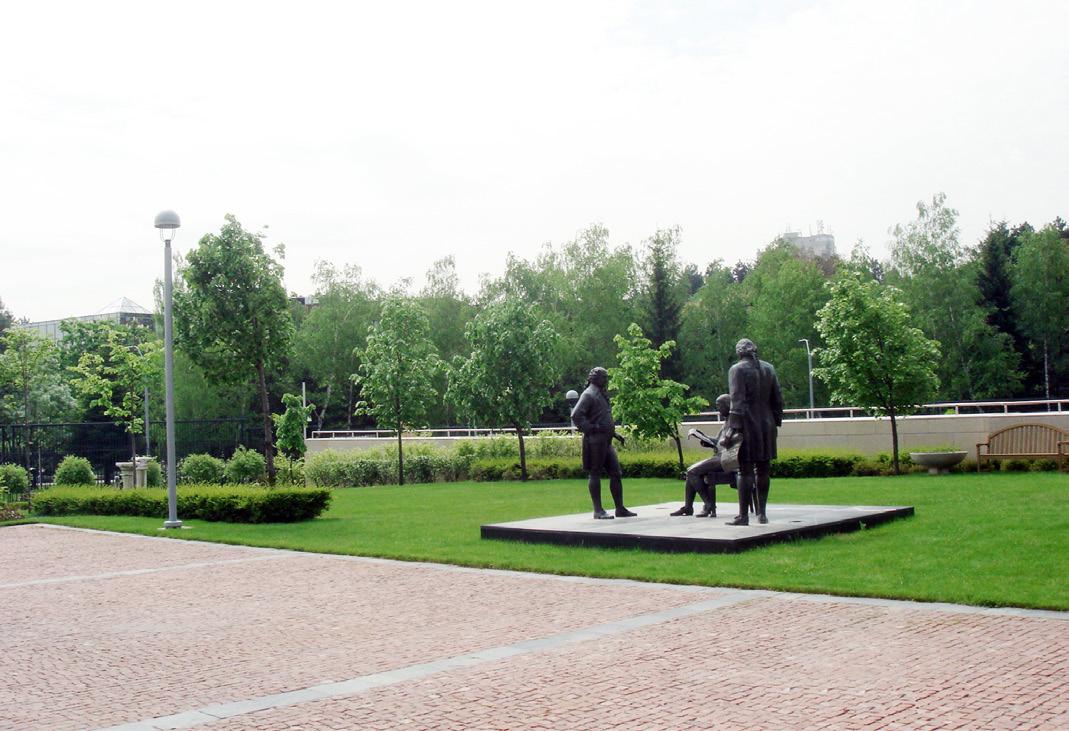

• Barriers within the right-of-way do not create public amenities, such as seating, plantings and other facilities
• Size of bollards is likely heavier than needed for angle of approach and predicted attack speed
• Views of gardens and sculpture beyond fence contribute to a positive public image

• Too many bollards give the perimeter a “heavy-handed” appearance
• Sculpture provides an element of U.S. culture and local artistry
• Plaza creates a welcoming first impression and forum for display of local craft and art
• Entrance is elegant, “friendly” and dignified representational space

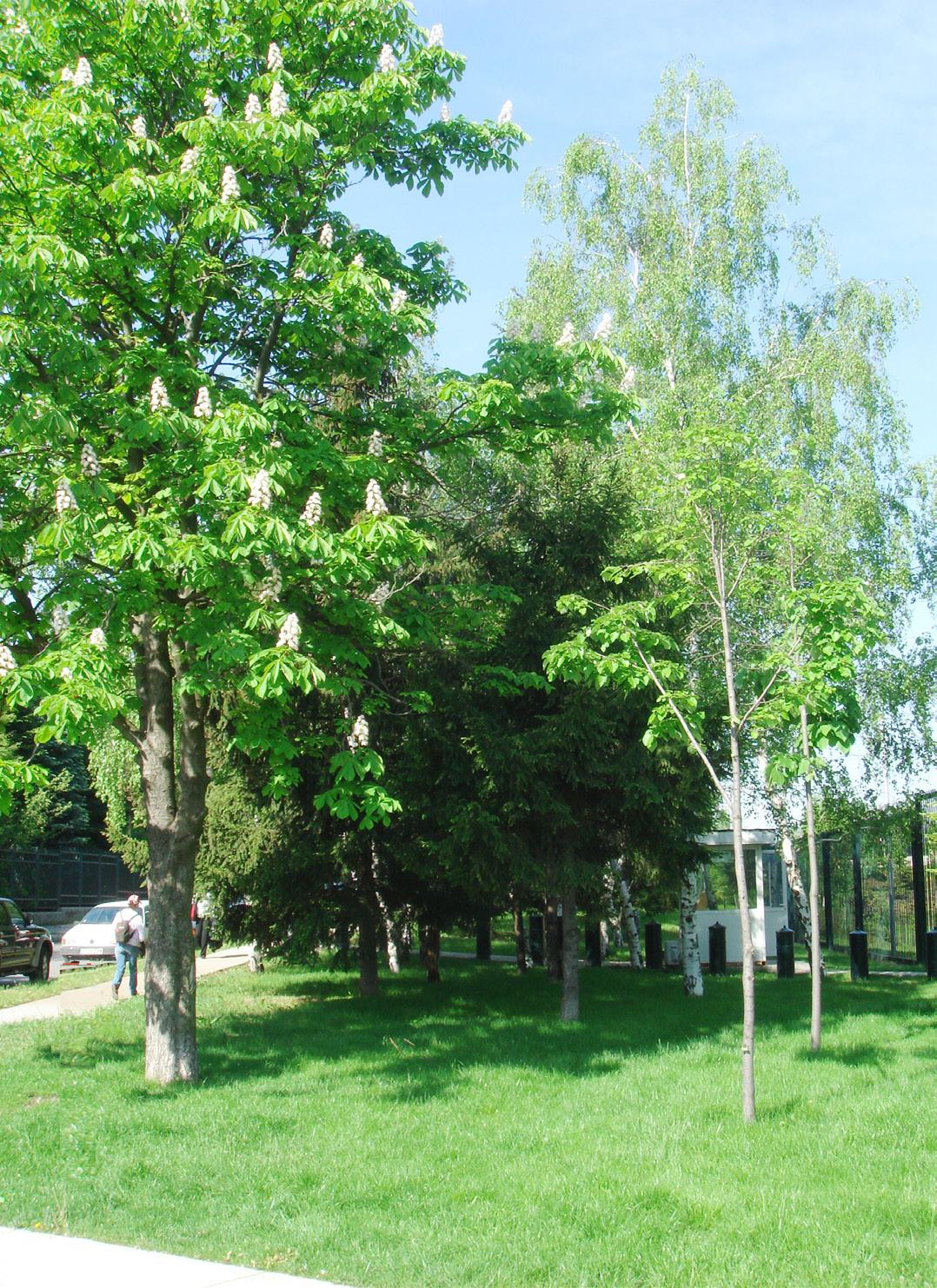



• Long distance and lack of shelter make the walk from the Consular Entrance Pavilion to the consular entry uncomfortable
• Not enough queuing space and limited shelter provided for visitors
• Seating areas are too far away from entry for convenient information exchange

• Existing trees preserved and new trees added create a pleasant buffer to the neighborhood
• Porous paving contributes to sustainable stormwater management
• Recycling bins reinforce sustainable message but screening would improve the view from the street
• Sidewalk along parking respects and preserves existing trees and creates buffer

• Service sequence acknowledges sustainable design through use of visible recycling bins and porous paving in parking areas
• Fencing along the edge provides minimal screening, causing service functions to be very visible from the adjacent neighborhood
• Driveway throat to service area is very wide and adds to the difficulty in screening the service area

The US Embassy in Athens, Greece is located along a heavily trafficked thoroughfare in a densely urbanized area of Athens. It is surrounded on two sides by an urban street edge, while small urban park spaces abut the compound on the other two sides. The main entrance fronts a busy urban street with heavy bus and truck traffic. A new consular entry pavilion and the main vehicular entry to the site are located on a quieter side street. The consular entry leads to the embassy’s consular section, which is located on an upper level due to the sloping terrain and is accessed via steps and ramps. Visitors to the embassy arrive by automobile, motorcycle and public transportation. Designed by Walter Gropius and respected for its original architecture, the embassy, completed in 1961, has in more recent years been the target of terrorist attacks and demonstrations. As a result, the embassy compound and perimeter have been modified and expanded incrementally over time. Following a riot that led to the storming of the embassy, heavy fencing was added to the perimeter. In addition, other security has been added in increments over time. While a group of the few remaining olive trees from the original design lend beauty and green to the compound, much of the perimeter creates a poor visual impression. Along the street fronting the main pedestrian entry, the sidewalk is lined by heavy planter boxes and trees—green, but not attractive. The adjacent city park, while not part of the embassy compound, is poorly maintained and leaves a poor impression nonetheless. An attractive urban park along the fourth edge provides relief and a welcoming setting, however, extensive motorcycle parking at the end of the street intrudes on the pleasant atmosphere.

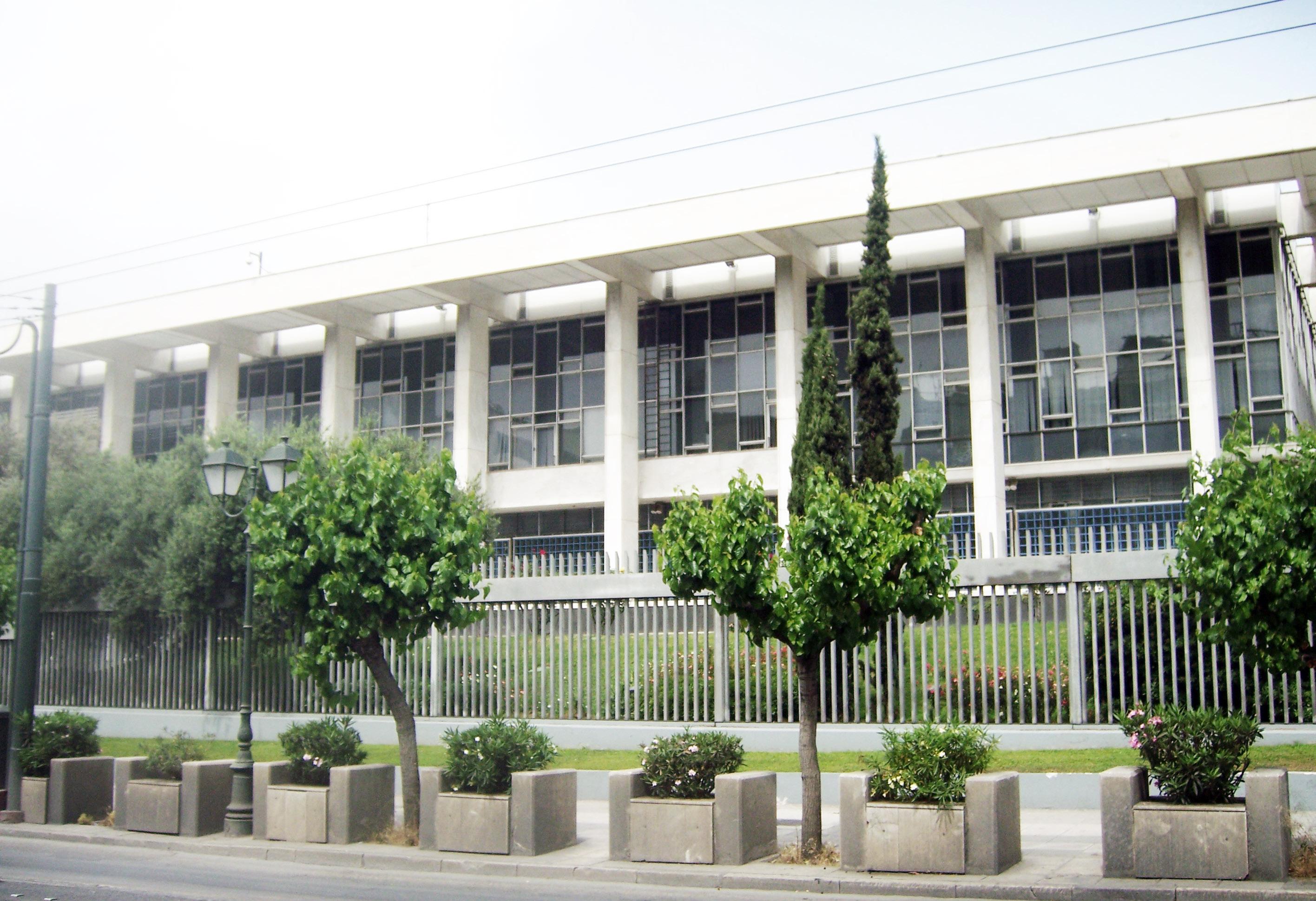

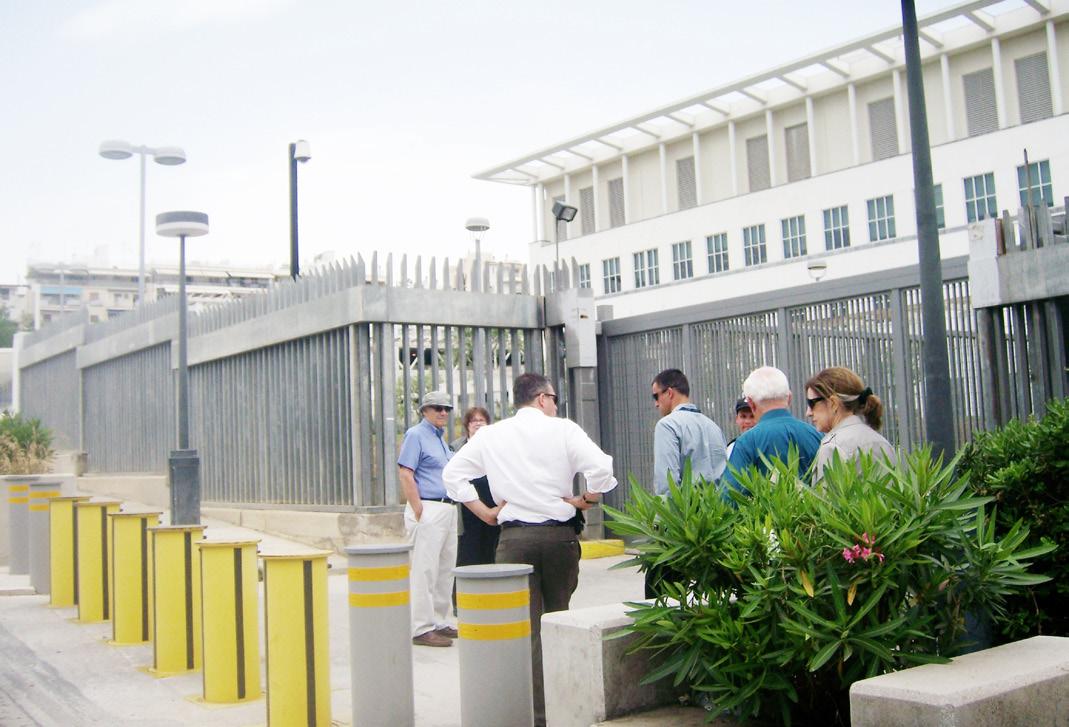



• From the street, the appearance of the fence is softened by tree canopies, but barriers and planters within the right-of-way are heavy
• At the main pedestrian entrance, access on foot is convoluted due to grade changes between the compound and the sidewalk
• A few olive trees, left from the original 1961 installation, help create a green edge at one corner of the site
• The adjacent city park looks as though it is associated with the embassy, but is in fact an infrequently maintained city property and is not an attractive addition to the embassy perimeter

• Small, awkward pedestrian approach w/ heavy fencing on both sides
• Multiple layers of fencing make a prison-like vehicle entry experience
• Along the approach to the main entry, the heavy fencing obscures view of the grounds and is not in scale with the building
• The linear park is a positive urban amenity adjacent to the embassy; though it is on the service side of the compound, it begins along the main thoroughfare and is an important perimeter element


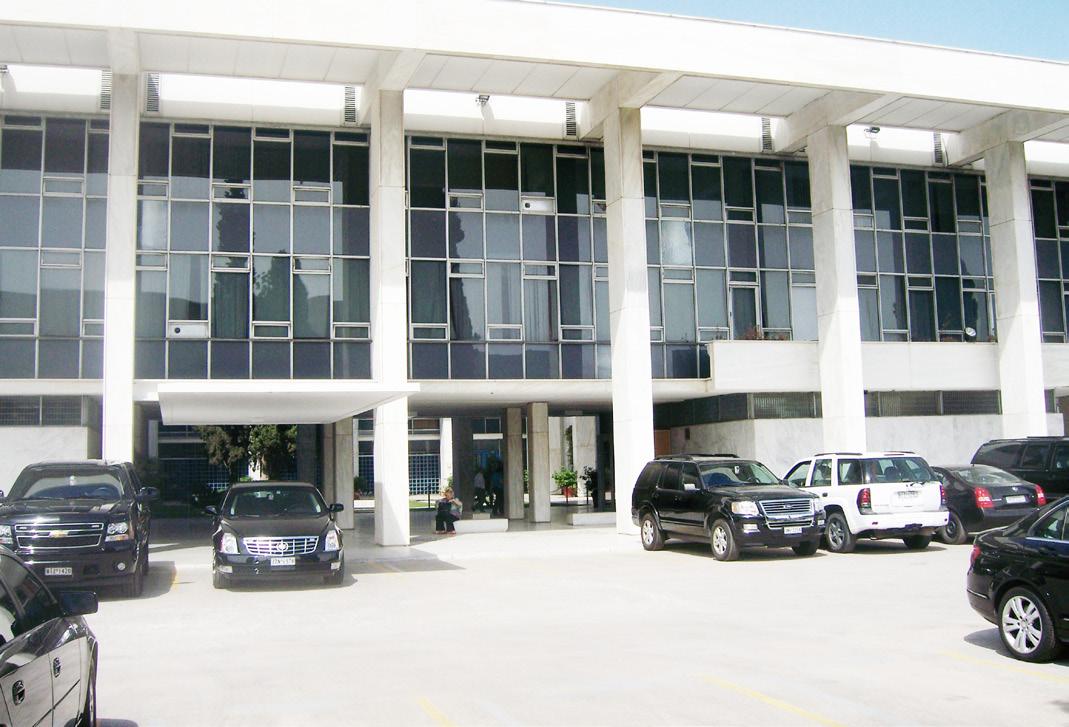




• Consular entrance is unwelcoming, with steep steps along the sloping walk, resulting in very little room to receive visitors as they approach from the street; there is very little informational signage
• The paved triangle between streets outside the consular entrance is quite bare and could be treated with plantings to make a more attractive approach
• Once the visitor passes through security screening, a consular ‘bridge’ provides attractive views of the grounds, and exterior artworks, but the terrace offers no seating and, although shade is available on the north side of the building, there is little shelter

• Fencing is heavy and prison-like along the street fronting the main pedestrian entry
• Surface parking at building approach detracts from architectural character
• Along the street, the walk is harsh and uninviting since there is limited planting and the sidewalk is very near the perimeter wall for much of its length
• Fencing, gates and lanes entering parking structure are simple in design, straightforward and clear, but not inviting as a workplace destination

• Service entrance pavilion is highly visible, additional ad-hoc barriers control parking and exacerbate chaotic and bare appearance
• Service area is very visible to street, without screening
• Considerable motorcycle parking and broad, unshaded, paved areas increase the harsh appearance at this edge



The primary threats that must be considered in the perimeter design of a U.S. Embassy compound are entrance of unscreened vehicles and pedestrians. Vehicular control is provided through perimeter anti-ram elements and pedestrian control is provided through perimeter anti-climb elements. These physical barriers are supplemented by operational security measures. This Appendix focuses on the site specific determination of the anti-ram threat and associated risk to the protected buildings.
The anti-ram perimeter of the site shall be an integrated system of fixed and operable barriers designed to work with the surrounding geography and the natural landscape. Design of the barrier system depends on a number of factors including layout of the site and surrounding streets, adjacent properties, location of protected buildings, vehicle access points and potential for future development. The following sections explain the baseline anti-ram threat and describe the steps to establish site specific vehicle approach speeds and the issues to consider in developing an integrated solution.
The baseline anti-ram threat is established in the OBO-ICS documents. Two major parameters are used to define the anti-ram threat: vehicle weight and vehicle speed. Together these parameters define the magnitude of force imparted to the barrier during vehicle impact and may be combined into a single parameter, kinetic energy:
Kinetic Energy (KE) = ½mv2
= ½ x Vehicle Weight x (Vehicle Speed)2
U.S. Department of State Diplomatic Security has defined the attack vehicle weight for all embassy compounds to be 6,800 kg (15,000 lbs). Attack vehicles are also assumed to achieve a maximum ramming speed of 80 km/h unless actual vehicle approaches do not allow vehicles to attain this speed.
A third parameter, penetration distance, is used in conjunction with the anti-ram threat to define the anti-ram criteria. The penetration distance defines the distance a vehicle is able to penetrate beyond a barrier. Since unsecured vehicles may carry a Vehicle Borne Improvised Explosive Device (VBIED), the penetration distance is directly related to the risk of damage to the protected buildings. A greater penetration distance reduces the setback distance between the VBIED and the protected buildings. The baseline maximum penetration distance as established by DOS is 1 meter. This limit ensures that a VBIED, which is assumed to be located in the cargo bed of the attack vehicle, will not cross the anti-ram perimeter and validates the setback distances assumed for blast design of the buildings.
Test methods and certification standards for anti-ram barriers are specified in ASTM F2656, Standard Test Method for Vehicle Crash Testing of Perimeter Barriers. DOS transitioned to this ASTM standard in 2008 from the previous standard, SD-STD-02.01, Revision A, Test Method for Vehicle Crash Testing of Perimeter Barriers and Gates, dated March 2003. There are a number of differences in both test methodology and nomenclature between these two documents.
Since ASTM F2656 is intended to be applicable to a wide range of anti-ram criteria, it defines multiple vehicle types and associated weights, vehicle speeds and penetration distances. Within the ASTM standard, the medium duty truck (M) corresponds to the 6,800 kg vehicle utilized for embassy design. Barriers that are capable of resisting the medium duty truck (M) traveling at the maximum specified velocity of 80 km/h (50 mph) are assigned an M50
“condition designation,” or crash rating. Similarly, barriers capable of resisting the medium duty truck traveling at 65 km/h (40 mph) or 50 km/h (30 mph) are assigned an M40 or M30 crash rating, respectively.
The old SD-STD-02.01, Revision A standard defined similar crash ratings, but utilized different designations. For instance, the ASTM designated M50 crash rating was referred to as a K12 crash rating in the older SD-STD-02.01 system. The K12 designation referred to the kinetic energy of the vehicle impact, which is just over 12 x 105 ft-lbs for the associated vehicle weight and speed. See the table provided for a summary of the standard crash rating designations in both the current ASTM F2656 standard and the older SD-STD-02.01 standard.
It is important to note that the industry is evolving and that terminology from the new ASTM standard is not always utilized. Both commercial vendors and recent OBO-ICS documents often provide barrier crash ratings in terms of the older K rating standard. While barriers previously tested under the SD-STD-02.01 standard may still be considered for use at U.S. embassies, such barriers must be reviewed and approved by DOS. A current list of approved barriers for overseas facilities is maintained by DOS and may be requested at the time of need.
Multiple penetration ratings are also specified in ASTM F2656. To meet the 1 meter baseline penetration distance requirement, a P1 rating must be achieved. The SD-STD-02.01, Revision A standard required a maximum 1 meter penetration distance in all cases and therefore did not have a penetration rating designation; however, the original SD-STD-02.01 standard did differentiate between multiple penetration distances. For this document, a rating of L3 corresponded to a maximum 1 meter penetration, whereas a rating of L1 or L2 corresponded to greater penetration distances. It is important to be aware of the penetration distance rating for commercial barriers tested under either the ASTM F2656 standard or the original SDSTD-02.01 standard. Barriers tested under the ASTM F2656 standard and approved by DOS carry a crash rating indicating all three parameters indicated above, such as M50 P1 or M30 P1 depending on the impact speed.
Barrier Analytical Model:
Example Modification of M50-P1
Tested Anti-Ram Knee Wall for Site-Specific Application
DOS has crash-tested numerous fixed (passive) barrier systems, including bollards, walls and planters, to demonstrate compliance with the noted standards. Many of these tested barriers are provided to the Design Team in the OBO-ICS to the IZC, Appendix A, Security Details for Site Construction. While more recent testing has considered slower attack speeds, the majority of barriers currently included in the OBO-ICS were developed for an 80 km/h attack speed with a maximum 1 meter penetration distance. Inquiries to Diplomatic Security during early phases of design may provide the Design Team with more fixed barrier options than appear in the SED documents.
An analytical approach to design of anti-ram barriers may provide an estimate of the crash rating, but shall only be used where site specific implementation of a barrier system requires modification of a tested assembly. As an example, conditions where the grade steps down at an anti-ram knee wall (from the attack side to the protected side) typically require a modified barrier design to account for the greater overturning effect. If testing for the site specific application is considered unreasonable, analytics could be used to demonstrate a modified version of a tested barrier is sufficient. In all such cases where analytical solutions are considered, approval of DOS will be required.
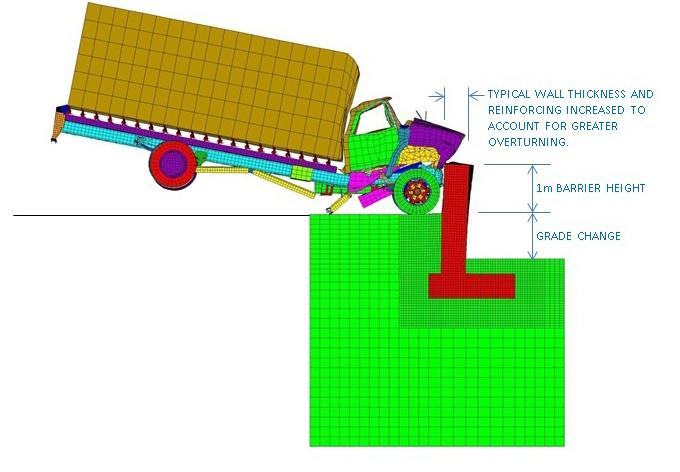
Typical wall thickness and reinforcing increased to account for greater overturning
The first step in the anti-ram system design process shall be a site survey. The survey shall record the geometry of the surrounding streets, noting the street widths and including any roadways that approach the site, the slope of the surrounding terrain, the use of surrounding properties and permanent construction on the surrounding properties. These parameters may then be used to determine the sides of the compound that are vulnerable to a moving vehicle attack and will assist in determining the maximum vehicle approach speeds. It may also become clear that some portions of the perimeter are not vulnerable to a moving vehicle impact due to either existing terrain, such as extreme slopes or forested areas, or adjacent occupancies. Careful attention shall be paid to the surrounding properties and their potential for turnover or adapted use since vehicle approach speed calculations often assume occupied properties are inaccessible by vehicle traffic.
Potential locations of vehicle access points shall also be identified. Since barriers at these locations are operable and integrated with the Consular Access Pavilion designs, greater options may be available for reduced speed barriers and site design to limit approach speed.
The layout of the site, both inside and outside the Embassy compound, will help guide the location of the anti-ram perimeter. While the location of the protected buildings must provide a minimum setback distance of 30 meters to the property line and anti-ram perimeter, greater separation between the buildings and the property line allows for flexibility in location of the perimeter barriers. For example, if the protected buildings are setback from the property line by 40 meters at one side of the site, barriers may be placed up to 10 meters interior to the property line and still achieve the required 30 meter minimum setback. This flexibility allows for both optimization of barrier locations, to coincide with natural barriers such as rock outcroppings or reduce attack speed for example, and freedom to manipulate the path of the anti-ram perimeter. On the other hand, setback is a very effective countermeasure and should not be given up lightly. Any reductions in maximum achievable setback distance must be balanced with increased costs for building hardening and the potential for future site development in which additional setback distance could be a valuable commodity.
It is also important to determine the location of existing below grade utilities in advance to avoid potential conflicts with barrier foundations. While utility lines running perpendicular to barrier foundations may often be encased or bridged over by the barrier foundation, shallow utility lines running parallel to barrier foundations can be more difficult to deal with. Operable barriers, such as wedge barriers, are commercially available in
shallow foundation and surface mount variants that can sit above fairly shallow below grade utilities, but not all of these systems achieve the required P1 (1 meter) penetration rating. Numerous M50 and M30 P1 rated shallow foundation fixed barriers have been recently added to the OBO-ICS for design team use, but most require a minimum 450 mm foundation depth or greater. It is therefore often advantageous to offset barriers from existing below grade utilities that run parallel to the property line as long as the required setback is still achieved.
The maximum specified 80 km/h vehicle approach speed may be conservatively used for selection of all perimeter anti-ram barriers where a vehicle approach speed study is not conducted. However, if a vehicle approach speed study is integrated into the barrier design process, slower peak speeds are likely to be determined along a majority of the perimeter. The actual peak speeds would then be utilized in sizing the perimeter anti-ram elements, which may allow for use of M30 or M40 barriers in lieu of M50 barriers at locations identified to have slower peak impact speeds. An approach to performing speed calculations is provided in the U.S. Department of State, Perimeter Barrier Selection Guide, dated May 1989, as well as the more recent United Facilities Criteria (UFC), Selection and Application of Vehicle Barriers, UFC 4-022-02, dated 8 June 2009. Either of these documents can be used to help determine the maximum attack speeds at all locations around the site perimeter. New methods of calculating vehicle approach speed are also in development at this time. Contact DOS for the latest methodology at the time of specific project design.
The main factors that may yield a reduced vehicle approach speed are slope, ground surface material and curvature of the drive path. The noted guides provide information on vehicle acceleration and speed gain over a given distance for various slopes as well as maximum speeds at a specified turning radius for variable surface friction coefficients. While a paved surface will offer a fairly high friction resistance, a non-paved surface will have a lower coefficient of friction, causing a vehicle to skid at less shallow turning radiuses. A steeper slope upwards will also limit achievable vehicle speed. Note that the UFC guideline indicates a faster acceleration rate for medium duty trucks than the older DOS guide and is recommended for use in calculating vehicle speeds unless current manufacturer technical data is available.
As an example, consider a simple rectangular site bounded by orthogonal roads, as shown. Assuming the roads stretch into the distance, vehicles will have sufficient space to attain high (80 km/h) speeds. At the corners of the site, a vehicle can crash into the site perimeter with minimal turning and can therefore maintain an 80 km/h impact speed along an approach path more or less directly (perpendicular) towards the perimeter. Along each side of the site the vehicle can still achieve an 80 km/h mph speed, but must either reduce speed to turn into the perimeter wall or accept a higher speed impact at a very shallow angle, which will result in a less hazardous, glancing blow. In either case, the equivalent impact speed (calculated as the vector component perpendicular to the site perimeter) will be significantly reduced.
In this example the width of the road will also affect the impact speed. A wider road will allow for a wider turning radius and a more direct impact, whereas a narrow road will limit the turning radius and associated impact speed. As noted, the designer must also be careful to consider the current and potential future use of the adjacent property if it is assumed that the vehicle cannot use this property to attain a higher speed, wider turning radius or more direct approach path. A situation where future upgrades to the anti-ram perimeter are required due to occupancy changes of adjacent sites is not desirable.

Analysis of existing site conditions is a simple method to justify a reduced design attack speed and thereby allow a smaller anti-ram barrier to be used. Where site conditions do not justify such a reduction or where further reduction is desirable, attack speeds may be reduced by designing and engineering the site to limit high speed approach paths.
A number of options are available to limit the potential impact speed of a moving vehicle. The following options will not be applicable to all sites, but can be used in varying combinations based on overall site design:
• Reduce width of approach paths
• Incorporate serpentines or curved paths into vehicle approach
• Utilize ditches and/or berms
• Locate barriers within non-paved zones to reduce skid resistance
Reducing the width of approach paths will limit the turning radius for a vehicle traveling parallel to the perimeter prior to making impact. Such an approach is shown schematically in the diagram provided. For vehicles traveling parallel to the site perimeter at 80 km/h along a paved surface, a road width of roughly 20 meters will limit the equivalent impact speed to 65 km/h, whereas a road width of roughly 10 meters will limit the equivalent impact speed to 50 km/h. As a rule of thumb, decreasing the road width by a factor of 2 will decrease the anticipated impact speed by a factor of 25% plus or minus.
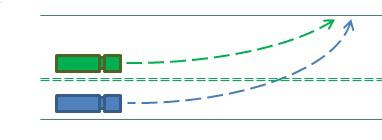
Incorporating curves into the vehicle approach may alternatively limit the maximum vehicle speed, even if a perpendicular attack is possible. This is possible through utilizing curved roads or serpentines. As an intermediate option, a partial serpentine is shown in the diagram provided. Such a layout could reduce vehicle speeds from 80 km/h down to 50 km/h by limiting the turning radius in at least one part of this curve to 20 meters. Note that straightaways after the curve will allow the vehicle to regain some of the speed loss and must be considered.
Vehicle access points are another opportunity to force vehicles to reduce speed prior to reaching the operable anti-ram barriers at Consular Entrance Pavilions. For instance, vehicle entrances can incorporate sharp turn offs from the perimeter roads that will negate a high speed approach and allow an M30 barrier to be used. Such a turnoff must account for the potential of traffic coming in either direction, even on a one-way street.

Although slower speeds may be calculated for portions of the antiram perimeter as described, the majority of currently available fixed barriers designed for speeds slower than 80 km/h must be purchased from a specialty contractor. However, commercial barrier systems are more expensive and are primarily used for operable barriers due to the expertise they require from the manufacturer. Fixed barriers may be constructed by non-specialty contractors, which are often more cost effective and therefore preferable.
Since the available M50 fixed barriers that have been tested by DOS are generally 1 meter high and have an imposing appearance, it is important to develop lighter, shorter barrier systems designed specifically for reduced vehicle speeds. Given typical road widths, barriers designed and tested for M40 and M30 ratings would be particularly useful, and would help enhance site visual quality while still providing an appropriate level of protection. At the time of this report, DOS is in the process of testing barriers for 50 km/h speeds (M30 rating), which will provide more options to the Design Team. One such barrier that has recently been successfully tested to achieve an M30 rating utilizes a 300 mm thick knee wall with a height of roughly 860 mm. Further reductions in height and girth may be forthcoming and the Design Team is encouraged to inquire with OBO and Diplomatic Security about the most recent developments in barrier testing.

DOS standards and criteria can and will change over time, since research into perimeter security is ongoing. It is the A/E’s responsibility to be aware of these changes. Designers must adapt and incorporate new security requirements into each new perimeter design. Updated criteria are available from DOS.
2011 OBO International Code Supplement (OBO ICS)
2011 OBO International Zoning Code Supplement
OBO Consultant Contract, project specific for each US Embassy Project
OBO Site Lighting Design Guidelines
OBO Site Signage Design Guidelines
Crash Test Standards
ASTM F2656-07 (or latest edition), Standard Test Method for Vehicle
Crash Testing of Perimeter Barriers
Analysis Techniques
UFC 4-022-02, Selection & Application of Vehicle Barriers, June 2009
Certified Barriers
Overseas Buildings Operations-International Code Supplement (OBOICS), OBO Supplement to 2006 International Zoning Code (IZC), Appendix A, 2011 (or latest version)

ADA and ABA Accessibility Guidelines for Buildings and Facilities, Parts II (ABA Appendices F1 and F2) and III (Technical Chapters 3 through 10), The Access Board, July 23, 2004.
http://www.access-board.gov/ada-aba/index.htm
American Society of Landscape Architects, Architect of the Capitol, US Botanical Garden: Sustainable Sites Initiative; 2010
Davis Brody Bond/Aedas and Rhodeside & Harwell; Embassy Perimeter Improvement Concepts (EPIC) Interim Report Draft; June 2010 (Consultant Team Trip and Charrette Report)
OBO-ICS, ICZ, Appendix A ‘Security Details for Site Construction’
OBO Policy and Procedures Directive, PE/DE 07 Barrier-Free Accessibility, Appendix D OBO Standard Criteria (with references to Americans with Disabilities Act [ADA] Guidelines)
US General Services Administration, Public Buildings Service, Office of the Chief Architect; ‘The Site Security Design Guide’; Washington, DC; June 2001
US Green Building Council; Leadership in Energy and Environmental Design (LEED) v3; April 2009
ASTM F2656-07 (or latest edition); Standard Test Method for Vehicle Crash Testing of Perimeter Barriers; 2007
SD-STD-02.02; Revision A, Certification Standard— Test Method for Vehicle Crash Testing of Perimeter Barriers and Gates, March 2003
United Facilities Criteria (UFC); Selection and Application of Vehicle Barriers [UFC 4-022-02]; 8 June 2008
Risk & Threat Analysis Techniques
UFC 4-022-02, Selection & Application of Vehicle Barriers; June 2009
US Department of State; Perimeter Barrier Selection Guide; May 1989

Bureau of Overseas Building Operations (OBO)
Project Manager:
Alain C. deVergie, FASLA, Landscape Architect
Chief, Architectural Division:
Patrick W. Collins, Architect
Team Members
Tetsuya Yamamoto, Landscape Architect
James J. Geraghty, Architect, Physical Security
Patrick R. Foster, Architect
Robert T. Jeter, PE, Civil Engineer
Luther D. Miller, Architect
David J. Hammes, Architect
Bureau of Diplomatic Security
Donald L. Moffett, PE Research Engineer
Russell J. Norris, PE Research Engineer
Jacqueline Murray, Physical Security
With thanks to the Chief of Mission, Deputy Chief of Mission, RSO and GSO at the US Embassies of Belmopan, Belize; Kingston, Jamaica; Sofia, Bulgaria; and Athens, Greece.
Rhodeside & Harwell
Landscape Architects and Planners
Faye Harwell, FASLA
Kevin Fisher
Theodore Wilger
Stacilyn Feldman
Annette Whitehurst
Eric Feldman
Meredith Judy
Davis Brody Bond Aedas Architects and Planners
Christopher K Grabé, FAIA
Khania Curtis
Ron Ellis
Dylan Jhirad
Weidlinger Associates Consulting Engineers PC
Peter DiMaggio
Douglas Heinze
